Looking to learn about some of the weirdest animals in the world? You’re in the right place. In this post, we’ll talk about weird and fantastic mammals, birds, bugs, reptiles, and more! And of course, we have tons of great photos and videos.
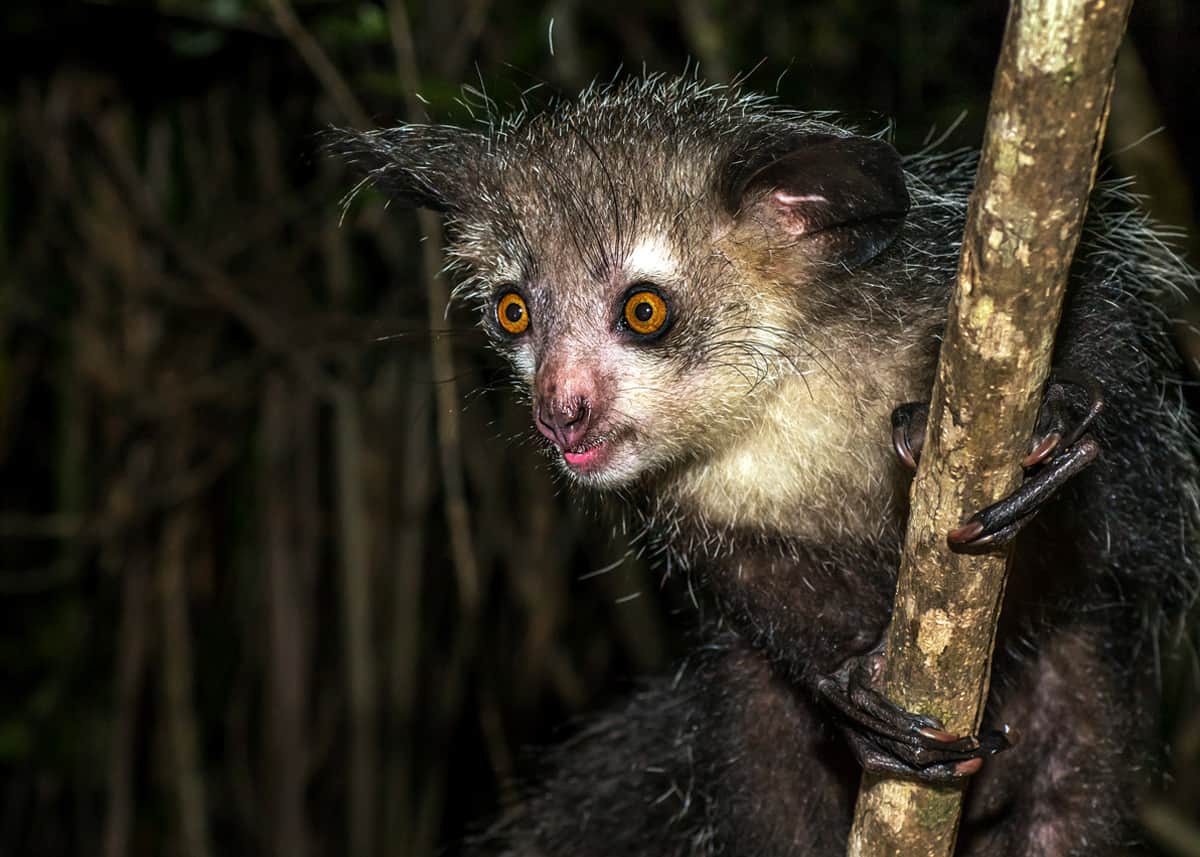
Table of Contents
69 Strange and Weird Animals
Our planet is full of amazing creatures that we don’t even know about. I love learning about new animals, and I know you do too.
That’s why I’ve compiled this “master list” of some of the most amazing and weird animals in the world. Read the post, then let me know in the comments which one amazed you the most (and if there are any animals I should add).
Weirdest Mammals
Mammals may not be the first thing you think of when you think of weird animals. But there are plenty of strange and unusual mammals out there!
Read our list, and let me know which is your favorite!
1. Chinese Water Deer
- Latin name: Hydropotes inermis inermis
- Unique weird feature: Long tusks
- Where they’re found: Native to China and Korea (but introduced in UK)
- Size: Height: 18 to 22 in; Length: 2.5 to -3.3 feet; Weight: 20 to 30 pounds
- Diet: Tender herbs, immature grasses
Can you imagine seeing a small deer with no antlers but with really long fangs? You’d probably think you were dreaming or reading some fantasy novel, but these Chinese water deer do exist.
I couldn’t believe it the first time I saw a photo of these crazy deer, I definitely thought it was fake!
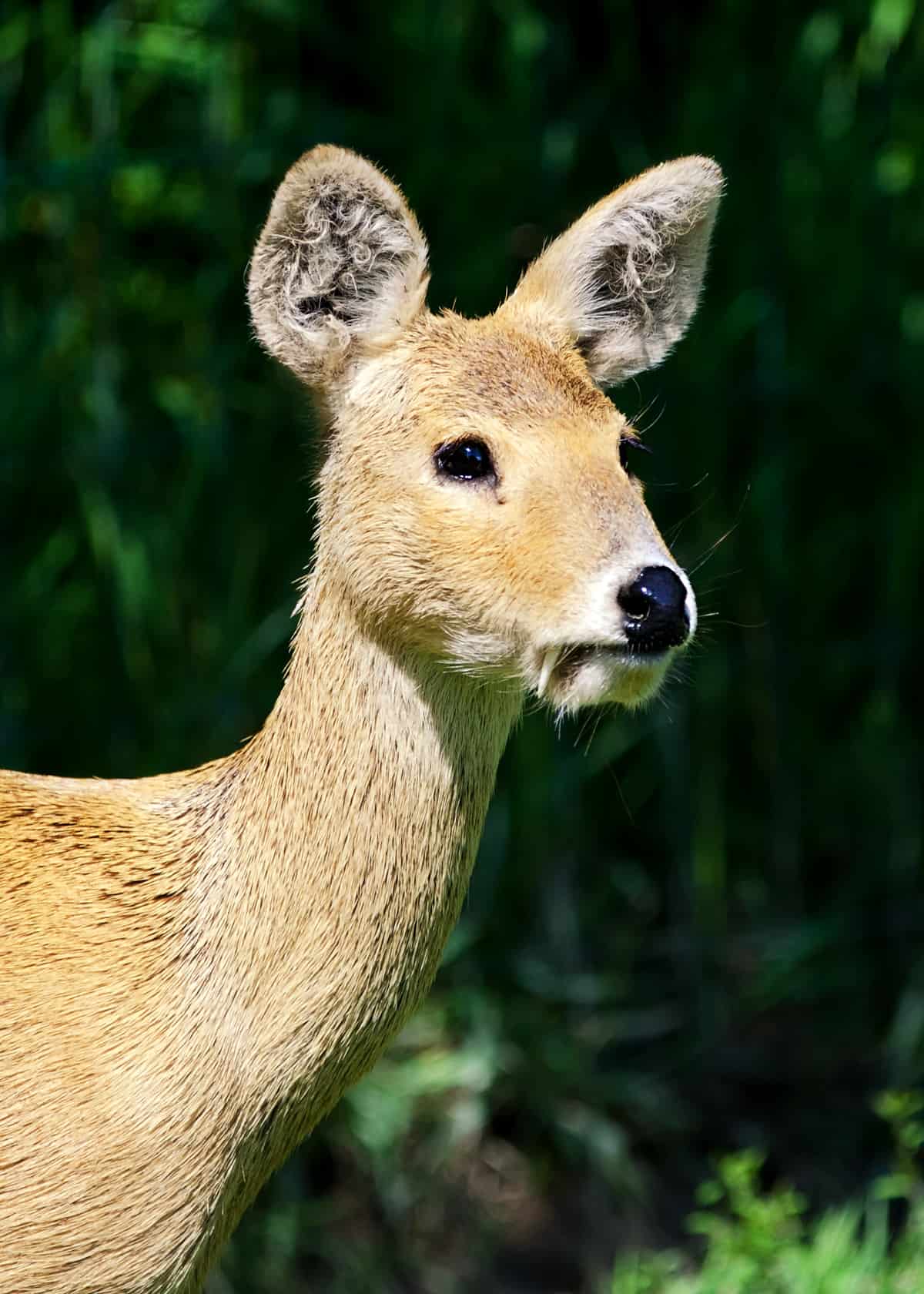
They are sometimes called vampire deer, but you won’t catch them sucking blood or wearing a black cape.
Their real name is “Chinese water deer” because they prefer living around rivers and swamps.
Native to China and Korea but introduced into the United Kingdom, these strange-looking deer feature other odd traits.
The males are territorial and use their long fangs to stab each other when fighting.
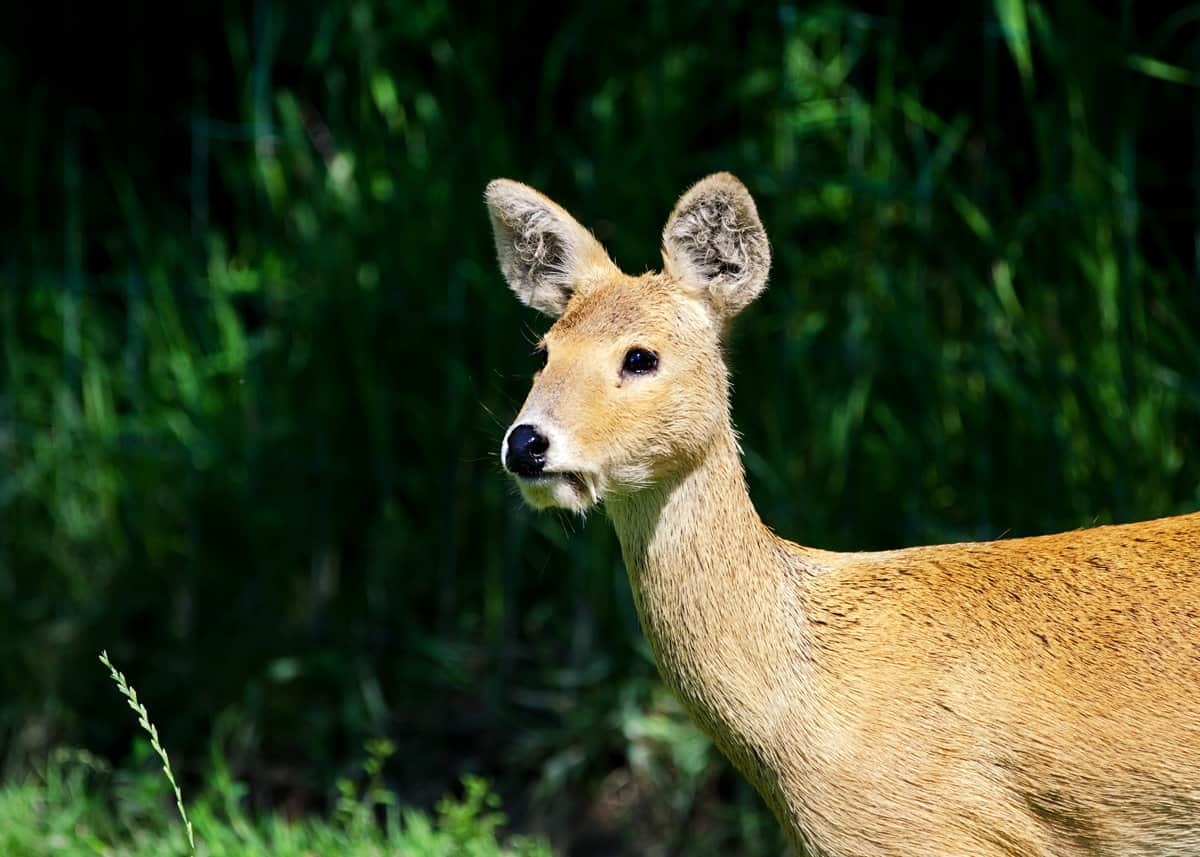
Females can give birth to up to eight babies which is more than any other deer species.
They’re also excellent swimmers and can even swim several miles at a time.
2. Mouse Deer (Chevrotain)
- Latin name: Tragulidae
- Unique weird feature: Resembles a miniature-sized deer with fangs
- Where they’re found: Asia and Africa
- Size: Length: 1.7 to 1.8 feet; Weight: 3.6 to 12 pounds
- Diet: Mostly plants, but the water species will eat insects, crabs, and fish
If you think the Chinese water deer is weird, let me tell you about the mouse deer – a.k.a chevrotain. These weird little animals resemble tiny deer, thus the name…
They are about the size of a small dog but with long, skinny legs and tiny hooves. They are the smallest hooved mammals in the world!
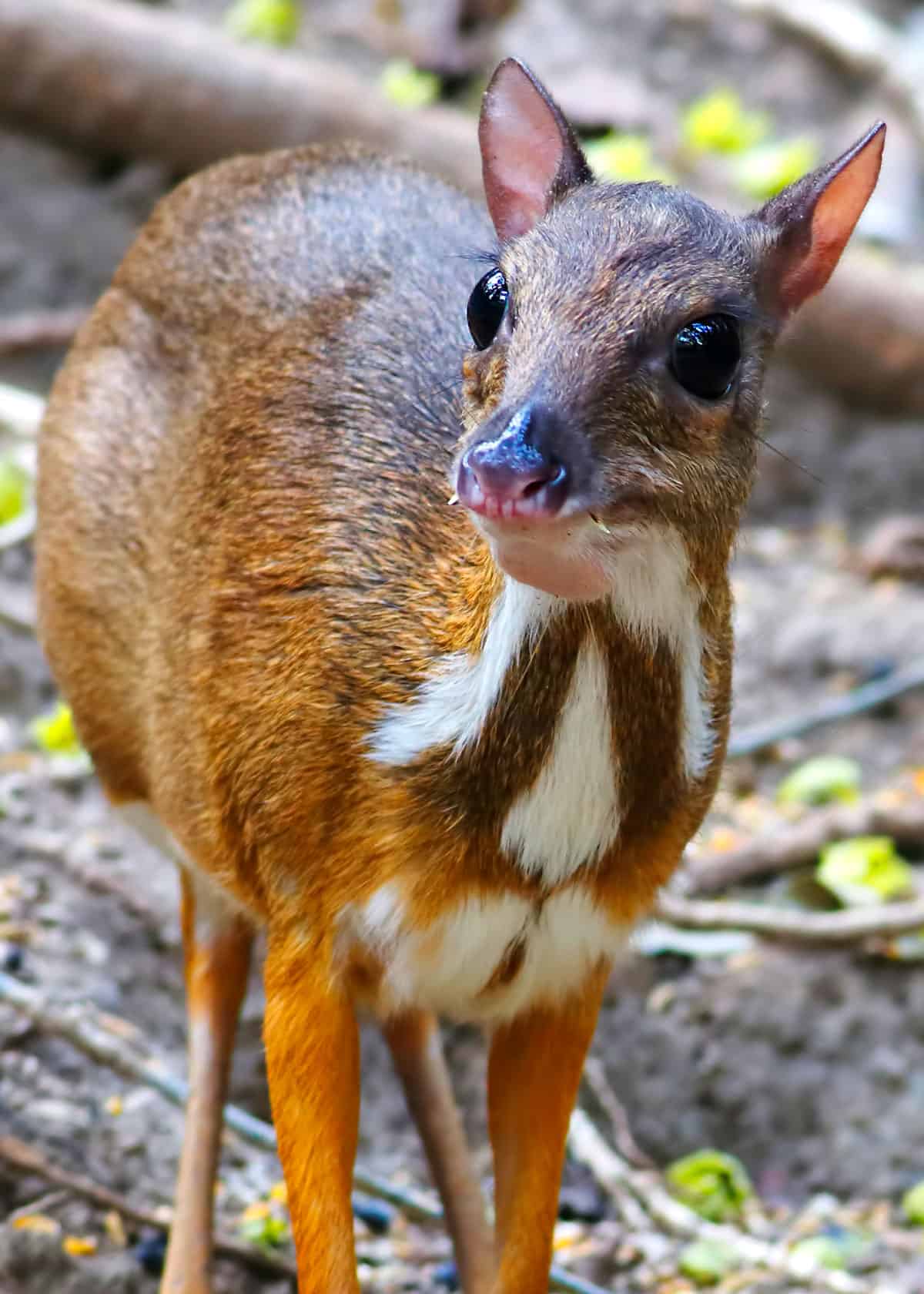
Also like deer, they have multi-chambered stomachs. However, unlike deer, they don’t have antlers. Instead, they do have long, slender fangs.
They also have a fascinating tongue that they use much like a gecko.
They slap their long tongues on the sides of their face to clean it! It looks very funny, as you can see in this video:
So, why are they called mouse deer? Well, like mice, female chevrotains have a knack for staying pregnant.
They only give birth to a single baby at a time, but they’re able to mate again within a few hours after giving birth.
Thanks to their frequent pregnancies, most chevrotains are classified as “least concern” on the conservation index.
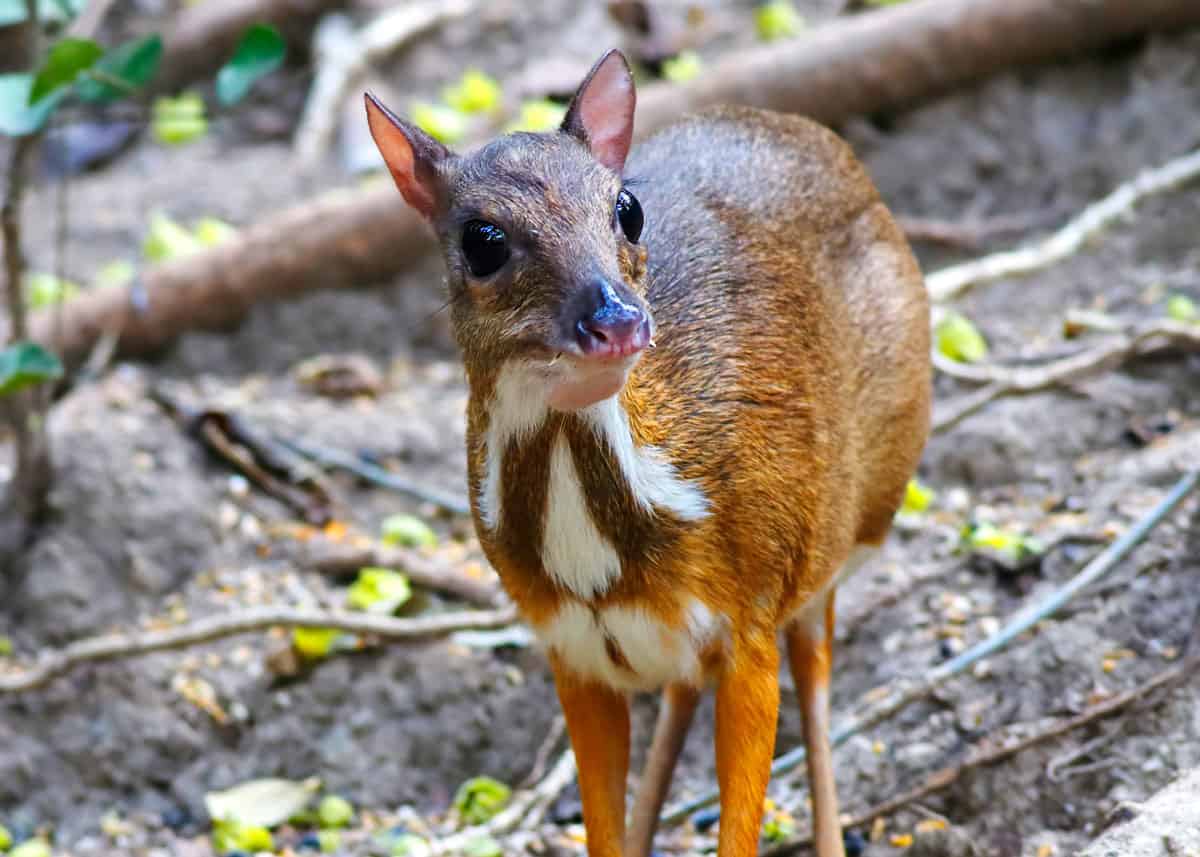
Other unusual features about chevrotains include being to hold their breath for up to 4 minutes, and they’re known to escape predators by diving underwater and walking on the water bottom.
3. Pangolin
- Latin name: Manis
- Unique weird feature: Only mammal that’s covered in scales
- Where they’re found: India, China, parts of Africa, Southeast Asia
- Size: Length: 12 to 39 inches; Weight: 4.4 to 7 pounds
- Diet: Mostly ants and termites
The size of a house cat, pangolins are the world’s only mammal that’s covered in scales from head to toe.
It has a small head, a long snout, and a long, sticky tongue that extends up to 16 inches. It uses this tongue to catch and eat up to 20,000 ants a day.

Pangolins don’t have teeth, so they swallow stones to grind up their food.
They have poor eyesight but exceptional senses of smell and hearing that help them hunt ants and termites.
The pangolin is known for curling up into a tight ball to defend itself against predators, but unfortunately, that doesn’t stop it from being one of the world’s most trafficked animal.
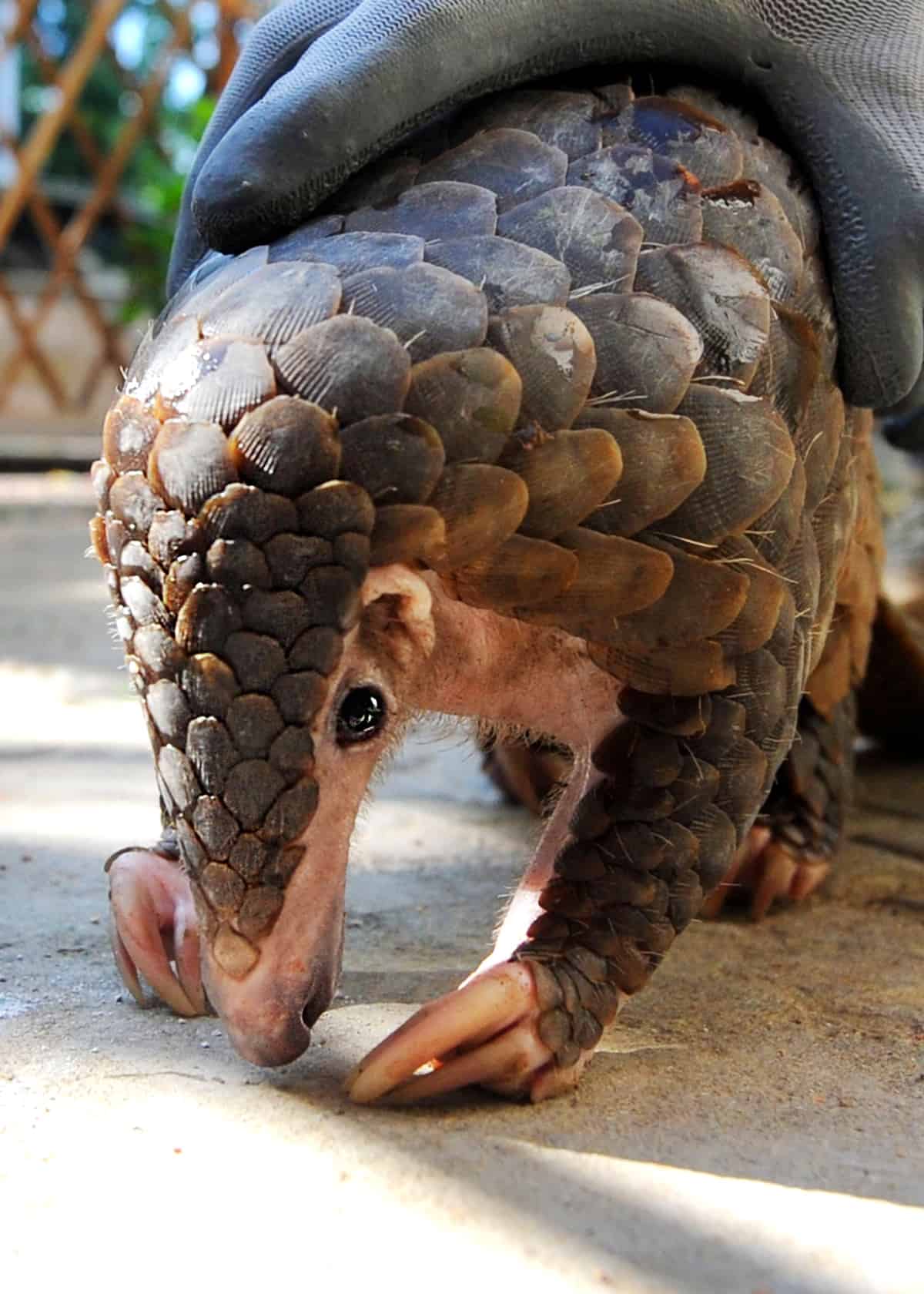
This shy, nocturnal mammal of Asia and Africa is widely hunted for its meat and scales which are used in traditional medicine.
4. Naked Mole Rat
- Latin name: Heterocephalus glaber
- Unique weird feature: Pink-skinned, mostly hairless, independently moving teeth, cold-blooded
- Where they’re found: Horn of Africa (Kenya, Ethiopia, and Somalia)
- Size: Length: 5.1 inches; Weight: 1.2 to 2.8 ounces
- Diet: Roots, tubers
The naked mole rat isn’t really a mole or a rat. It is pretty freaky though! It has wrinkled pink skin with short hairs on its head and tail.
These hairs act as a sensory organ that helps the naked mole rat find its way around in the dark, underground tunnels in which it lives.
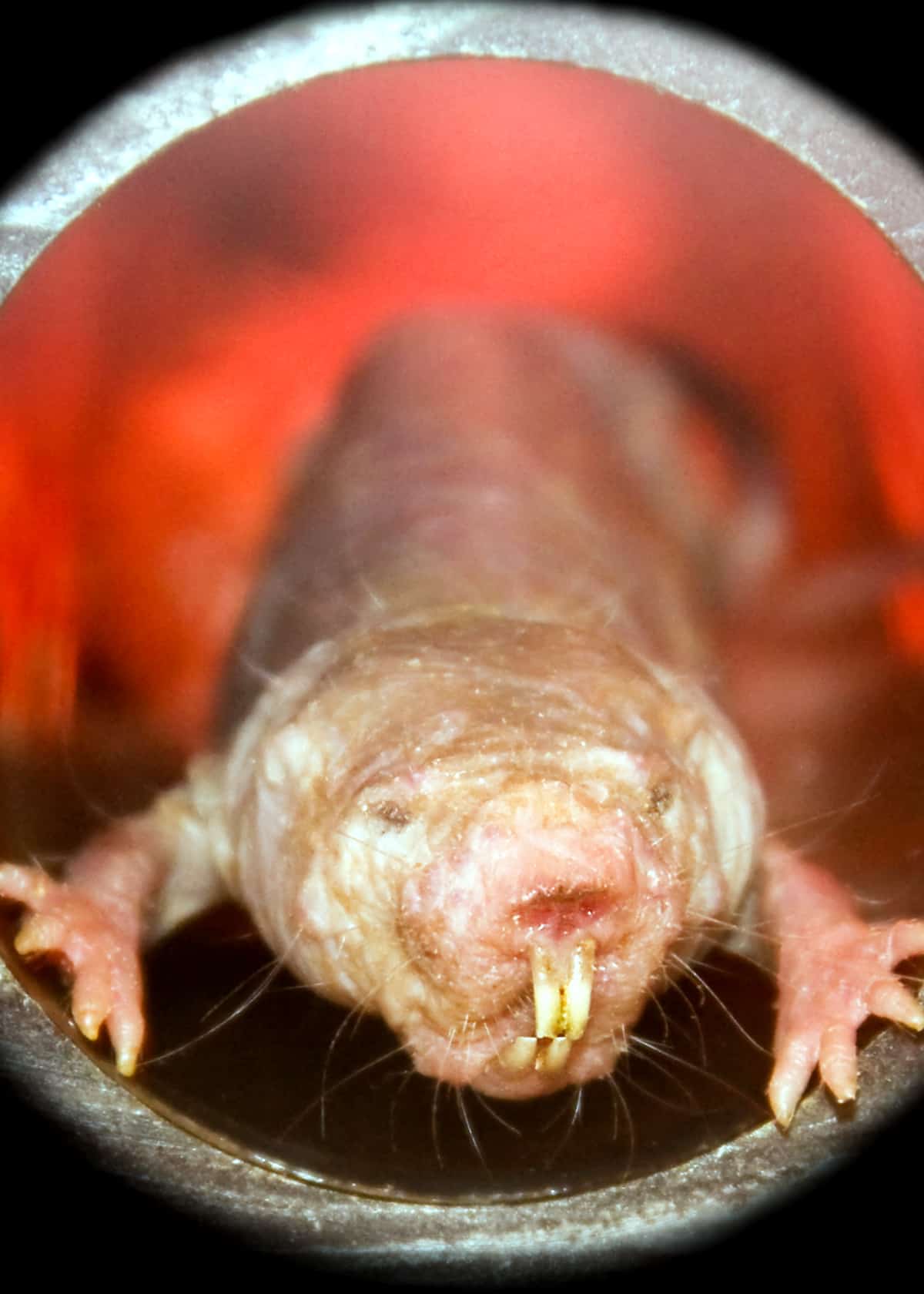
They’re also cold-blooded! It’s true, not all mammals are warm-blooded. When oxygen gets low in their underground tunnels, they simply lower their body temperatures to conserve oxygen.
In fact, they share similarities with plants. Their bodies start using a different kind of sugar to keep them alive, called fructose.
Normally, mammals use (metabolize) glucose. Fructose is a sugar that can be metabolized without using oxygen.
Found in Eastern Africa, naked mole rats live in colonies much like ants and bees. Each colony has a queen with soldiers and workers.
They’re also resistant to cancer, can survive five hours with little oxygen and can live up to 30 years. This is one weird mammal!
Now for some nostalgia. If you’re like me, you probably know the naked mole rat as Rufus from Kim Possible – only one of Disney’s most popular shows!
You were probably quite surprised to see what these guys really look like. And for those of you that have no idea what I’m talking about, here’s the classic:
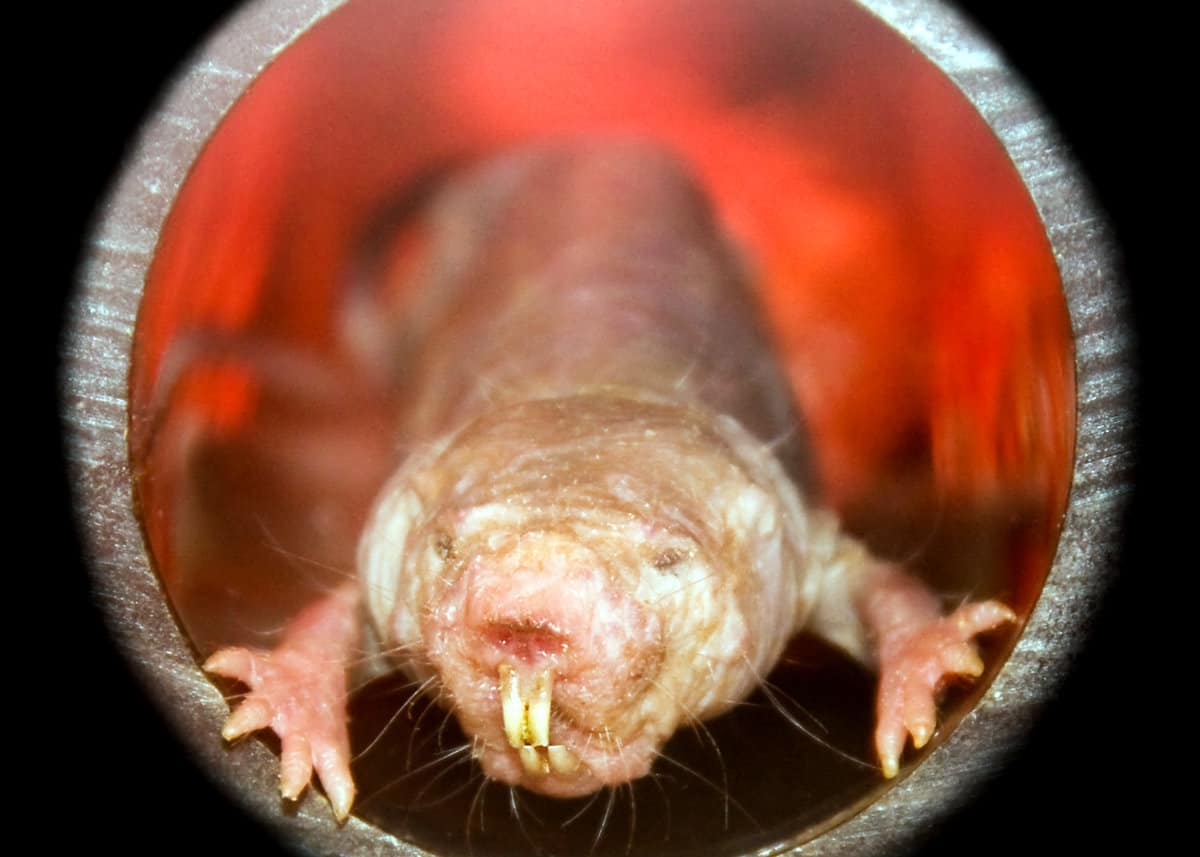
Fun Fact: Naked mole rats also have huge incisors outside of their mouths, so they can move dirt without having to eat it.
These teeth can move independently – like weird chopsticks!
5. Bat-eared Fox
- Latin name: Otocyon megalotis
- Unique weird feature: Enormous ears
- Where they’re from/found: Africa
- Size: Length: 18 to 26 inches; Weight: 7 to 12 pounds
- Diet: Mostly termites but also ants, moths, spiders, grasshoppers, crickets, scorpions and the occasional small bird or reptile
My, what big ears you have! You can’t help but notice the bat-eared fox’s large ears when you first see this small fox.
They stand out but also serve a couple of important purposes.

They’re filled with blood vessels that regulate heat and keep the fox cool.
The ears also provide the fox with such incredible hearing that it can actually hear beetle eggs hatching out from dung balls.
Preferring the short grasslands of the African savanna, bat-eared foxes live in family groups where they sleep, play and social-groom together.
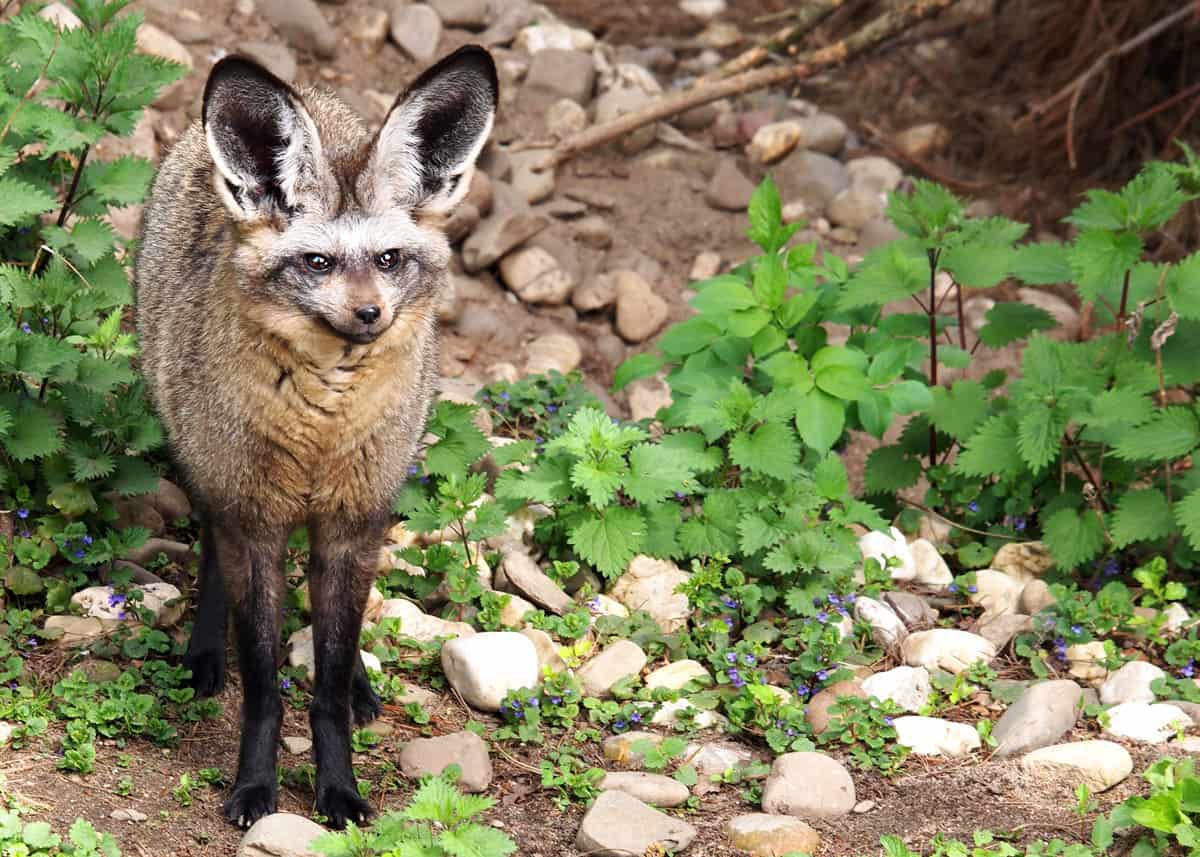
These tawny-furred animals with their bushy tails and dark face masks love feasting on termites which makes local farmers very happy.
When they’re not foraging, they like to lounge under acacia trees.
6. Colugo
- Latin name: Dermoptera
- Unique weird feature: It can glide through the air.
- Where they’re from/found: Southeast Asia
- Size: Length: 14 to 16 inches; Weight: 2.2 to 4.4 pounds
- Diet: Leaves, young shoots, flowers, fruit
Some people call the colugo a “flying lemur,” but this tree-dwelling mammal is not really a lemur at all.
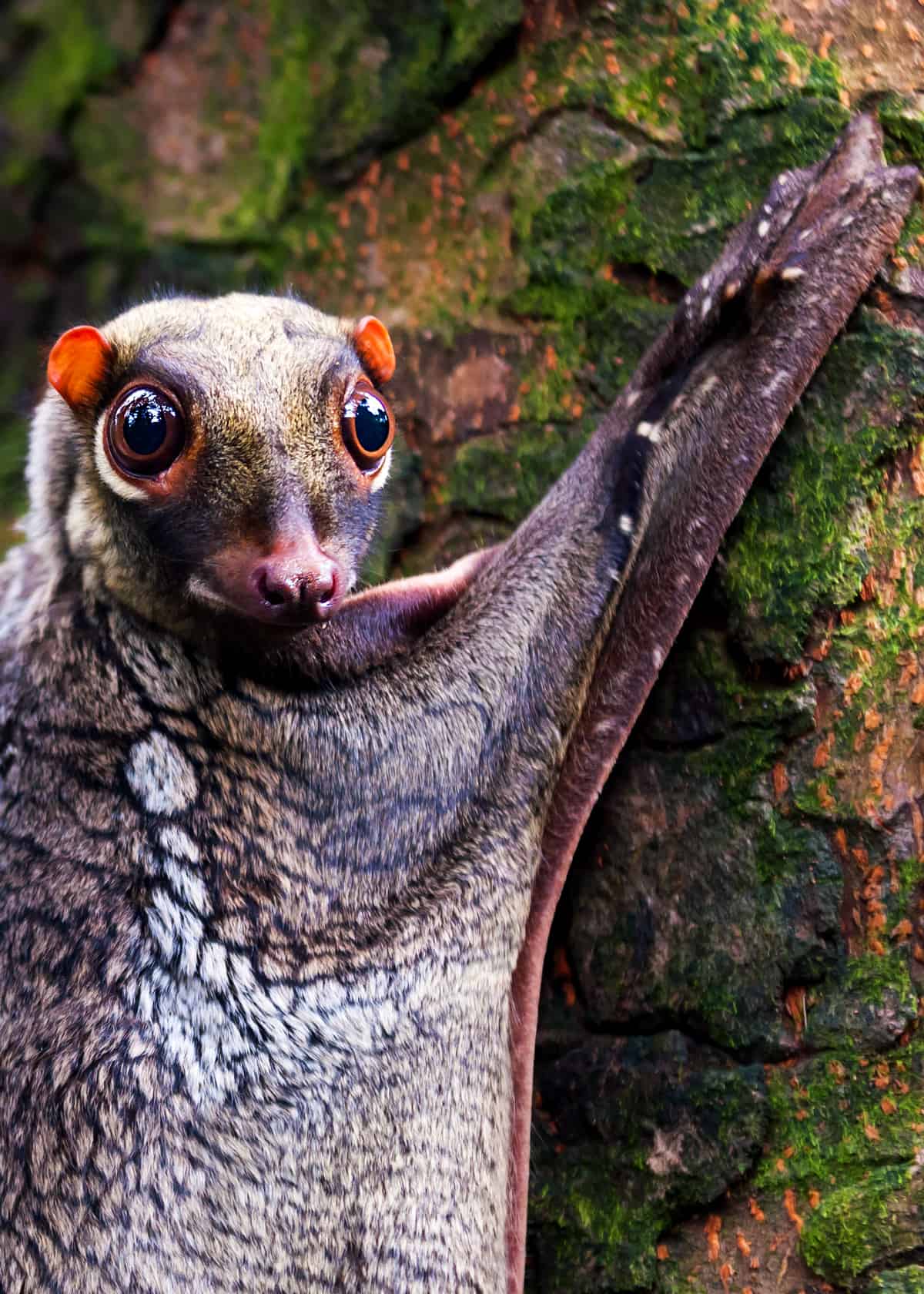
This mottled green-gray fella is a gliding animal.
It has a thin membrane of skin between its legs that enable it to glide as far as 230 feet.
Colugos spend most of their time in the trees of tropical rainforests in Southeast Asia either sleeping during the day in tree hollows or foraging at night for leaves, fruit, and flowers.
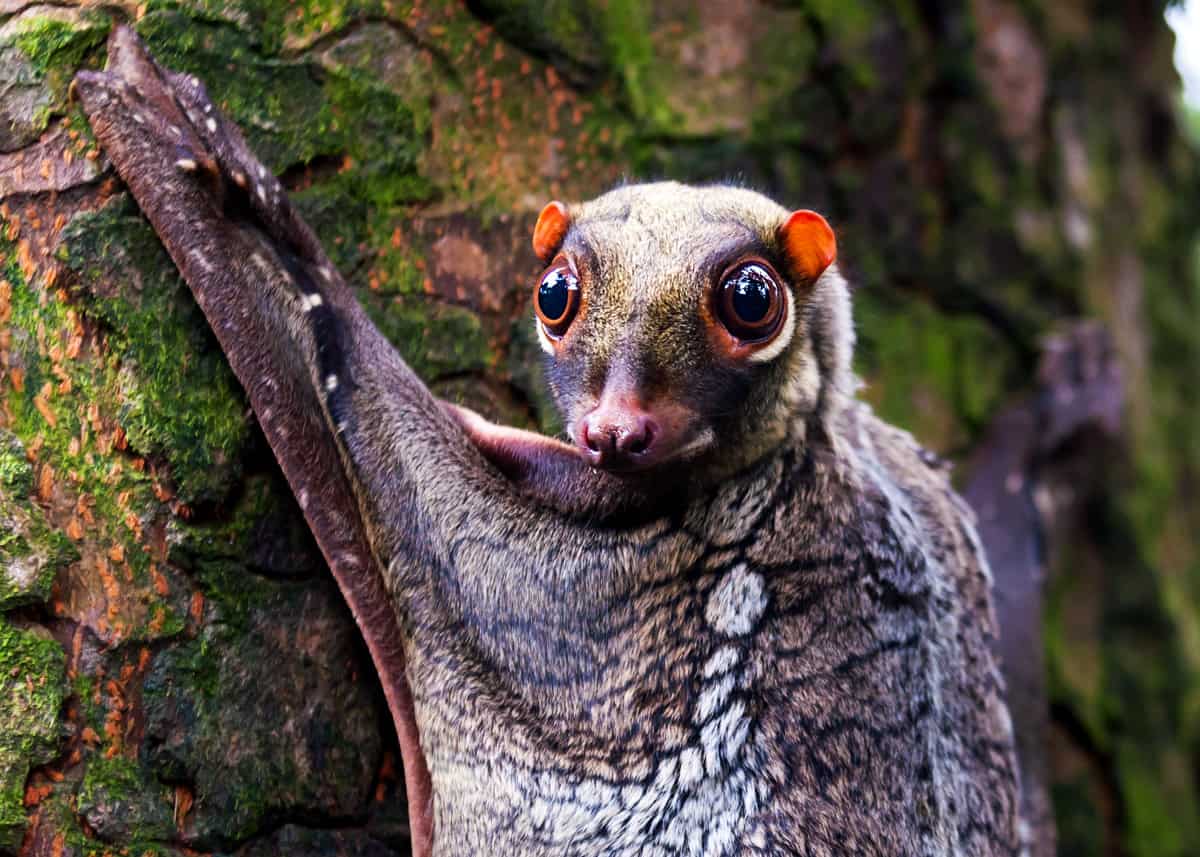
Even though they’re tree dwellers, these shy, nocturnal animals don’t climb very well.
They make their way up the trees by hopping and gripping onto tree bark with their sharp claws.
7. Etruscan Shrew
- Latin name: Suncus etruscus
- Unique weird feature: World’s smallest mammal
- Where they’re found: Europe, North Africa, Arabian Peninsula, Asia
- Size: Length: 1.2 to 2 inches (Excluding tail); Weight: 0.046 to 0.088 ounces
- Diet: Insects, earthworms, small lizards
Can you guess what’s the smallest mammal in the world? If you said the Etruscan shrew, you’re correct. This tiny, brown/gray, mole-like animal measures only about two inches long and usually weighs less than an ounce.
The Etruscan shrew may be itsy bitsy, but it can eat nearly twice its own body weight each day.
It hunts and feeds mostly on insects and earthworms, but if it’s really hungry, it will even hunt small lizards and rodents that are in equal size to itself.
If the Etruscan shrew experiences a food shortage or extremely cold weather, it has the ability to lower its body temperature and temporarily hibernate.
It also has an extremely fast heart rate with about 25 beats per second!
8. Pink Fairy Armadillos
- Latin name: Chlamyphorus truncatus
- Unique weird feature: World’s smallest armadillo (and it’s pink!)
- Where they’re found: Central Argentina
- Size: Length: 3.5 to 4.5 inches; Weight: 4.2 ounces
- Diet: Ants, worms, snails, larvae, plant material
Growing only to about two inches in length, this strange, nocturnal creature is the smallest armadillo in the world.
It has a dorsal shell that appears pink due to visible, underlying blood vessels that regulate the armadillo’s body heat.
To adjust to environmental factors, this little armadillo’s blood flow increases or decreases which can cause its color to change as well. Sounds magical, doesn’t it? Maybe that’s where “fairy” part of its name comes from.
Beneath the shell, the armadillo has a silky, yellowish-white fur and two sets of claws that appear massive in contrast to the rest of its body.
These claws help the armadillo to dig burrows into sand so quickly that it’s nicknamed a sand-swimmer.
9. Aye-aye
- Latin name: Daubentonia madagascariensis
- Unique weird feature: Largest nocturnal primate and has a third eyelid
- Where they’re found: Madagascar
- Size: Length: 14 to 17 inches; Tail: 22 to 24 inches; Weight: 4 to 6 pounds
- Diet: Insects, larvae, fruit, seed, fungi
“Aye-aye! What is that scary-looking creature!” Supposedly, that’s how the aye-aye got its name.
Naturally found only on Madagascar, the aye-aye is a primate like apes and monkeys, but a primate unlike any other.
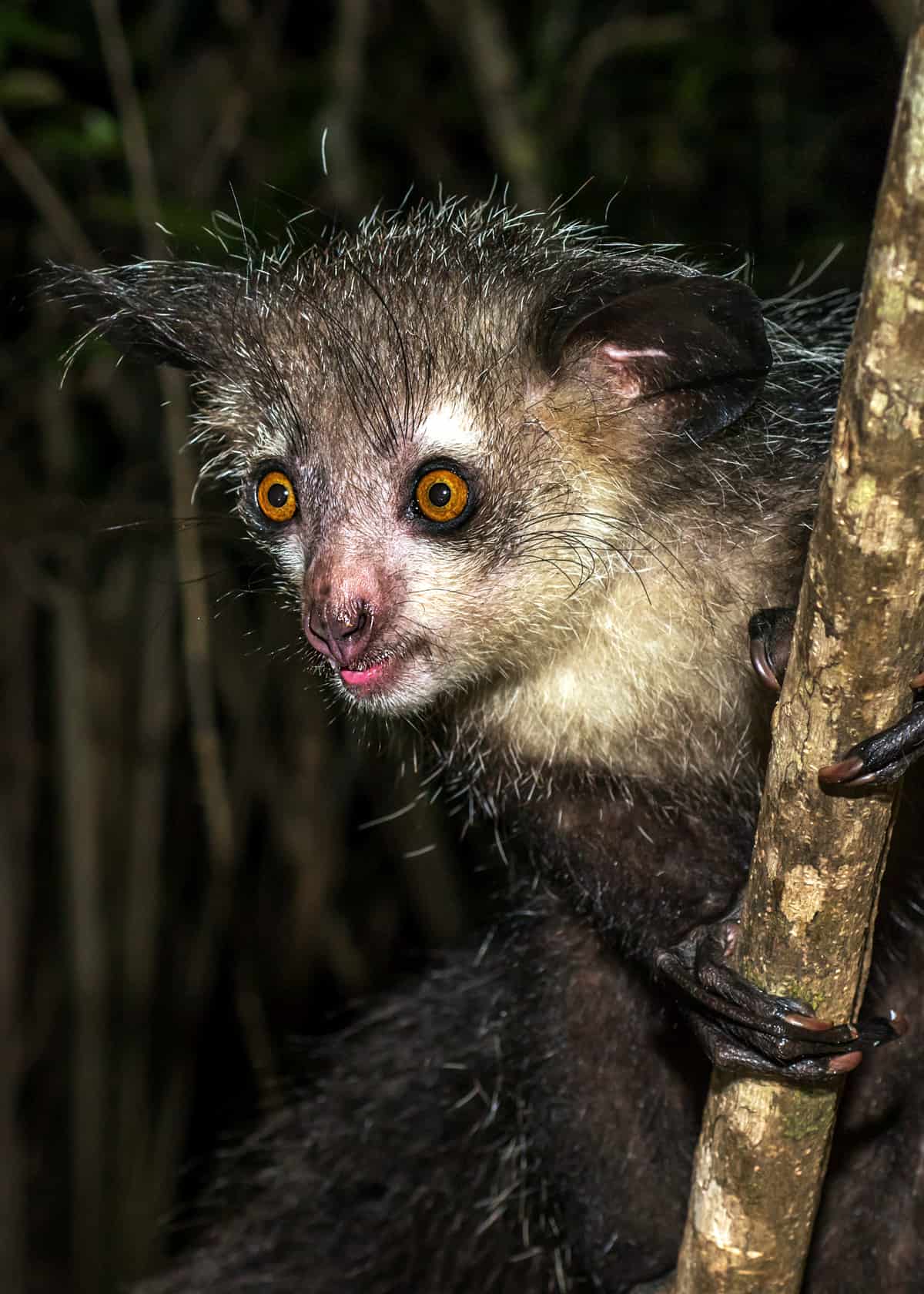
About two feet long and weighing around five pounds, the aye-aye is regarded by locals as a terrifying animal with dark fur, creepy claws, a third eyelid, and yellow eyes that glow in the dark.
The aye-aye is also the largest nocturnal primate in the world and the only primate to use echolocation (using echo sounds to find their way around in the dark).
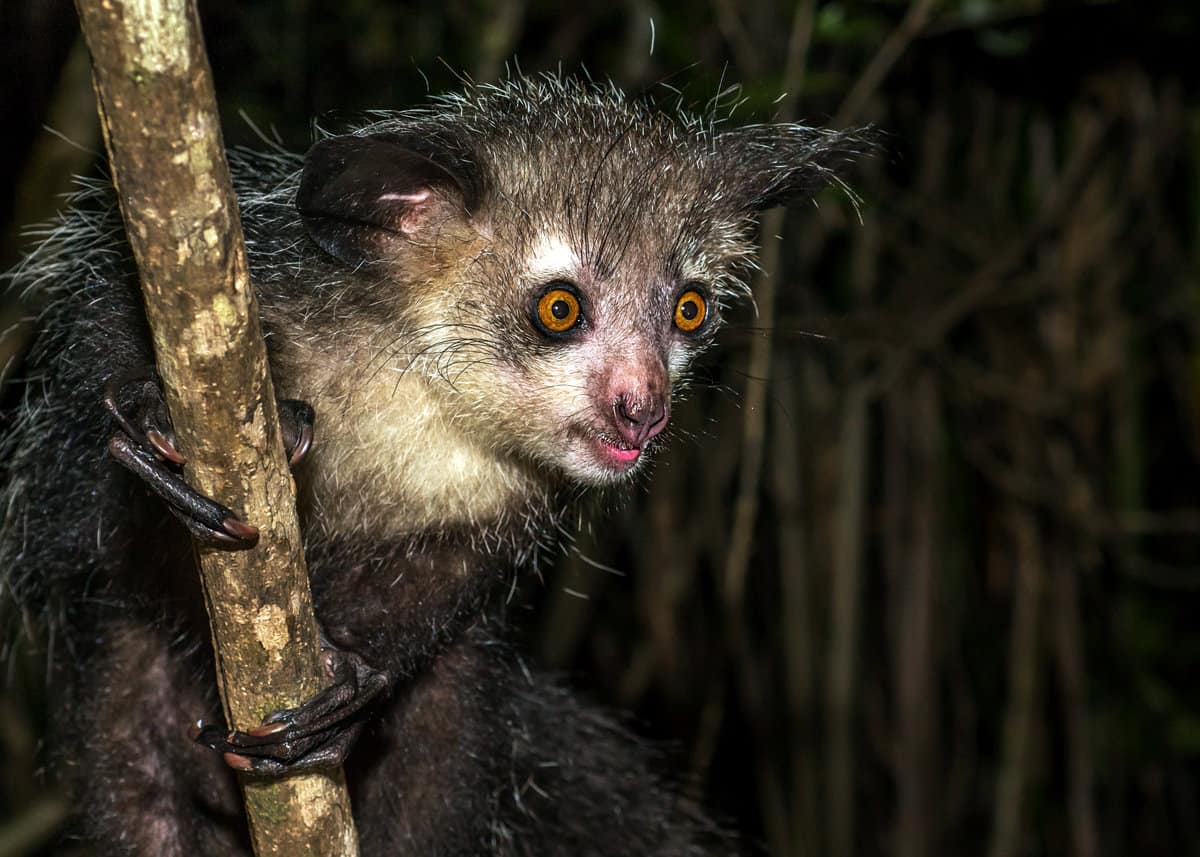
Unlike other primates, a female aye-aye can reproduce for as long as it lives.
After giving birth, a mother will sometimes carry her baby in her mouth when she senses danger.
10. Solenodons
- Latin name: Solenodon
- Unique weird feature: Long, flexible snout
- Where they’re found: Cuba and Hispaniola
- Size: Length: 11 to 13 inches; Weight: 1.5 to 2.2 pounds
- Diet: Insects, worms, small vertebrates, fruits, vegetables, fruits
Solenodons look like cartoon characters, smell like goats, and sound like pigs and birds. Oh, and they’re one of the only venomous mammals!
Unique among mammals, these weird animals occur in two different species on the islands of Cuba and Hispaniola.
In addition to their beige and brown fur, long, scaly tails, and tiny eyes, they have flexible, elongated snouts that give them the ability to eat anything they sniff out from the ground like roots, insects, and worms. They’re clumsy and can trip over their own toes.
Glands in their groins and armpits secrete an odor that makes them smell musky like a goat. If threatened, they grunt like a pig or cry like a bird.
If that doesn’t scare away a predator, they can inject venom through their grooved teeth.
Solenodons are also nocturnal, foraging for food at night and sleeping in burrows or hollow logs by day.
11. Narwhal
- Latin name: Monodon monoceros
- Unique weird feature: Long tusk (protruding tooth)
- Where they’re found: Arctic waters around Canada, Greenland, and Russia
- Size: Length: 17 feet; Weight: 2,100 pounds
- Diet: Fish, shrimp, squid
You can’t go see narwhals at SeaWorld or any other aquarium exhibit because narwhals don’t survive in captivity.
The only way to see them is by visiting the extremely cold waters of Russia, Norway, Canada, and Greenland (particularly Baffin Bay).
For this reason, many people think narwhals are as mythical as the unicorn.
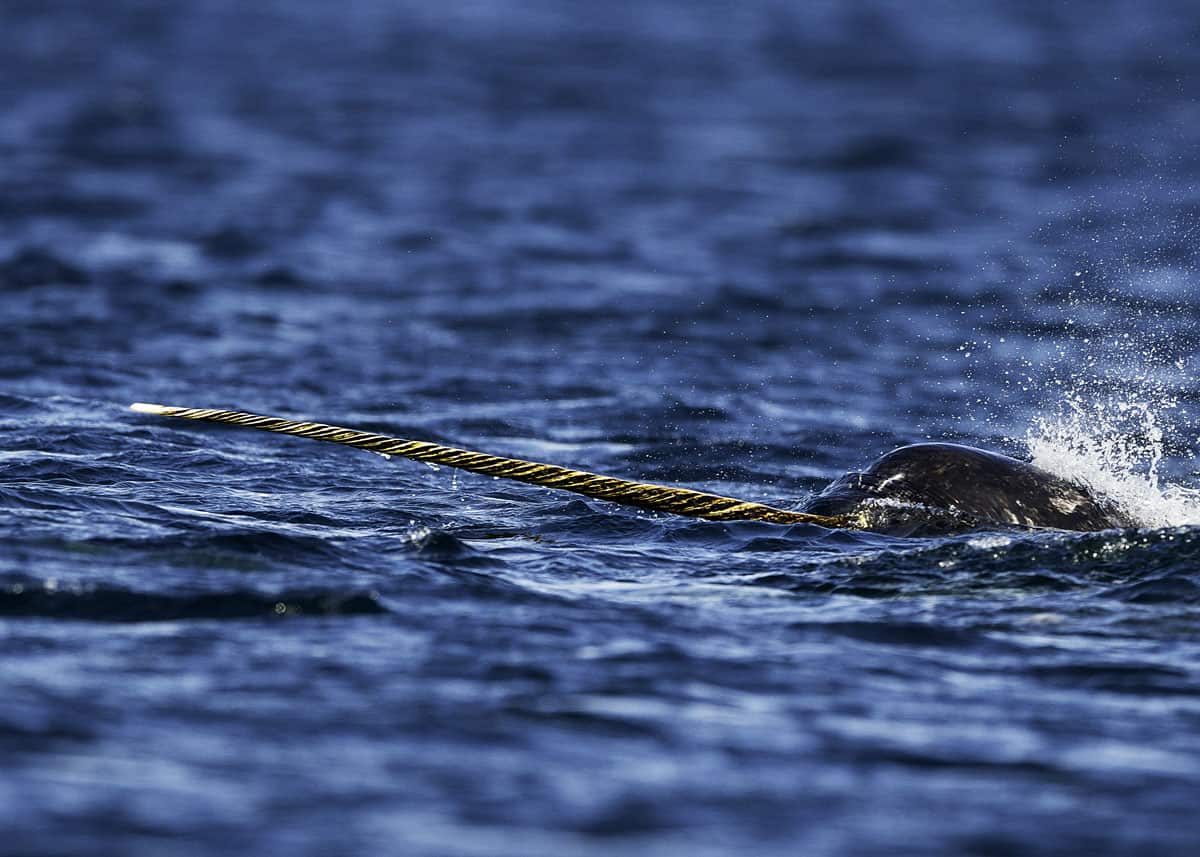
However, narwhals are very real. Similar to dolphins and whales, they must come to the surface to breathe air.
But, what sets a narwhal apart from its relatives is a tusk that’s really a long tooth and can grow up to 10 feet long and spirals as it grows.
It’s suspected that narwhals use their tusks to stun their prey or as symbols of dominance to attract females.
It’s now thought that the tusk has nerves and helps the narwhal sense changes in the water such as temperature and salt content. But, strangely enough, only 15% of the females have a tusk. So, we still aren’t really sure.
12. Aardvark
- Latin name: Orycteropus afer
- Unique weird feature: Has a mishmash of various animal features
- Where they’re found: Sub-Saharan Africa
- Size: Length: 43 to 53 inches (from head to tail); Weight: 100 to 180 pounds
- Diet: Mostly ants and termites but also other insects and some plants
A shy creature that lives in sub-Saharan Africa, the aardvark looks like it’s been made with a collage of various animal parts.
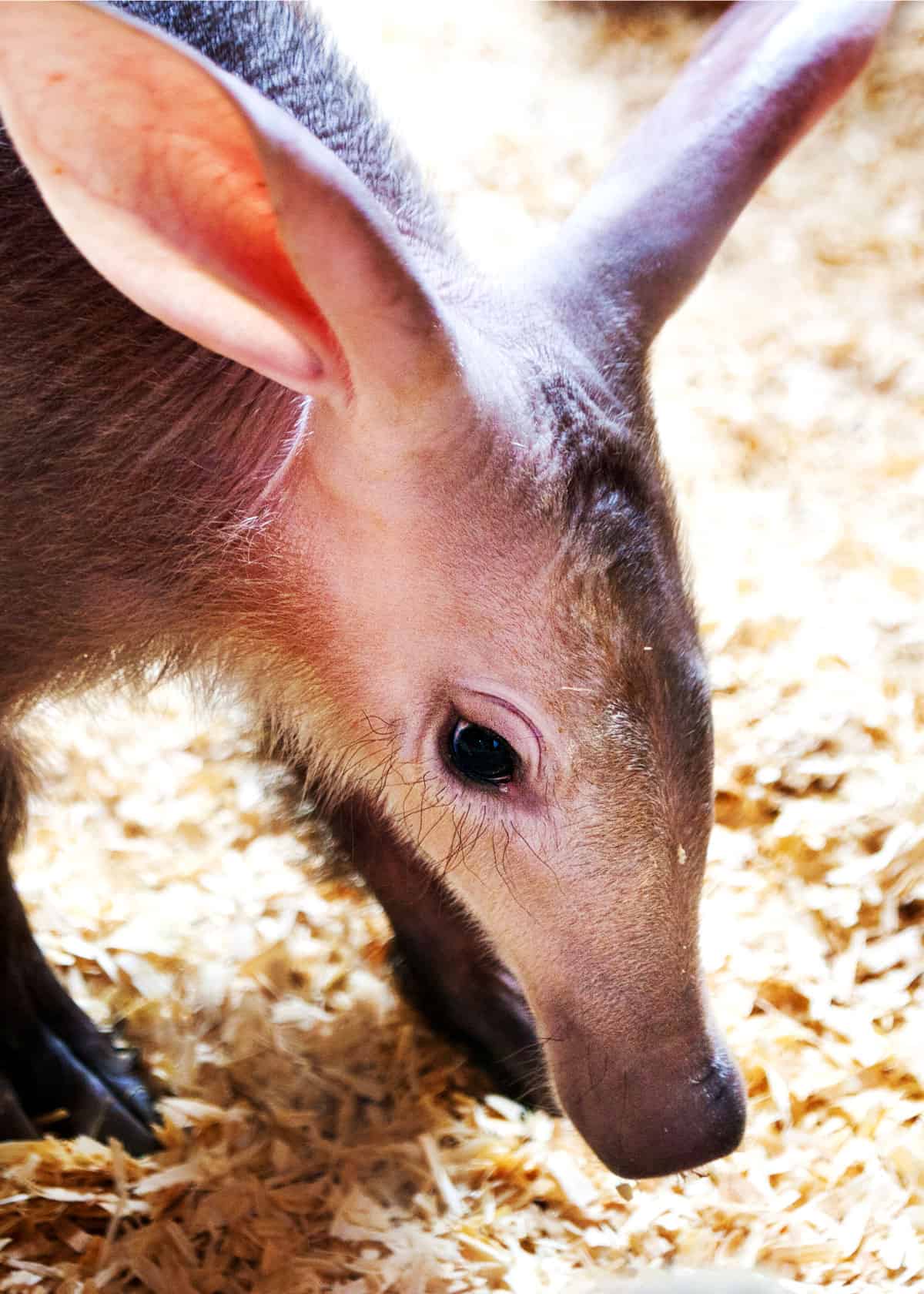
It has a snout like a pig, ears like a rabbit, a tail like a kangaroo, webbed feet like a duck, and a tongue like an anteater.
A solitary, nocturnal mammal that digs shallow, underground tunnels to hide in by day, the aardvark goes out at night searching for ants and termites.

It can travel up to 19 miles (30 km) and eats about 50,000 ants/termites per night.
If threatened by a predator, it may squeal like a pig but can swim as well as a duck.
13. Gerenuk
- Latin name: Litocranius walleri
- Unique weird feature: Has a giraffe-like neck
- Where they’re found: Horn of Africa and other parts of East Africa
- Size: Height: 31 to 41 inches; Weight: 60 to 115 pounds
- Diet: Leaves, shoots, herbs, flowers, and fruits
Is that a baby giraffe? Is it a deer? Actually, it’s a type of antelope that’s found in the dry areas of East Africa and the Horn of Africa.
Its Somali name, “gerenuk,” translates “giraffe-necked” due to its long, slender neck.
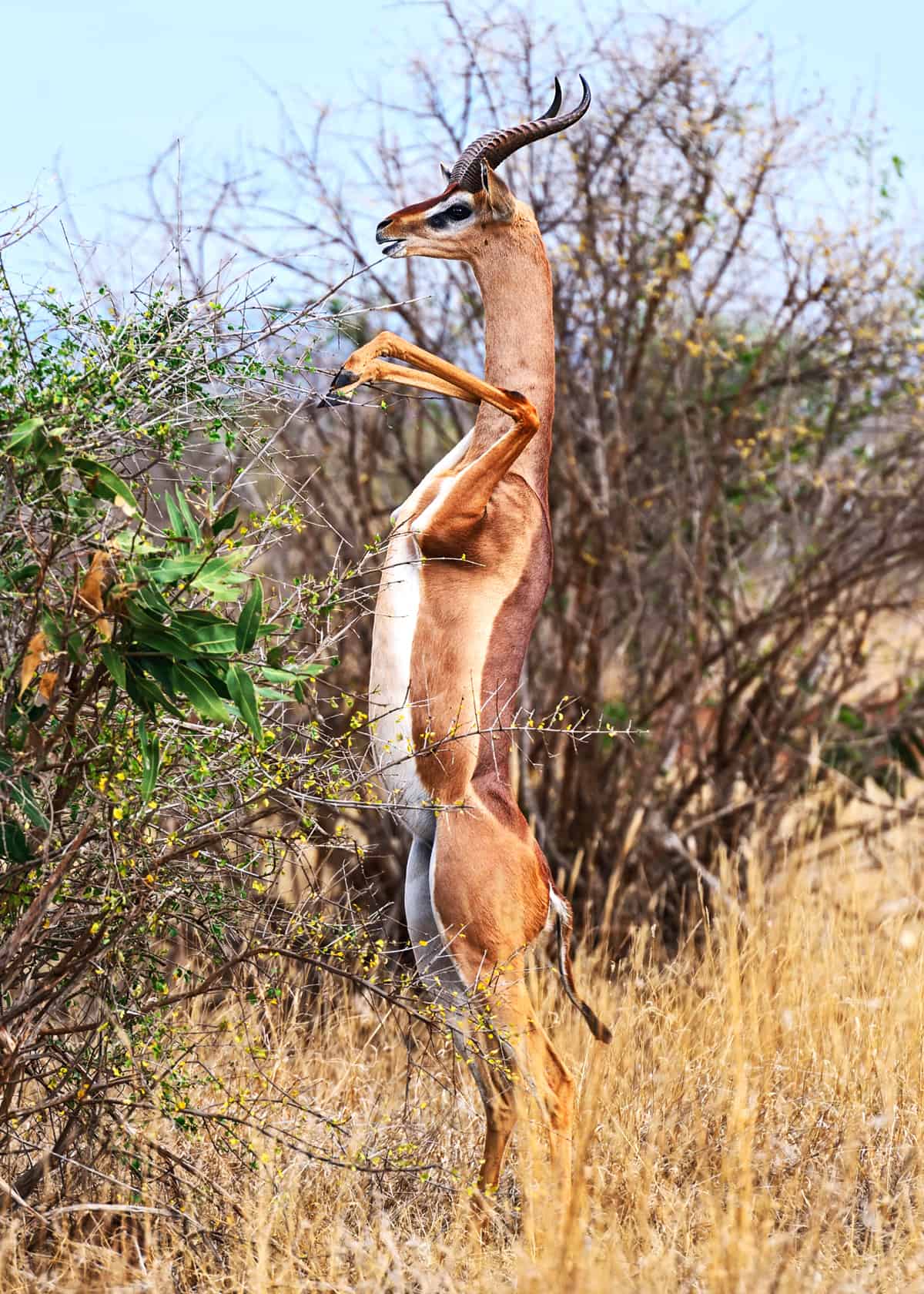
The gerenuk features a coat of reddish-brown hair on the back, tan hairs on each side, and a white belly.
Males sport black, curving horns that they use to aggressively defend their territories.
Unlike other antelopes, gerenuks have special vertebrae in their spines that enable them to stand on their hind legs so that they can eat leaves, vines, and flowers from tree branches as high as eight feet from the ground.
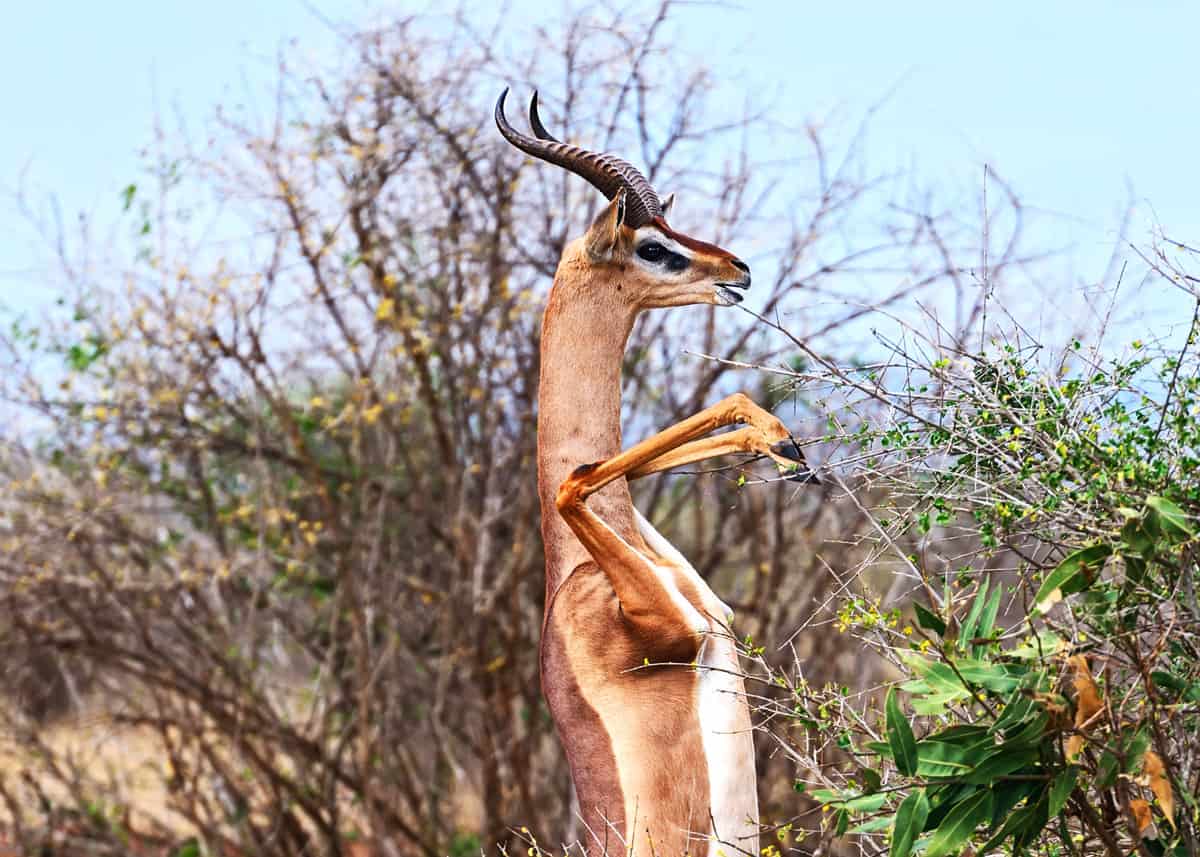
They never need to drink water because they get it from the vegetation they eat.
14. Pygmy Jerboa
- Latin name: Salpingotulus michaelis
- Unique weird feature: World’s smallest rodent. Looks part mouse and part kangaroo
- Where they’re found: Pakistan and Afghanistan
- Size: Body Length: 1.7 to 2 inches; Tail length: 3.1 inches; Weight: Less than an ounce
- Diet: Wind-blown seeds, succulent plants
If there’s ever a contest for the cutest rodent, the pygmy jerboa would surely win it. Some have described it as a crossbreed between a mouse and a miniature kangaroo.
It looks like a little ball of yellow fur with mouse ears, big round eyes, long whiskers, tiny front legs, and large hind legs shaped like a kangaroo.
These legs equip the pygmy jerboa to hop nearly ten feet at a speed of 15 mph when chased by a predator.
Measuring only about two inches in length (plus a 3-inch tail) and weighing less than an ounce, this little pipsqueak may just be the world’s smallest rodent.
Native to the deserts and sand dunes of Pakistan and Afghanistan, the pygmy jerboa escapes the hot sun by sleeping in underground burrows during the day and foraging for seeds and succulent plants at night.
An excellent sense of hearing and smell help the jerboa to find food and avoid predators.
15. Markhor
- Latin name: Capra falconeri
- Unique weird feature: Corkscrew horns. It can climb trees.
- Where they’re found: Pakistan, India, Afghanistan
- Size: Height to shoulder: 26 to 45 inches; Length: 52 to 43 inches: Weight: 71 to 243 pounds; Horn length: Up to 63 inches in males
- Diet: Grasses, leaves, flowers, herbs, twigs, and shrubs
If you’re ever exploring the mountainous areas of Pakistan, India or Afghanistan and see what looks like a goat climbing a slanted tree, think nothing of it.
It’s only the markhor, a large, wild goat that’s the national animal of Pakistan.
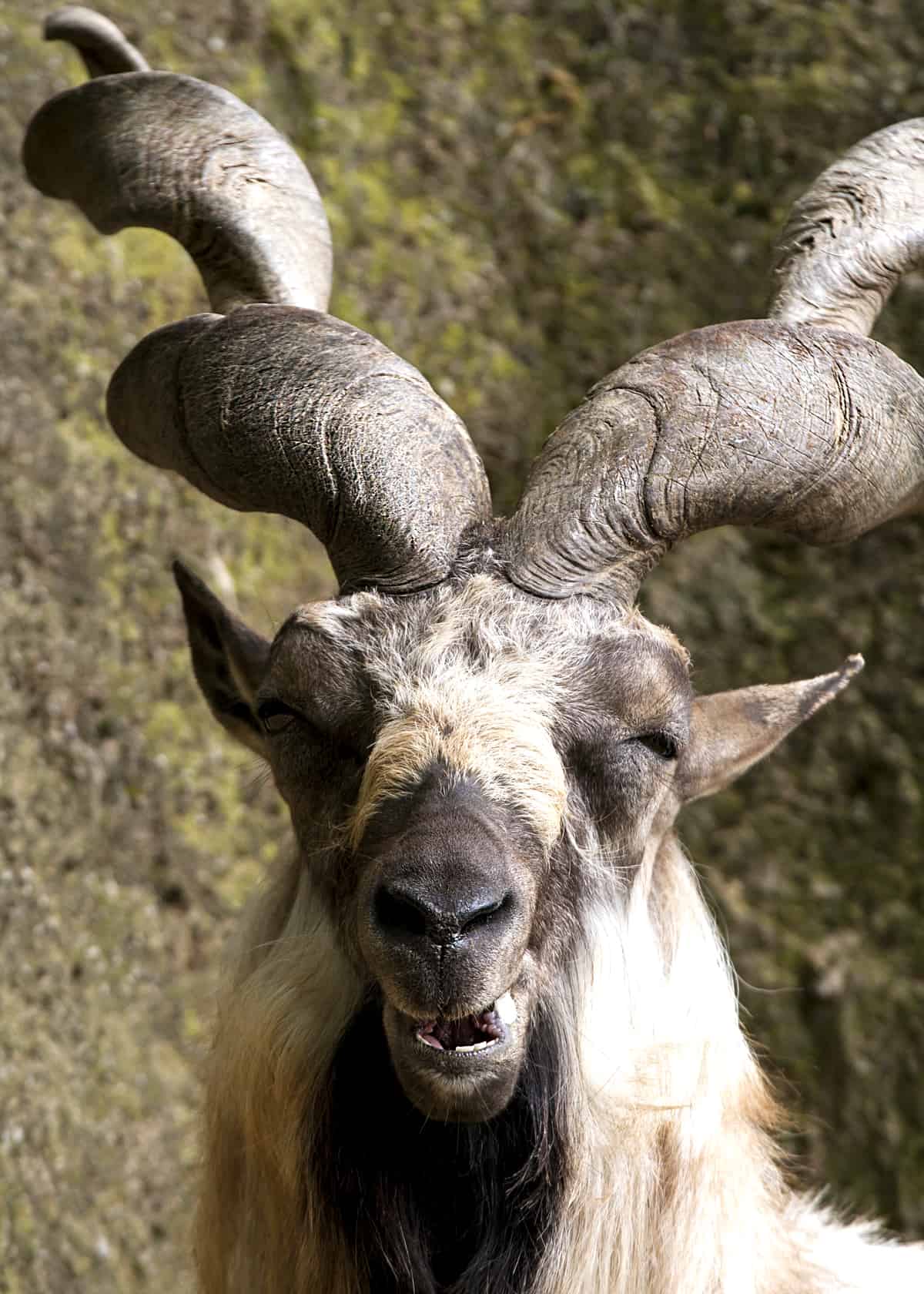
Markhors have brownish-black (males) or reddish-brown (females) coats with long, shaggy beards and spiral, corkscrew-shaped horns that can grow up to 63 inches in males and about 10 inches in females.
These horns may be used for fighting during mating season but also for digging in the ground and scraping bark from the trees.
Also, like a tree, the markhor horns have rings that indicate their age, just like trees!
Markhors have wide-hooved feet that help them to climb steep cliffs and even trees to escape predators such as black bears, wolves and snow leopards.
The markhor reminds me of the crazy old goat from hoodwinked. Anyone with me on this? Or am I the only one that saw this weird movie 😂?
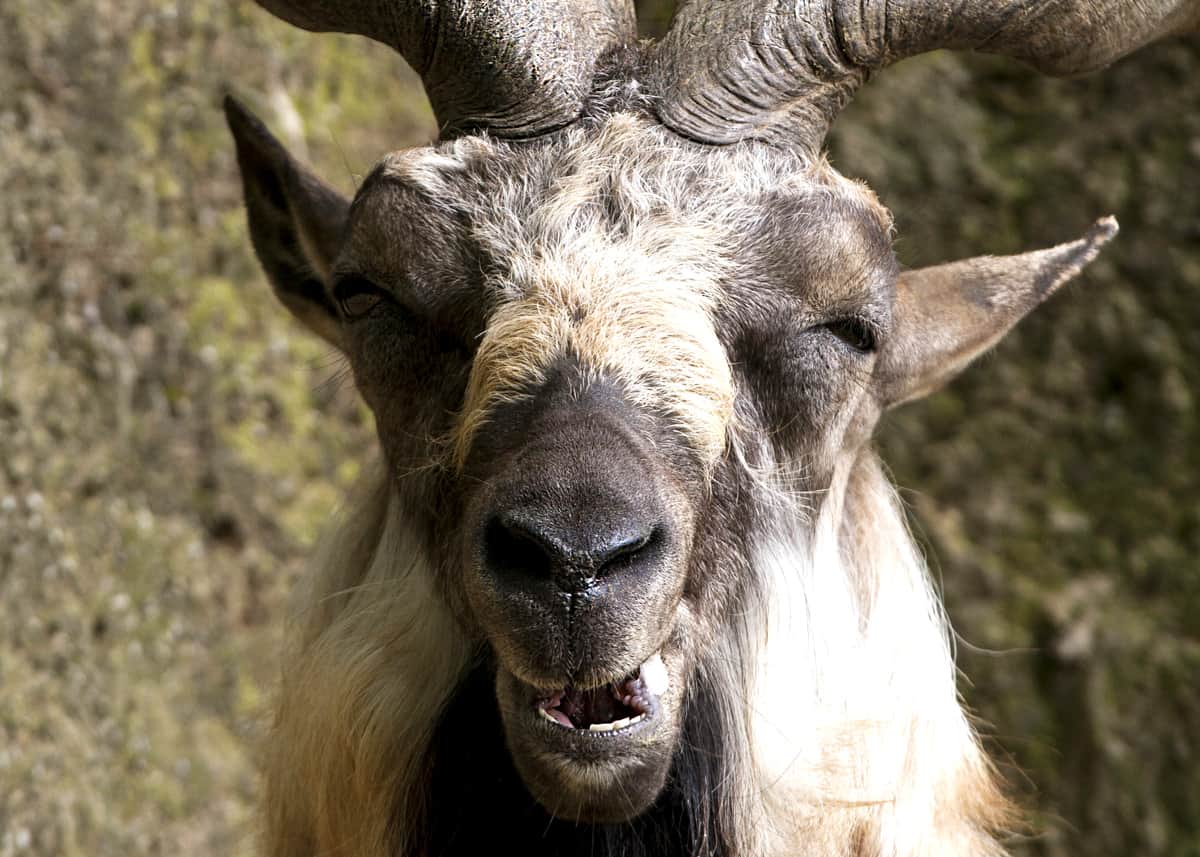
What a face! Always be prepared… 🐐
16. Water Opossum – Yapok
- Latin name: Chironectes minimus
- Unique weird feature: Both male and female have pouches, webbed feet
- Where they’re found: Mexico, Central, and South America
- Size: Length: 10.6 to 15.7 inches; Weight: 21.2 to 28 ounces
- Diet: Fish, shrimps, crayfish, frogs
Have you ever seen an opossum that lived part-time in the water and ate stuff that lives in the water like fish and shrimp?
If you think that’s unusual, I’ll tell you something even more strange about the water opossum: both male and female have a pouch like a kangaroo.
The water opossum is the only marsupial in the world to have this feature. So, why does the male have a pouch? The answer is kind of weird (ironic, I know). He uses his pouch to carry his… sensitive bits, while swimming in the water. Why? To protect them of course!
Now, this may sound strange and a little… inappropiate. But it actually makes a lot of sense. If they weren’t protected, they could slow the possum down and possibly get stuck on something. Yikes.
Also, sperm (what males need to reproduce with females) needs to be at the right temperature. Too hot or too cold, and they may not be fertile. So the yapoks pouch is an important part of the survival of the species; even if it is kind of weird to talk about.
Found near freshwater stream and rivers in Mexico and Central and South America, this unique animal is locally known as the yapok.
Unlike other opossums, it has waterproof fur and webbed feet which make swimming easier. This weird critter is a loner who prefers to stay hidden in its burrow during the day and goes swimming at night to hunt for food.
17. Maned Wolf
- Latin name: Chrysocyon brachyurus
- Unique weird feature: Tallest wild canid (dog-like mammal), roar-bark, marijuana-smelling urine
- Where they’re found: Parts of South America
- Size: Height: 35 inches; Length: 39 inches (head to body); Tail length: 18 inches; Ear length: 7 inches; Weight: 51 pounds
- Diet: Small mammals (rodents and rabbits), birds, fish, fruit, sugarcane
Want to see what all the canine species of the world would look like wrapped up into one animal? The result would most likely resemble the maned wolf.
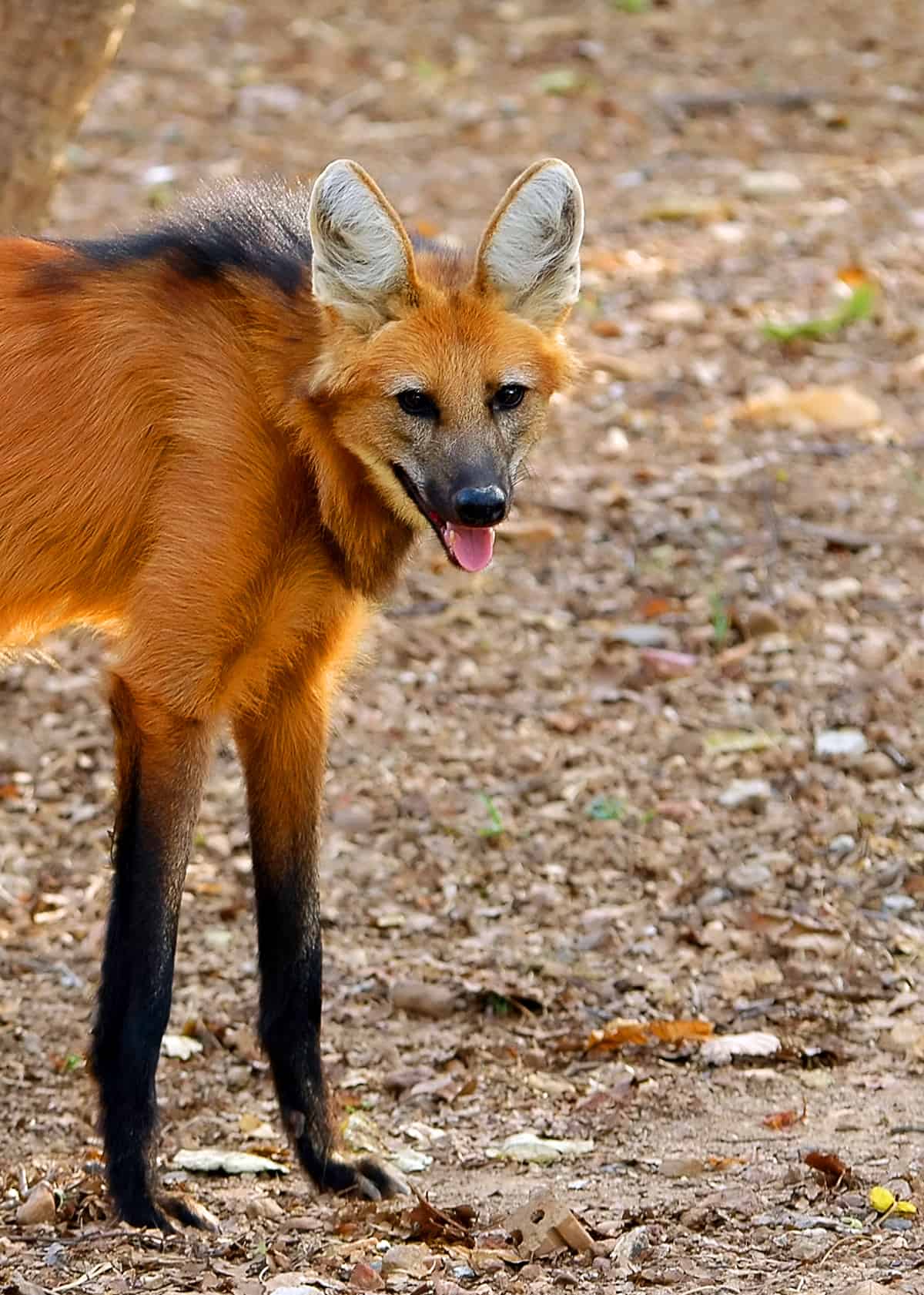
The tallest wild canid (dog-like mammal) in the world, the maned wolf features a medley of traits that are similar to the wolf, fox, coyote, jackal, and dog.
In addition to its reddish-brown coat, long black legs, and large ears, the maned wolf has a black mane that trails from head to shoulders and stands up straight when the animal senses a threat.
This canid species is also known for its distinctive urine odor that it uses to mark its territory.
It’s gained it the nickname “skunk wolf,” even though the urine doesn’t really smell like a skunk.

It’s actually been described as smelling like marijuana.
So much so, in fact, that police were once called to a zoo in the Netherlands to find a weed smoker… even though it was just maned wolf pee!
Unlike other wolves, the maned wolf doesn’t form packs but prefers to remain solitary or in mating pairs.
It is also monogamous, mating with the same partner for life.
18. Saiga Antelope
- Latin name: Saiga tatarica
- Unique weird feature: Permanently swollen nose
- Where they’re found: Asia and southeastern Europe
- Size: Head and body length: 39 to 55 inches; Height: 24 to 32 inches at the shoulder; Weight: 57 to 152 pounds
- Diet: Herbs, shrubs, and lichens
No, this antelope doesn’t have a deformed or swollen nose. It’s supposed to look huge and humped over the mouth.
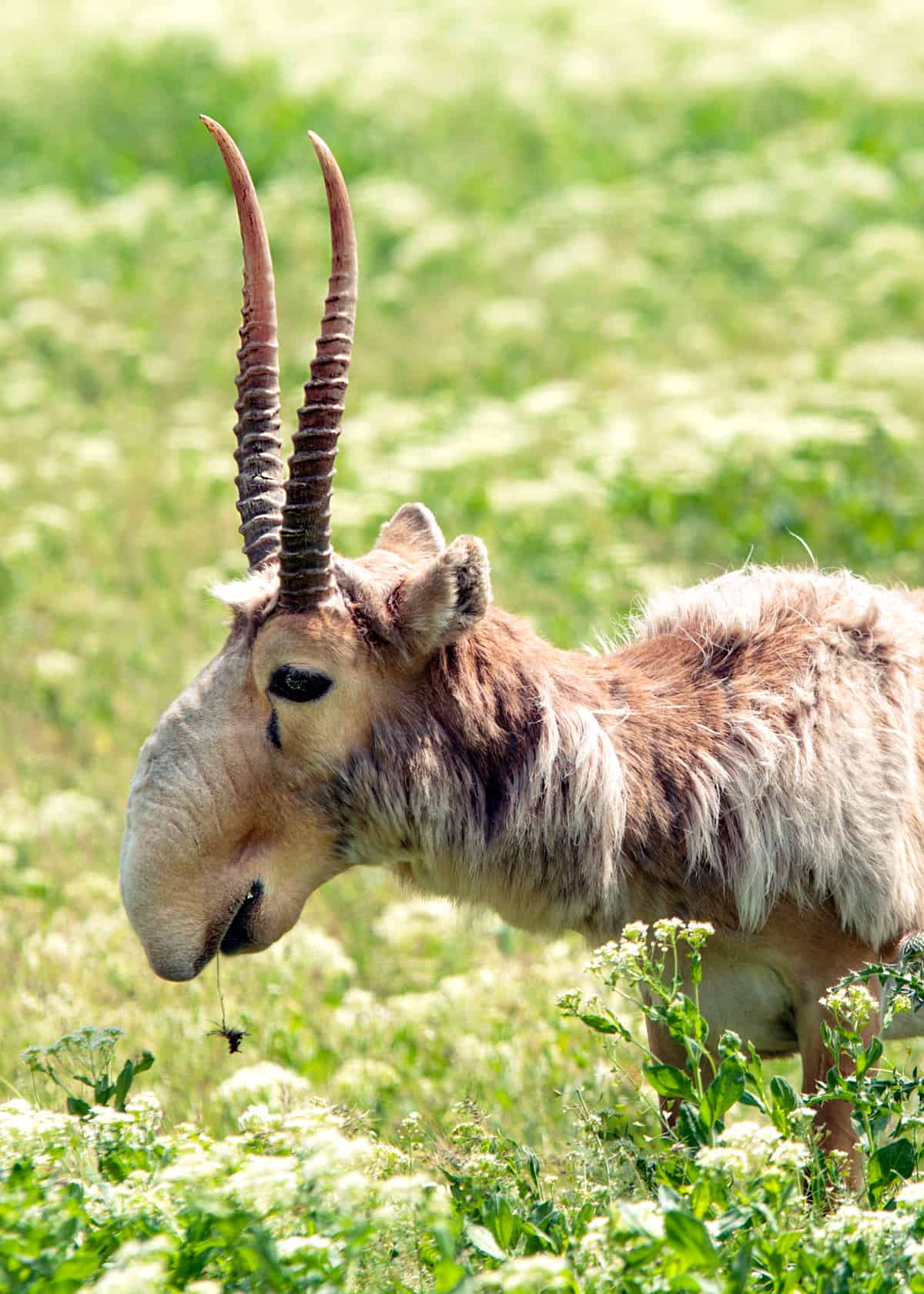
This weird-looking nose serves the purpose of protecting the saiga’s lungs from getting filled up with dust in the deserts and arid grasslands where it lives. It also cools hot summer air and warms cold winter air.
And it helps in mating season. Females normally choose the males with the biggest, squishiest nose!
Saiga antelopes are about the size of a goat and are covered in light brown fur. The males have vertical horns that they use for fighting other males during mating season which often ends in death.

They travel in herds of around 30 to 40 individuals that usually consist of a dominant male and his harem of females and their young.
Saigas are well known for their long, annual migrations where they can cover up 72 miles per day by running and swimming across rivers.
19. Lowland Streaked Tenrec
- Latin name: Hemicentetes semispinosus
- Unique weird feature: Communicates with its quills
- Where they’re found: Madagascar
- Size: Length: 5.5 to 6.8 inches: Weight: 4.4 to 9.9 ounces
- Diet: Earthworms and insects
Among the many other weird animals living in Madagascar is the lowland streaked tenrec.
This odd-looking creature has been described as a hedgehog mixed with honey bee, which definitely seems fitting to me! 🐝
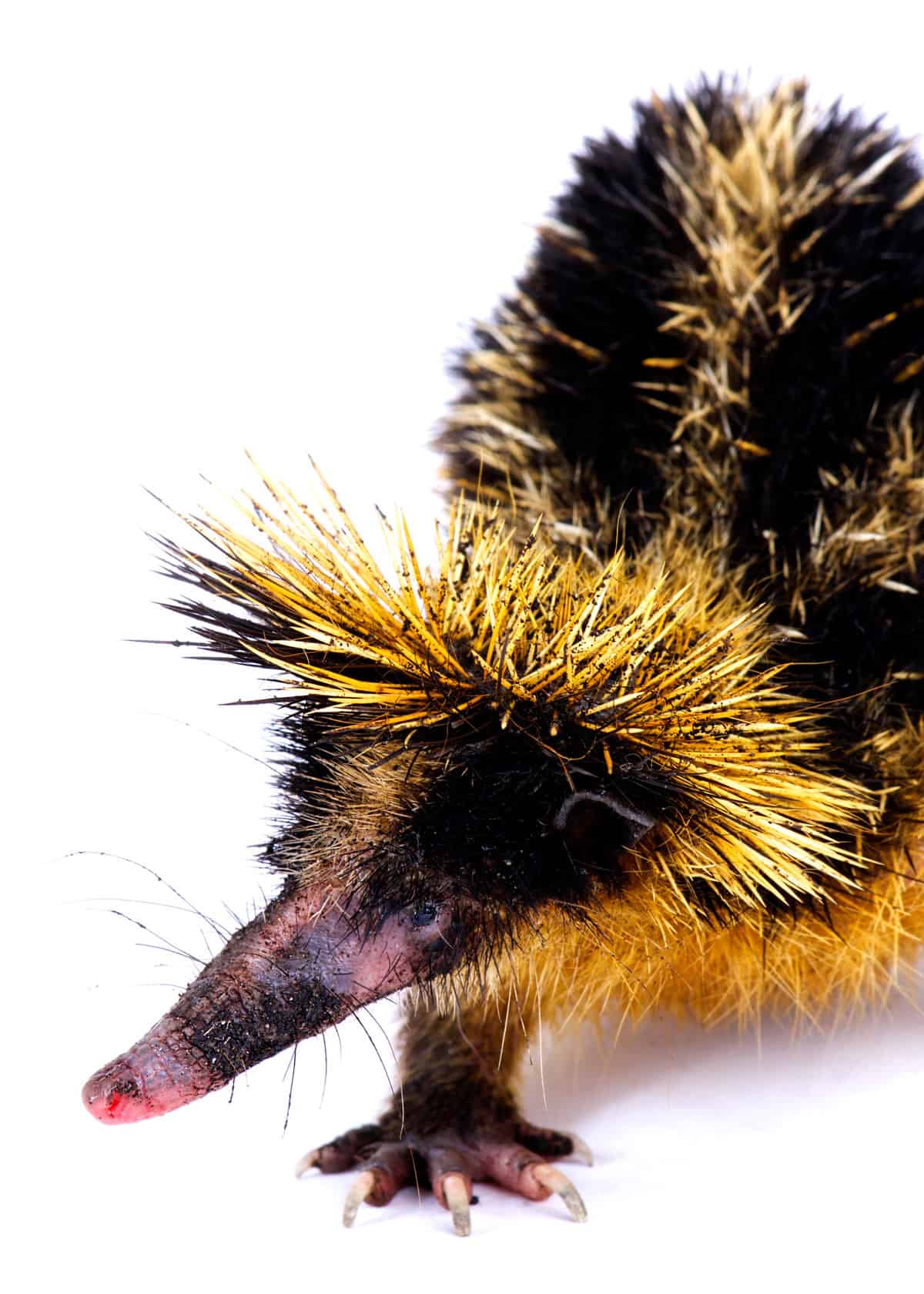
It has black fur and yellow stripes, a long snout and limbs.
Along its back are barbed and detachable quills that this tenrec uses against predators.
Lowland streaked tenrecs live in groups of about 20 members where they spend their days sleeping in tunnels or digging for insects and earthworms by night.
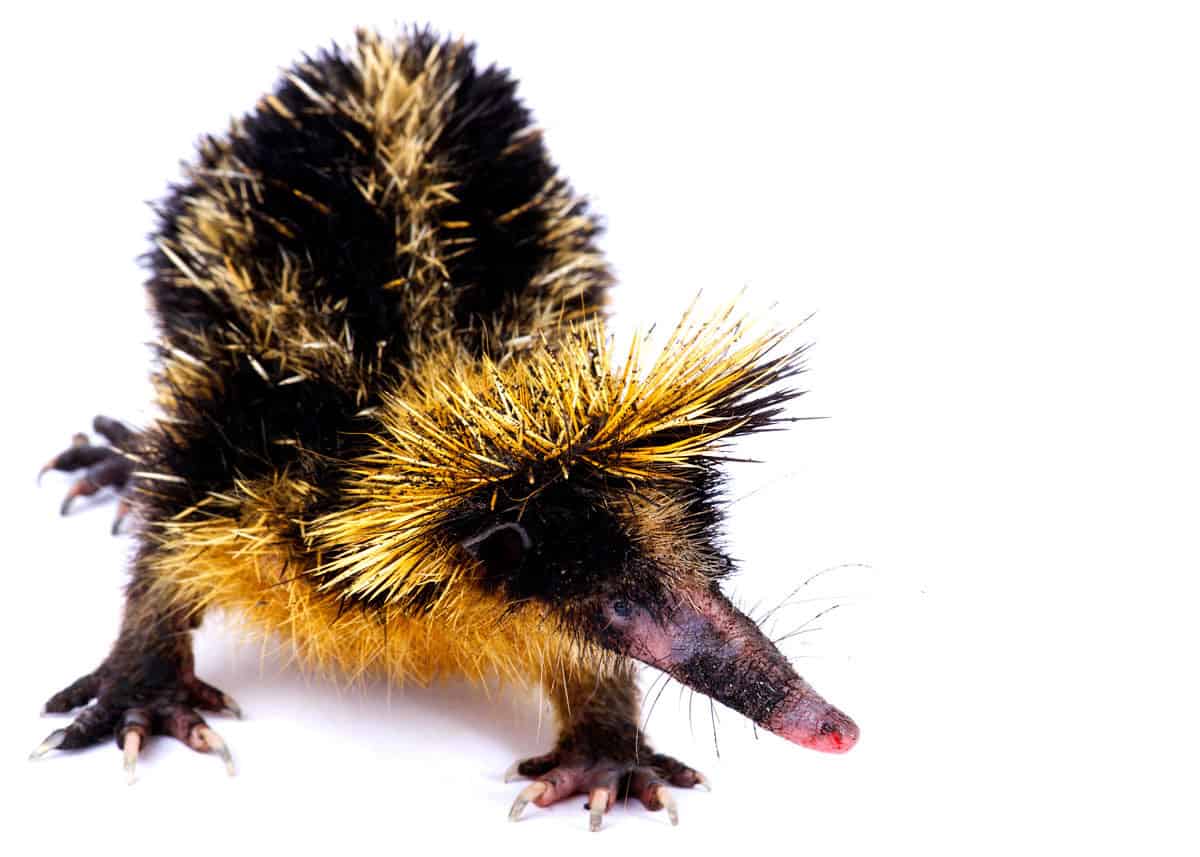
They communicate with each other by rubbing their quills together to create low-pitched noises.
This feature is common among insects and snakes, but the lowland streaked tenrec is the only mammal in the world that does it.
20. Platypus
- Latin name: Ornithorhynchus anatinus
- Unique weird feature: Venomous mammal with a bill and feet like a duck
- Where they’re found: Australia (including Tasmania)
- Size: Avg. length: 20 inches; Weight: 2 to 5 pounds
- Diet: Annelid worms, insect larvae, freshwater shrimp, and freshwater yabby
The platypus looks so unbelievable that when British scientists were first shown drawings and live specimens of it, they thought it must be a joke.
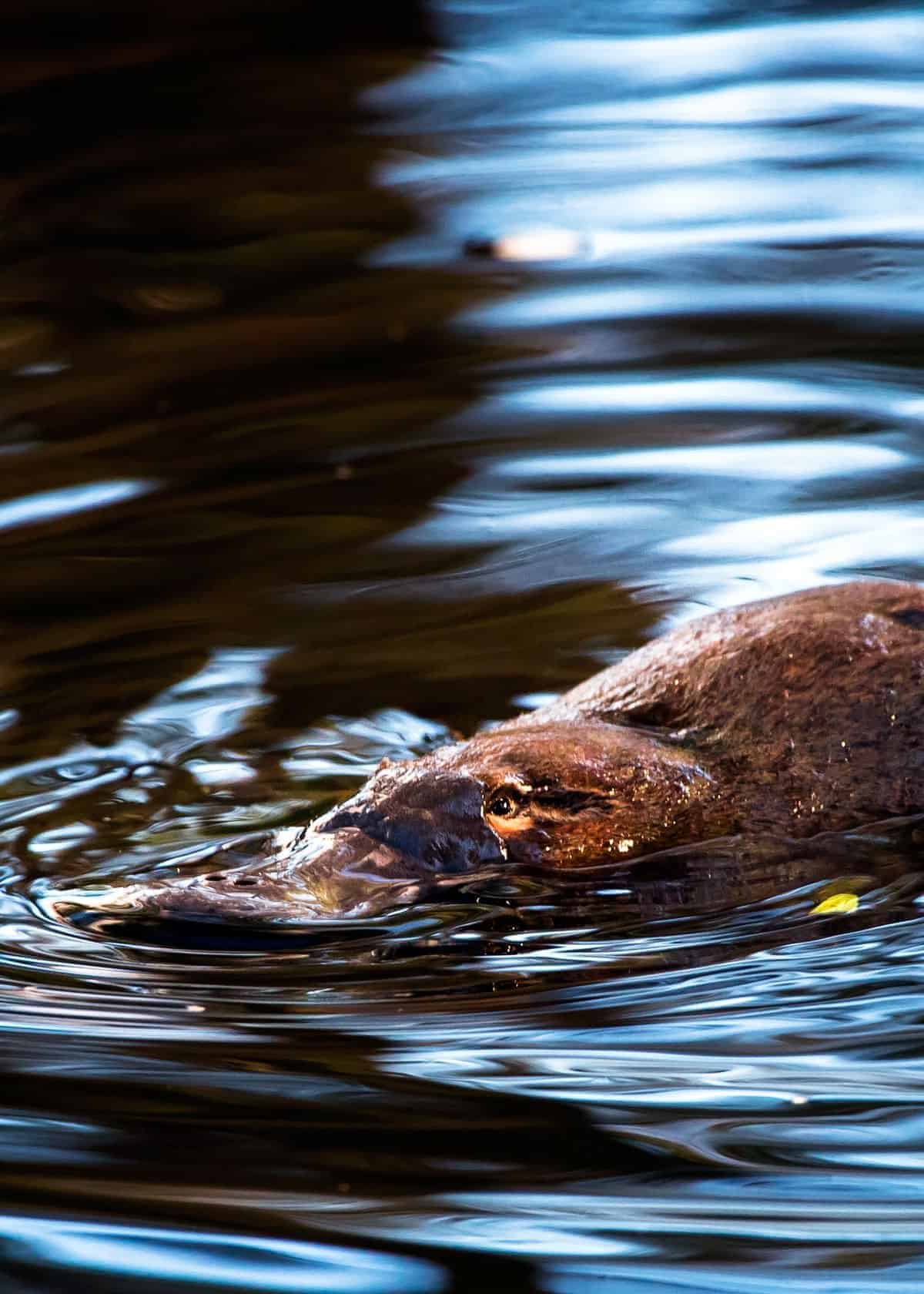
It’s a semi-aquatic mammal with a bill and webbed feet like a duck, fur like an otter, and a tail like a beaver. It also lays eggs, which is odd for a mammal.
Topping all that, the male platypus is venomous. The male has a spur on the back of its hind foot that can produce venom powerful enough to kill a small animal.
The venom can cause humans severe pain, but it won’t kill you.

The platypus is a great swimmer. It dives underwater to forage for food and then carries it to the surface by holding in their cheek pouches.
It swims with its ears, eyes, and nose closed because its bill is equipped with sensitive cells that can sense prey.
Learn more about other animals that lay eggs.
Weird Reptiles & Amphibians
21. Black Rain Frog
- Latin name: Breviceps fuscus
- Unique weird feature: Perpetual frown and puffs up like a balloon
- Where they’re found: South Africa
- Size: Length: 2 inches
- Diet: Arthropods and worms
I bet you’ve never been mean-mugged by a frog before… unless you’ve come face to face with the black rain frog.
Covered in bumpy black skin, this unusual frog retains a permanent frown on its face – it’s got that #restinggrumpface. However, it has several interesting traits that might give you a smile.
Found only the Cape Fold Mountains of South Africa, this little fellow is different from other frogs because it retains its tail while growing from a tadpole to a grown-up frog. It also has a cleft tongue and is able to fold its legs beneath its body.
It has a clever ability to defend itself against predators by puffing itself up like a balloon. It also does this when its creating tunnels to prevent being captured.
22. Marine Iguana
- Latin name: Amblyrhynchus cristatus
- Unique weird feature: The only iguana that feeds in the ocean
- Where they’re found: Galápagos Islands
- Size: Body length: 4.7 to 22 inches; Tail length: 6.7 to 33 inches; Weight: 2.2 to 26 pounds
- Diet: Red and green algae
When visiting the Galapagos Islands, you’ll want to be cautious about nodding at the marine iguana.
Nodding is an important form of communication for this reptile, and it will either think you’re challenging it to a fight or that you’re asking it out on a date.
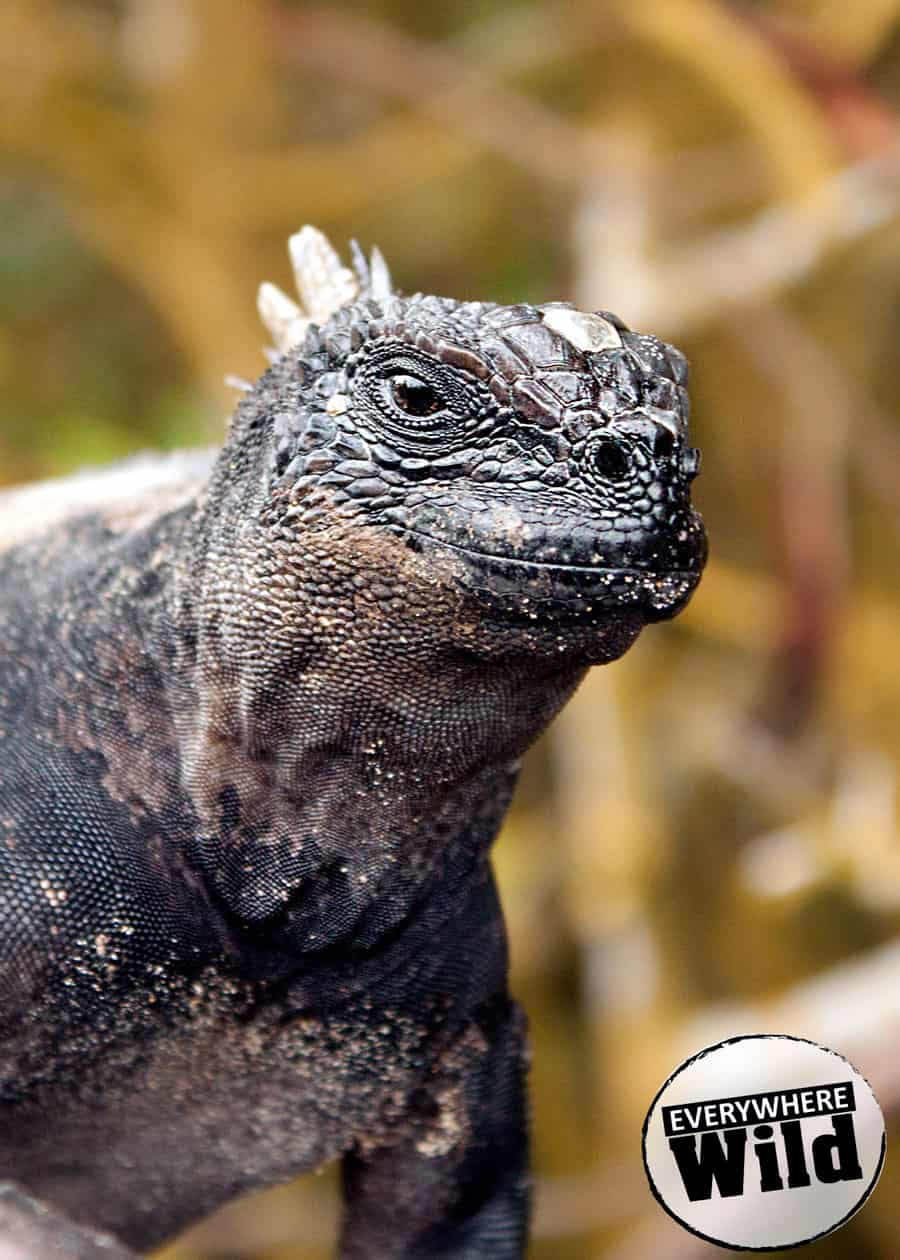
You’re most likely to see these black iguanas in large colonies, sunning on lava rocks after diving in the cold water for algae.
Do you mean iguanas feed in the ocean!? These are the only ones in the world that do.
Another amazing fact is that marine iguanas may have been one of the inspiration for Godzilla!
That white stuff on their spiky backs is dried salt that they sneeze and snort out.
During mating season, the males turn into a rainbow of colors as a way of attracting females.
23. Glass Frog
- Latin name: Centrolenidae
- Unique weird feature: See-through skin, karate skills
- Where they’re found: Mexico, Central and , outh America
- Size: Length: Varies by species from 0.78 to 3.0 inches
- Diet: Spiders and insects with soft bodies
It’s called a glass frog because you can see through its translucent belly skin where its internal organs are visible.
There are about 60 different varieties of glass frogs, and they range in size and shades of green. Some also have spots.

They usually come down from the trees to mate. Afterward, the female lays eggs on the underside of a leaf that hangs over the water.
The male guards the eggs from predators like insects and parasites.
One of the most amazing displays is when the dad kicks hornets away from his eggs. It’s gutsy, and dangerous. But it gets the job done!
After hatching, the tadpoles will drop down into the water until they evolve into mature frogs.
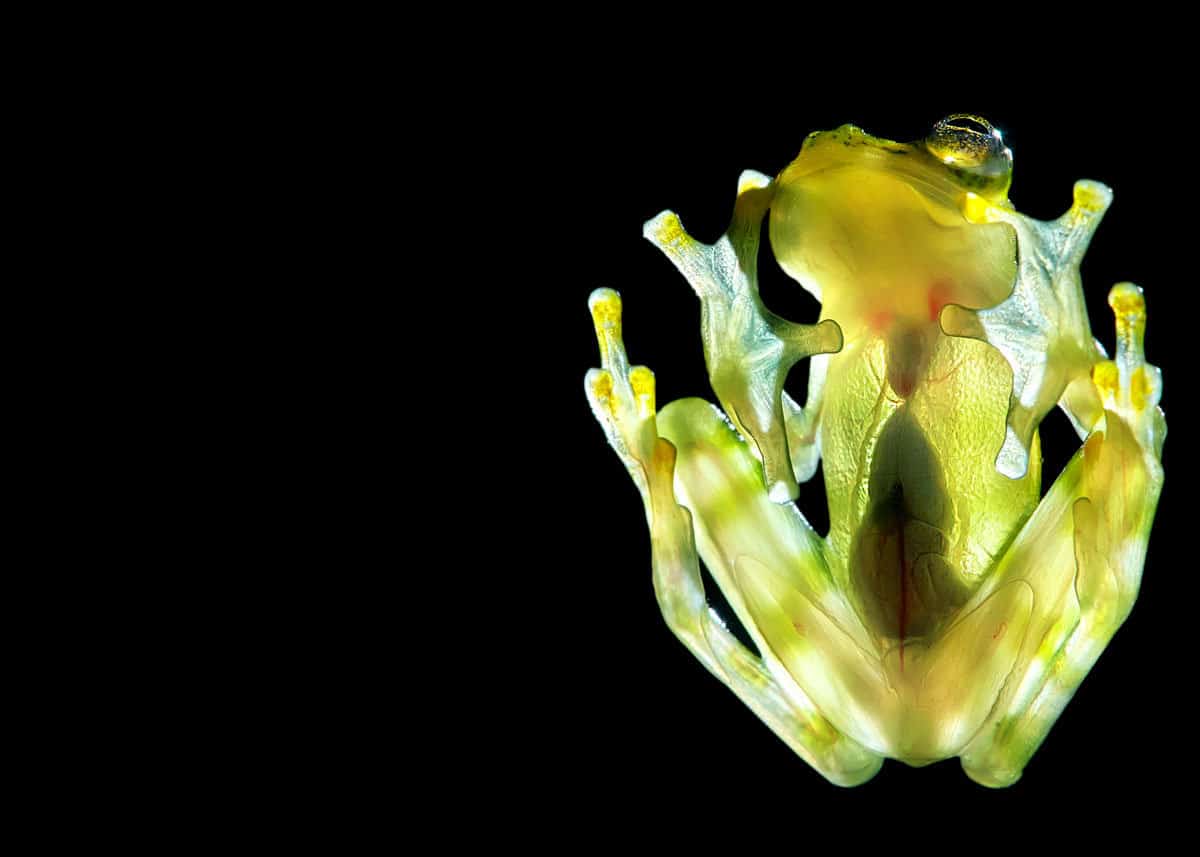
Glass frogs like hanging out in rainforest trees above water in Central and South America where they feed on insects during the twilight hours.
24. Satanic Leaf-Tailed Gecko
- Latin name: Uroplatus phantasticus
- Unique weird feature: Looks exactly like a leaf
- Where they’re found: Madagascar
- Size: Length: Up to 3.5 inches (including tail)
- Diet: Insects such as moths, crickets and spiders
Its name sounds like a pretty scary creature, but the satanic leaf-tailed gecko is in reality just a type of lizard that likes to stay hidden in the trees where it can snooze without being disturbed.
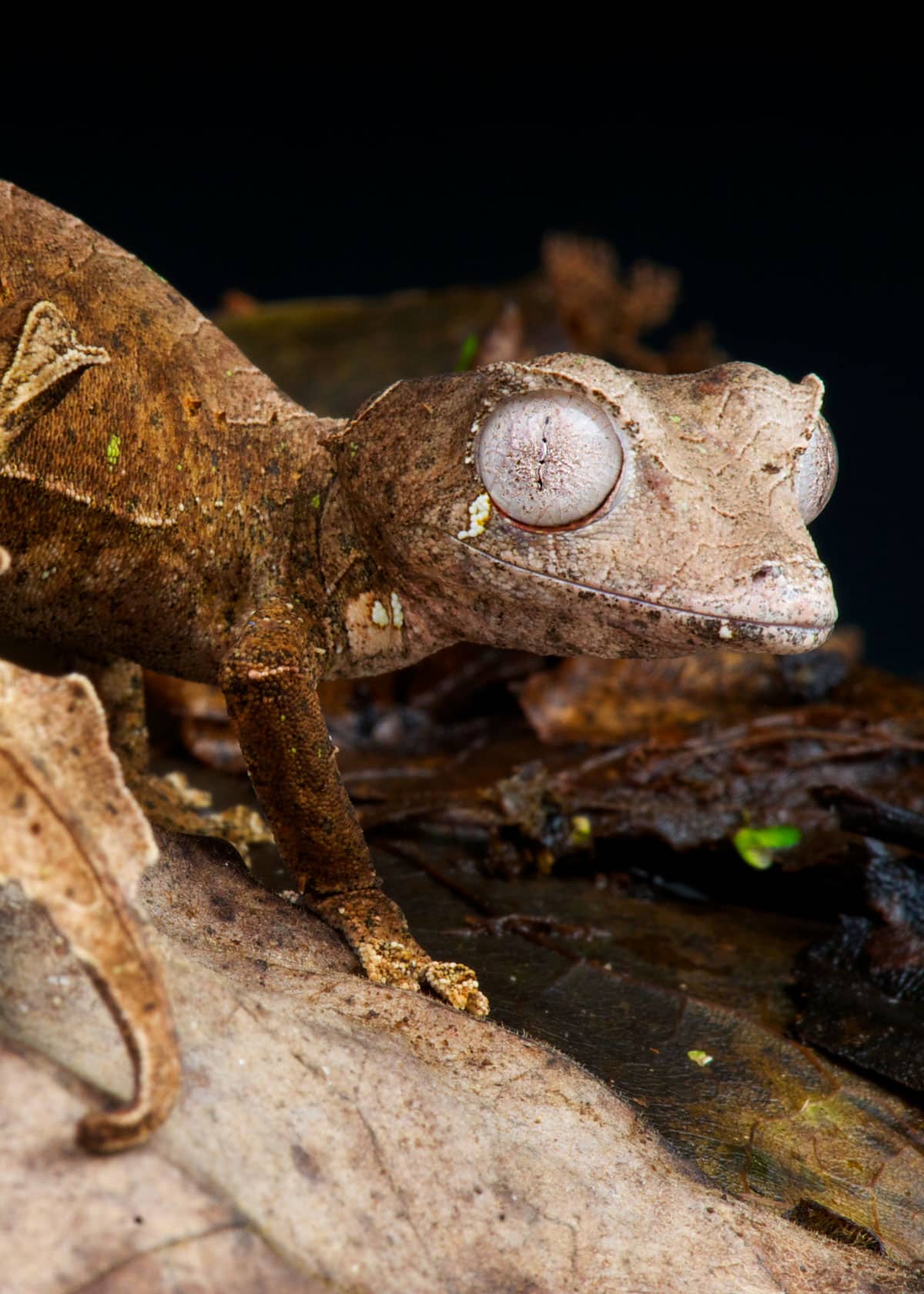
Living only in Madagascar, this gecko is a master of disguise.
As its name suggests, its tail perfectly resembles a leaf by its shape, coloring, and even the appearance of insect damage.
The gecko’s mottled brown body also looks like a leaf. It features markings that even look like the veins of a leaf.
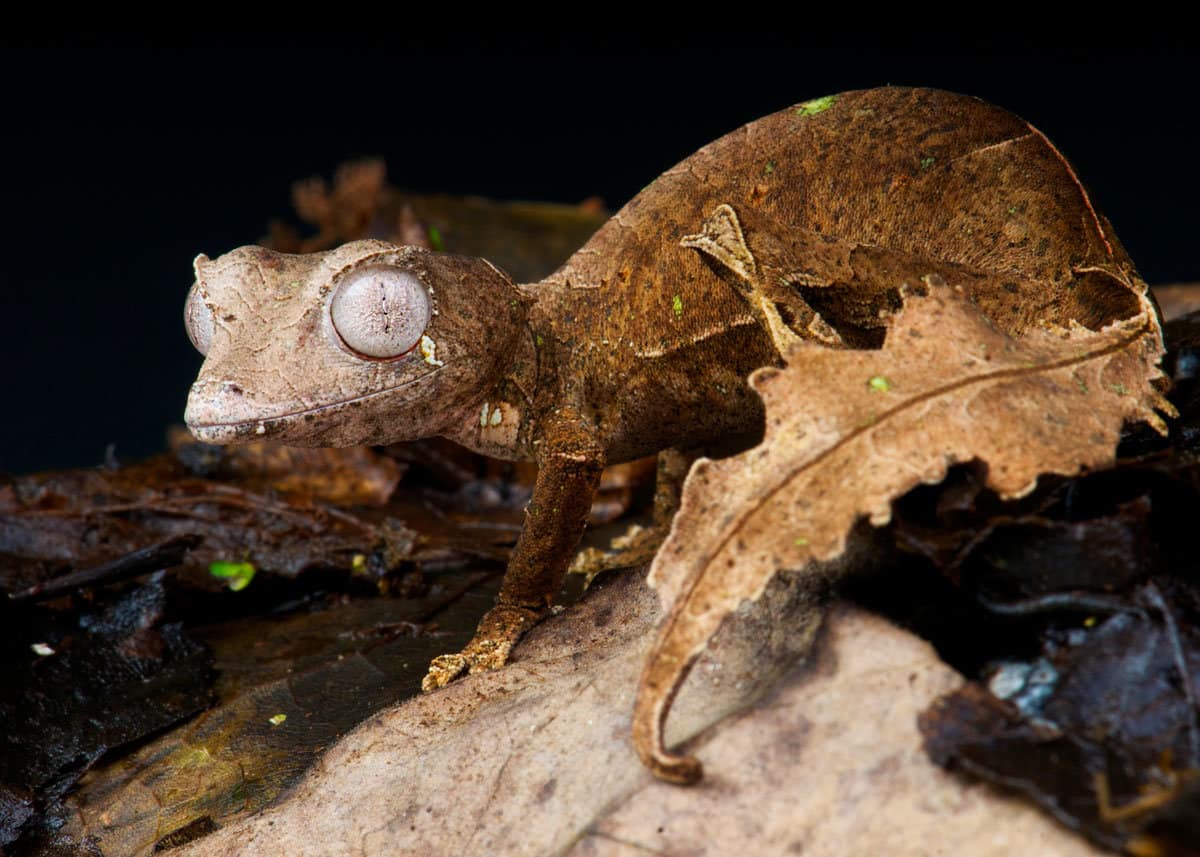
So, why are these geckos called satanic? The reason is that some individuals of this species sport horny projections on their head and large reddish eyes. Plus, they feed at night.
But, they’re quite harmless… unless you’re a cricket or spider.
25. Madagascar Leaf-nosed Snake (Langaha nasuta)
- Latin name: Langaha nasuta
- Unique weird feature: Bizarre, leaf-looking nose
- Where they’re found: Madagascar
- Size: 2 to 3 feet
- Diet: Tree lizards
Yet another of Madagascar’s many weird animals is the Madagascar leaf-nosed snake. This long, mottled brown snake is aptly named for the bizarre snout appendage attached to its head.
The snout of the female is more flattened and leaf-shaped while that of the male is longer and more tapered.
These snakes have baffled scientists, and no one really knows the function of their strange noses beyond differentiating the sexes. Sometimes, the snakes are seen hanging upside down from branches as if their noses serve to drain water.
This leaf-nosed snake is an ambush predator, spending most of its time motionless in the trees, waiting for a lizard to come scuttering by before attacking it.
26. Thorny Devil
- Latin name: Moloch horridus
- Unique weird feature: A false head
- Where they’re found: Australia
- Size: 7.9 inches
- Diet: Mostly ants
Also called the thorny dragon, the thorny devil is a spiky lizard that lives in the desert scrubland of Australia.
It derives its common name from the two large, horned scales on top of its head while its scientific name, Moloch, comes from an ancient Middle Eastern deity.
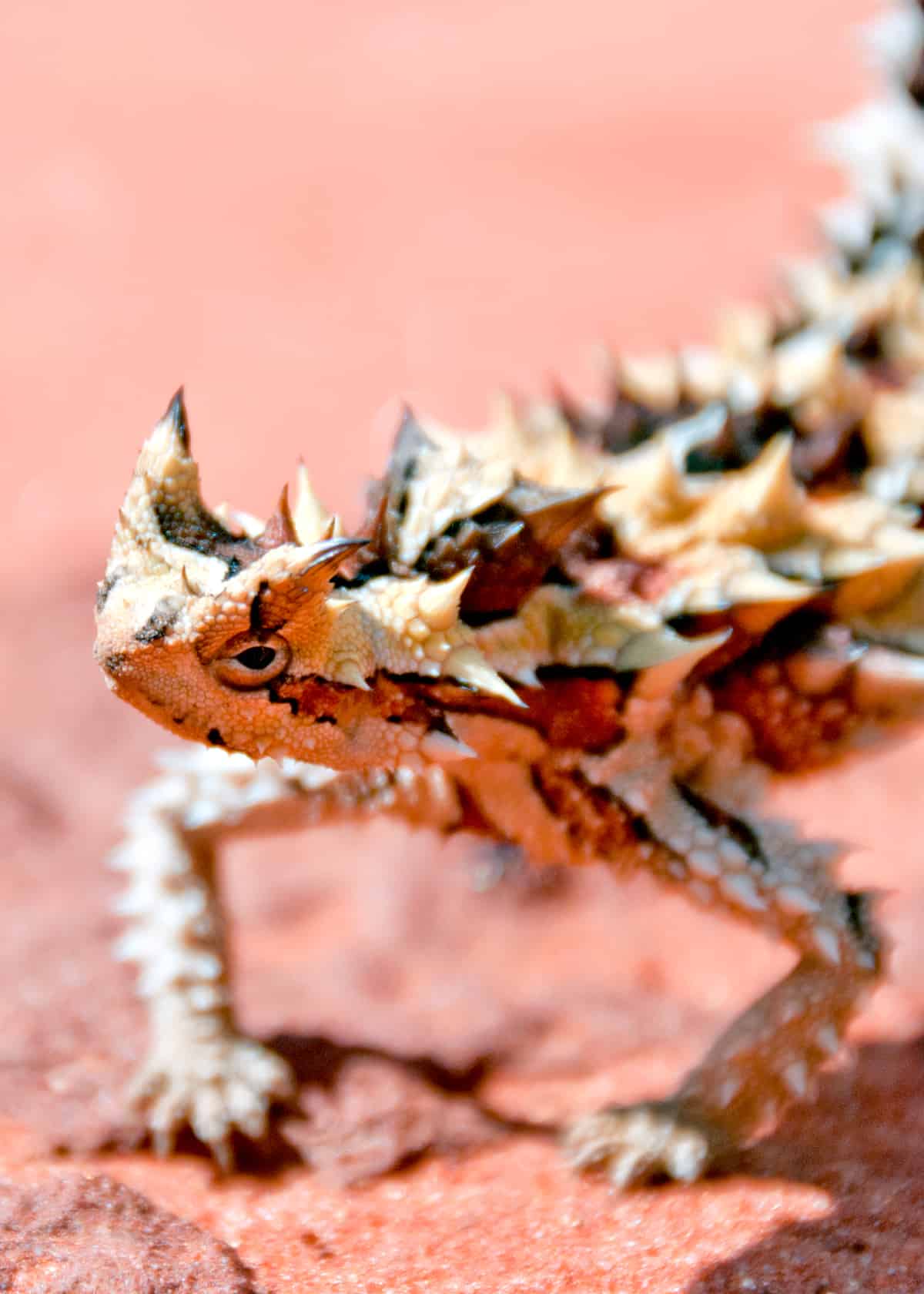
This lizard loves eating ants and can eat thousands of them a day by snatching them up with its sticky tongue.
The thorny dragon is an intriguing creature that has several tricks up its sleeve for deterring predators. For one, its skin is covered in spikes which would make anyone think twice before biting into it.
It can also puff itself up to make it appear difficult to swallow. It also uses a funny walk to confuse predators that involve freezing, rocking and jerky movements.

Last but not least, they have a knobby appendage on their shoulders that’s called a “false head.”
If the thorny dragon is threatened, it hides its real head between its forelegs, leaving the false head upright to deceive its offender.
27. Mexican Mole Lizard
- Latin name: Bipes biporus
- Unique weird feature: Self-amputates its tail for protection
- Where they’re found: Baja California Peninsula.
- Size: Length: 7.1 to 9.4 inches:
- Diet: Ants, termites, insects, earthworms, larvae, and small lizards
Is it an earthworm? Is it a lizard or a snake? This long, pink creature is a worm-like lizard that lives mostly underground in Baja, California.
Growing to nine inches, it has segmented skin like an earthworm but short forelegs and claws like a lizard. Like a snake, it has no hind legs.
The Mexican mole lizard rarely comes to the earth’s surface, but when it does, it’s usually at night or following heavy rainfall. It feeds on ground-dwelling prey such as ants, termites, worms, larvae, and lizards.
It’s the perfect meal for snakes, so to defend itself, it can self-amputate its tail, leaving it plugged in a burrow hole to give itself time to escape.
The only problem with that is the tail is not regenerating, meaning the lizard can only use this tactic once in its life.
28. Pig-nosed Turtle
- Latin name: Carettochelys insculpta
- Unique weird feature: Pig-like snout
- Where they’re found: Northern Australia and southern New Guinea
- Size: Length: Up to 28 inches; Weight: 44 pounds
- Diet: Fruit and leaves of figs, crustaceans, mollusks and insects
This turtle may look funny with its pig-like snout, but there’s plenty of reasons to not laugh at it.
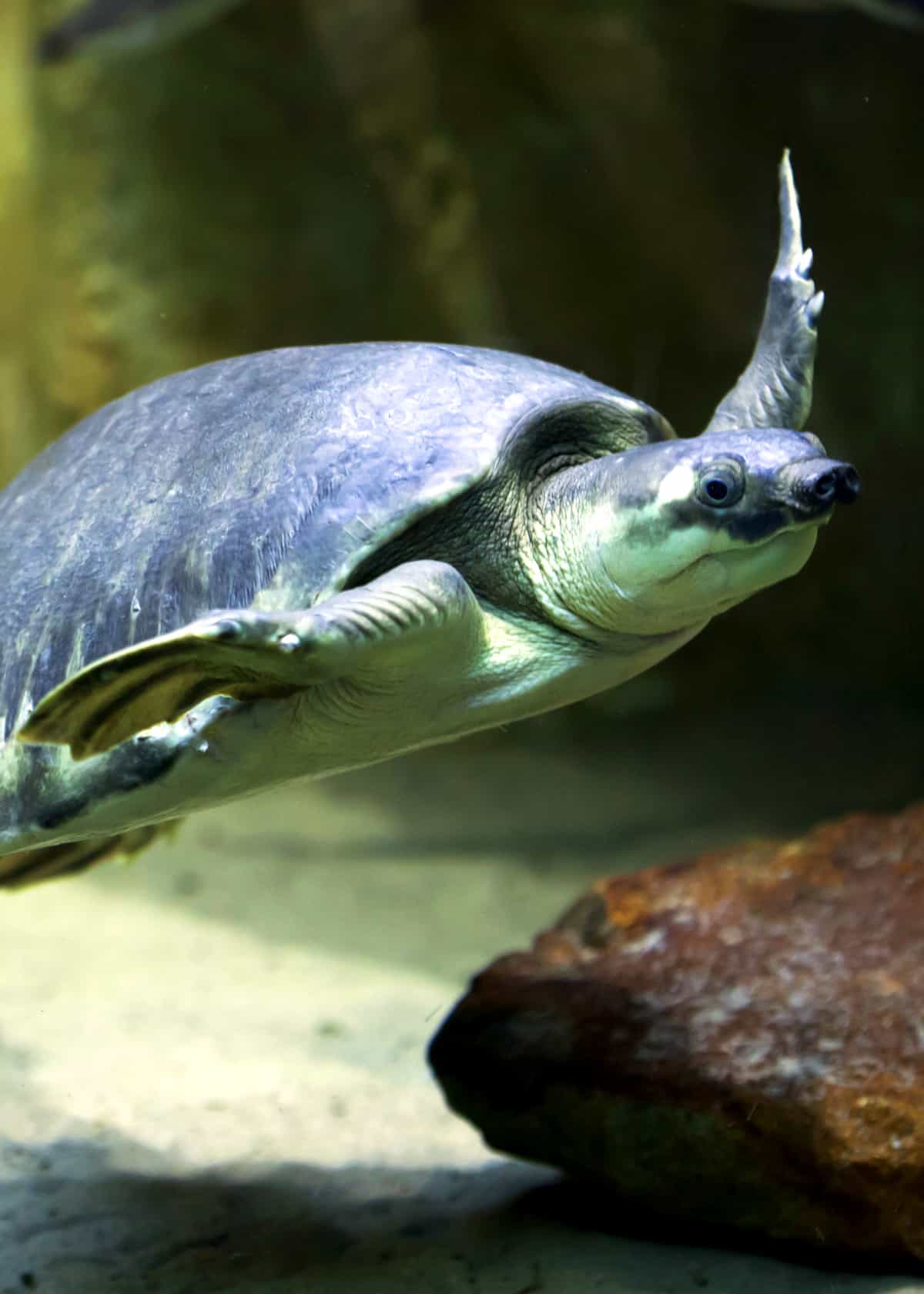
The turtle uses its snout as a snorkel to breathe underwater as well as to detect prey in murky water.
Found in rivers in northern Australia and Papua New Guinea, this freshwater turtle has flippers like a marine turtle. Besides its distinctive snout, it has big round eyes and a leathery, olive-gray shell.
This turtle spends most of its time in the water except to lay eggs which are between 4 and 40 at a time.
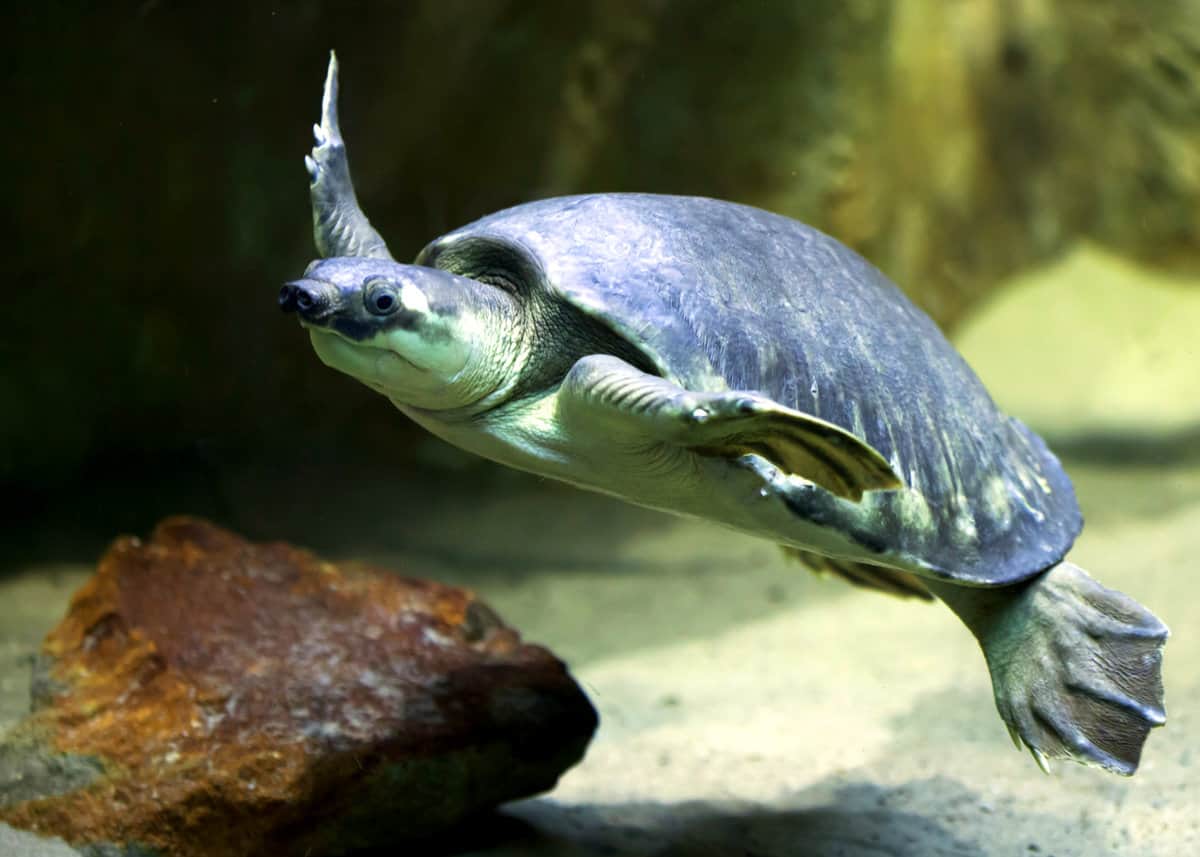
The eggs don’t hatch until the nest is flooded at the beginning of the wet season.
Like many other reptiles, the gender of the pig-nosed turtle babies is determined by the temperature of the nest.
29. Spiny Bush Viper
- Latin name: Atheris hispida
- Unique weird feature: Spiky skin and powerful venom
- Where they’re found: Congo, Uganda, and Kenya
- Size: Length: 18 to 23.6 inches
- Diet: Rodents, birds, lizards, and frogs
This African snake may be on the small size, but it delivers a powerful venom which can induce severe internal bleeding.
There are three subspecies of this snake that vary in size, color, and habitat, but they’re usually green, brown or bluish in color. They mostly prefer to hang out in flowering bushes of the rainforest.
The “spiny” part of their name comes from the heavily keeled dorsal scales that give it a spiky appearance. They also have prehensile tails which they use to grasp branches as they maneuver through vegetation.
Spiny bush vipers are ambush predators that patiently wait for their food to come ambling by unaware. Just before it attacks, the snake curls itself into the shape of the letter “S.”
A bite from one of these snakes may be fatal for humans, but fortunately, spiny bush vipers prefer to not live nearby human settlements.
30. Japanese Giant Salamander
- Latin name: Andrias japonicus
- Unique weird feature: Enormous salamander that smells like a Japanese pepper
- Where they’re found: Southwestern Japan
- Size: Length: Up to 5 feet; Weight: Up to 55 pounds
- Diet: Insects, frogs, crayfish, worms, fish and smaller salamanders
Imagine a salamander reaching 5 feet in length and weighing up to 55 pounds. That sounds like a whopper of a tale, but they’re real and alive in Japan.
In fact, these Japanese giant salamanders are the second-largest amphibians in the world.
The giant salamander’s common Japanese name means “giant pepper fish” because when it’s stressed or threatened, it secretes a white, sticky substance with an odor that smells like Japanese peppers.
Because they don’t have gills, these salamanders live in streams and rivers of cold, fast-flowing water with lots of oxygen.
They’re almost always submerged, but they can survive outside the water for as long as their skin remains moist.
Their eyesight is poor, so they rely on special sensory cells that detect vibrations in their environment.
2. Purple Frog
- Latin name: Nasikabatrachus sahyadrensis
- Unique weird feature: Purple body, cone head, and fluted tongue
- Where they’re found: Western Ghats of India
- Size: Up to 3 inches
- Diet: Termites
Found in the Western Ghats of India, the purple frog looks more like a slimy, dark purple cow liver than a frog.
It has a plump, bloated body with short, shovel-shaped legs that it uses to dig underground burrows. It has even been dubbed the doughnut frog.
Its cone-shaped head is tiny in comparison to the body with tiny eyes and a pointed snout that it uses to bore into termite tunnels. It then uses its fluted tongue to suck up the insects.
The purple frog lives most of the year in underground burrows. It only comes out to mate which is usually during the monsoon season.
When it’s resting, it tucks its legs under its body in a parallel position.
33. Gharial
- Latin name: Gavialis gangeticus
- Unique weird feature: Long, sword-like snout
- Where they’re found: Northern parts of the Indian subcontinent.
- Size: Length: 11 to 20 feet; Weight: 351 to 551 pounds
- Diet: Fish, frogs
En garde! Care for a fencing match? The gharial is a crocodilian species that looks like it’s always ready for a duel because its snout resembles a long, skinny sword with more than 100 razor-sharp teeth.
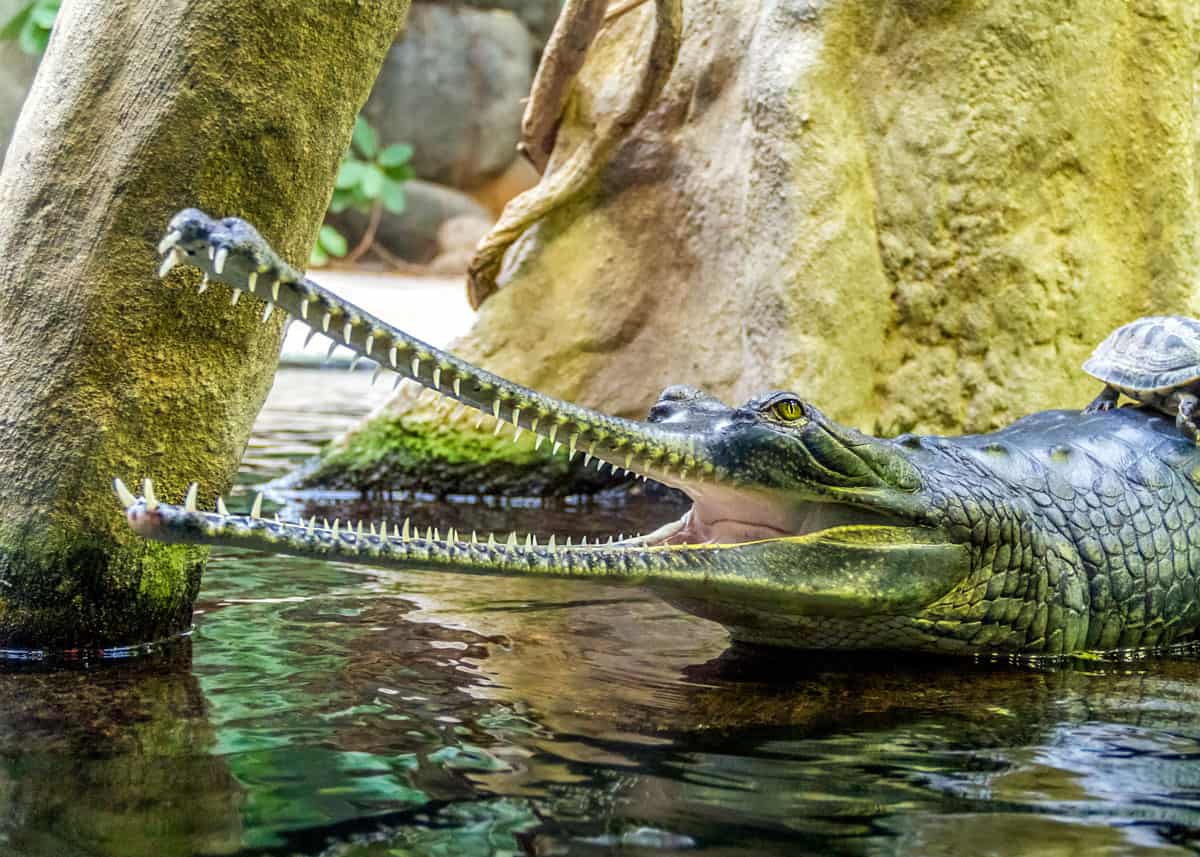
The male has a bulging growth on the end of his snout that resembles a type of Indian pot that’s called a “gharha” – from which its name is derived.
Living in fast-flowing rivers of northern India, the gharial is a huge beast that can weigh up to 550 pounds. It gets around by pushing forward and gliding on its belly.
During courtship, males and females rub their snouts together to express a language of love with buzzing and hissing noises.
The male also charms the female by blowing bubbles for her through his bulbous snout. How charming!
Gharial females lay between 20 and 95 eggs in the sand which are the largest eggs of all the crocodilian species.
34. Cantor’s Giant Softshell Turtle
- Latin name: Pelochelys cantorii
- Unique weird feature: Enormous turtle with a soft shell, razor sharp beak
- Where they’re found: Currently believed to be only in Laos
- Size: Length: Up to 6 feet; Weight: 550 pounds
- Diet: Crustaceans, mollusks, fish, and some aquatic plants
Named after the Danish zoologist, Theodore Edward Cantor, the Cantor’s giant softshell turtle is, well simply put, a giant softshell turtle.
Growing to a length of six feet and weighing up to 550 pounds, this enormous turtle has a smooth, olive-green shell that looks somewhat flattened.
It also has large forelimbs, a broad head, small eyes, and a pointy snout. This giant softshell turtle is regarded as one of the world’s largest freshwater turtles.
However, it’s listed by the IUCN as endangered because it has disappeared from several Asian countries where it once lived in abundant numbers. In recent years, the only sightings of it have been in Laos.
It makes its home in slow-moving streams and rivers, spending nearly all its time buried in the wet sand with only its eyes and mouth above the surface. It feeds on aquatic plants and ambushes crustaceans, mollusks, fish with its fast and powerful bite.
35. Surinam Toad
- Latin name: Pipa pipa
- Unique weird feature: Babies grow inside their mother’s skin
- Where they’re found: South America and the Caribbean
- Size: Length: 4 to 5 inches
- Diet: Small fish, crustaceans, worms, and other invertebrates
Watch where you step if you go exploring in the swamps and streams of the Caribbean or South American rainforests. What appears to be a mottled brown leaf may actually be the Surinam toad.
It has slippery, warty skin, but unlike other toads, it has a flat body and rests in a splayed position.
Surinam toads can stay underwater for up to an hour before needing to come to the surface to breathe.
After locating prey in the water with their long, sensitive toes, they stuff it into their mouths and swallow it whole.
Surinam toads have unusual reproductive habits. While mating, they perform somersaults in the water. During this ritual, the female releases about 100 eggs and the male fertilizes them.
Right away, the fertilized eggs become embedded into pockets of the mother’s skin where they develop for about four months and then emerge as tadpoles.
Warning: If you have trypophobia (or fear of holes), I would suggest not watching this video. Otherwise, it’s fascinating – if not a little disturbing :).
36. Eastern Long-necked Turtle
- Latin name: Chelodina longicollis
- Unique weird feature: Snake-like neck that pulls into the body sideways
- Where they’re found: South and eastern Australia
- Size: Length: 10 inches
- Diet: Insects, worms, tadpoles, frogs, small fish, crustaceans, and mollusks
These brownish-black turtles from the east and south Australia are also called snake-necked turtles due to their unusually long necks ( up to 6 inches) that they pull in sideways rather than directly.
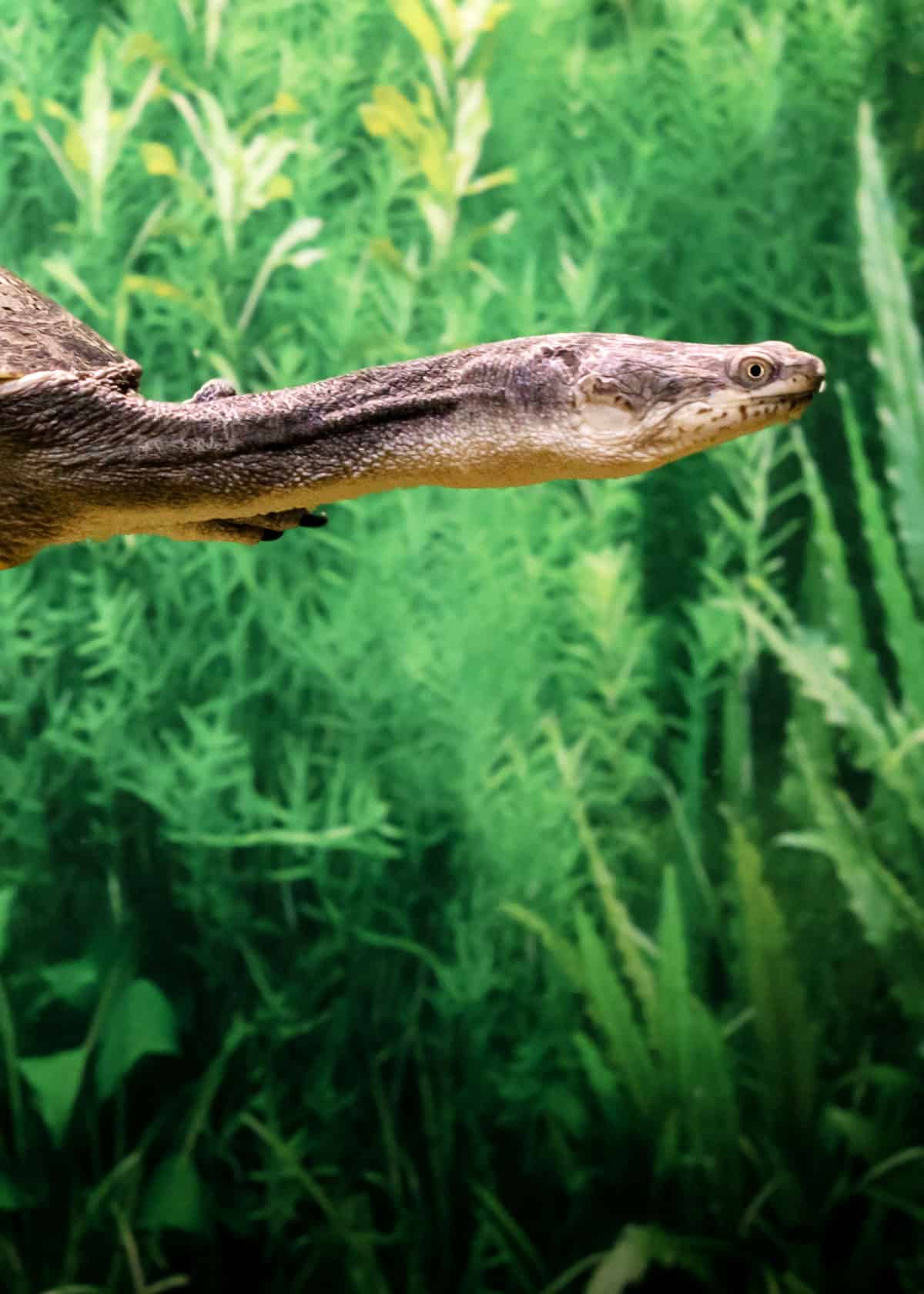
Living in a variety of water bodies, they’re opportunistic feeders that strike and prey upon fish, frogs, and crayfish with their powerful jaws and claws.
If threatened, they emit an unpleasant, musky odor from the glands in their groin and armpits.
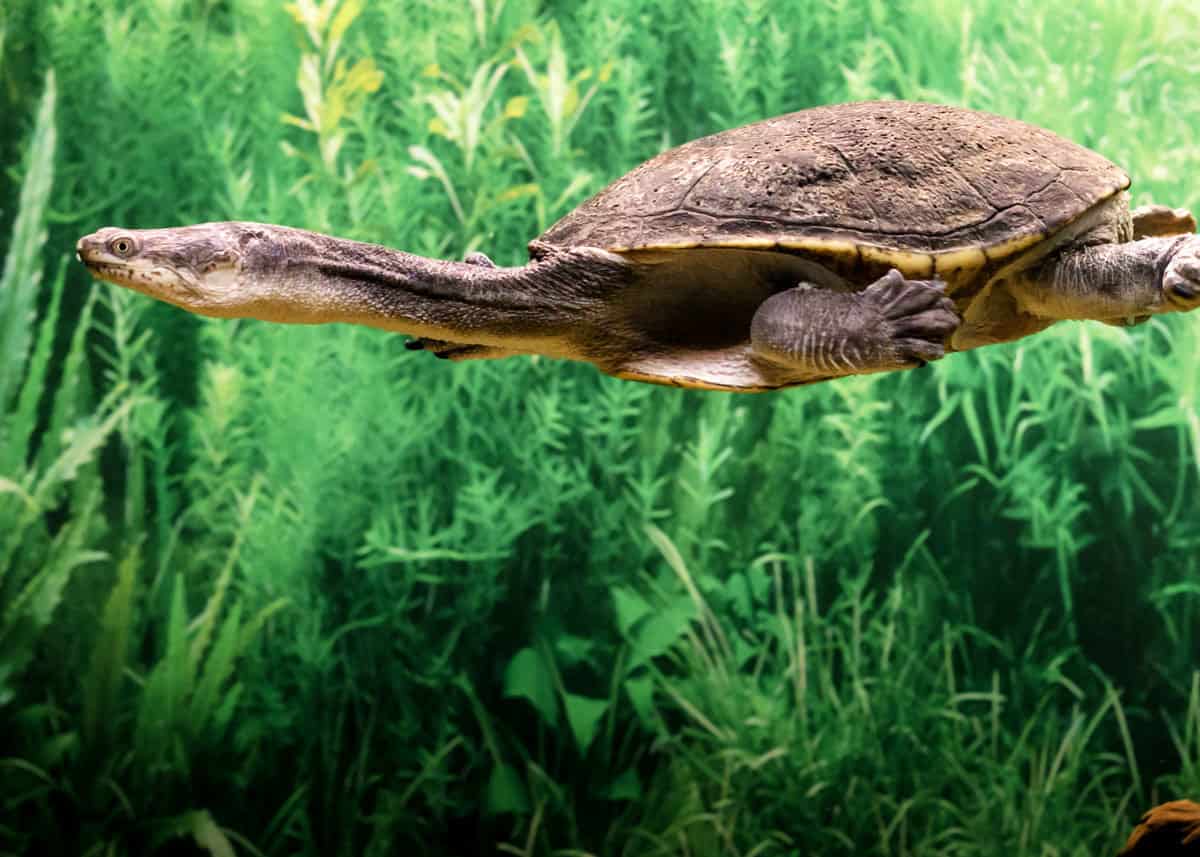
They breed in the summer and lay a clutch of 2 and 10 eggs in the sandy banks about three times per year.
Unfortunately, some of these eggs are eaten by birds, lizards, water rats, and large fish.
37. Blue Tongue Skink
- Latin name: Tiliqua
- Unique weird feature: Long, bright blue tongue
- Where they’re found: Australia, New Guinea, and some Indonesian islands
- Size: Length: 24 inches; Weight: 10 to 18 ounces
- Diet: Insects, worms, snails, plants, flowers, fruits, and berries
If you were to spot the brown, triangular head of this blue-tongued skink in the grasslands or deserts of Australia or New Guinea, you might be alarmed at first, thinking it’s a poisonous snake.

But, if you see its bright blue tongue darting out, then you have stumbled upon the shy lizard known as the blue tongue skink. It’s the largest of all the skinks but has short legs and a short tail.
These large skinks spend most of their day basking in the sunshine, hunting for insects, snails, and worms, or munching on berries and flowers.
At night, they hide inside logs or leaf litter. If frightened, they will puff up their bodies and stick out their blue tongue with a hiss.
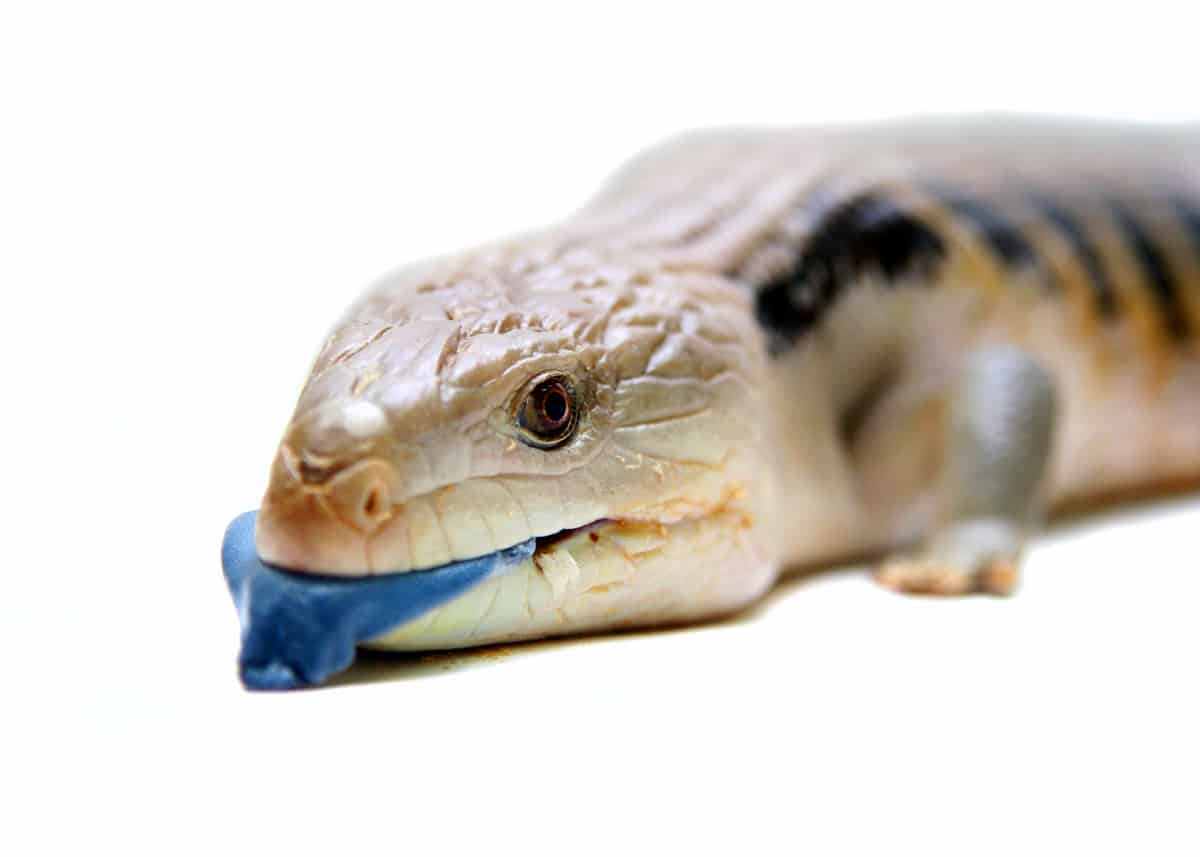
They’ll also flatten their bodies to the ground to make a predator think they’re too big to eat.
38. Flying Snake
- Latin name: Chrysopelea
- Unique weird feature: Ability to glide in the air as far as 300 feet
- Where they’re found: South and Southeast Asia, southernmost China, India, and Sri Lanka
- Size: Length: 2 to 4 feet; Weight: 1 to 2 pounds
- Diet: Lizards, rodents, frogs, birds, and bats
The thought of a flying snake may be terrifying to some people, but this snake isn’t looking to eat you.
And it isn’t actually a “flying” snake. Instead, it glides, and it’s pretty good at it.
Using its rigid scales to climb and launch itself from a tree branch, the flying snake then rocks its head, flattens its abdomen, and moves in a serpentine motion all at the same time.
This produces aerodynamic forces that enable the snake to glide in the air as fast as 26 to 32 feet per second.
Flying snakes are said to be even better gliders than flying squirrels. They can travel as far as 330 feet in a single glide.
Gliding from tree to tree helps these snakes to both capture prey and avoid predators.
39. Horned Viper
- Latin name: Cerastes cerastes
- Unique weird feature: Two scary-looking horns on its head
- Where they’re found: North Africa and the Middle East
- Size: Length: 12 to 33 inches
- Diet: Rodents, birds, and lizards
One look at this snake with its two prominent horns on top of its head brings to mind traditional illustrations of the devil.
In reality, the horned viper is just a snake that only wants to eat rodents, mate, and sleep.
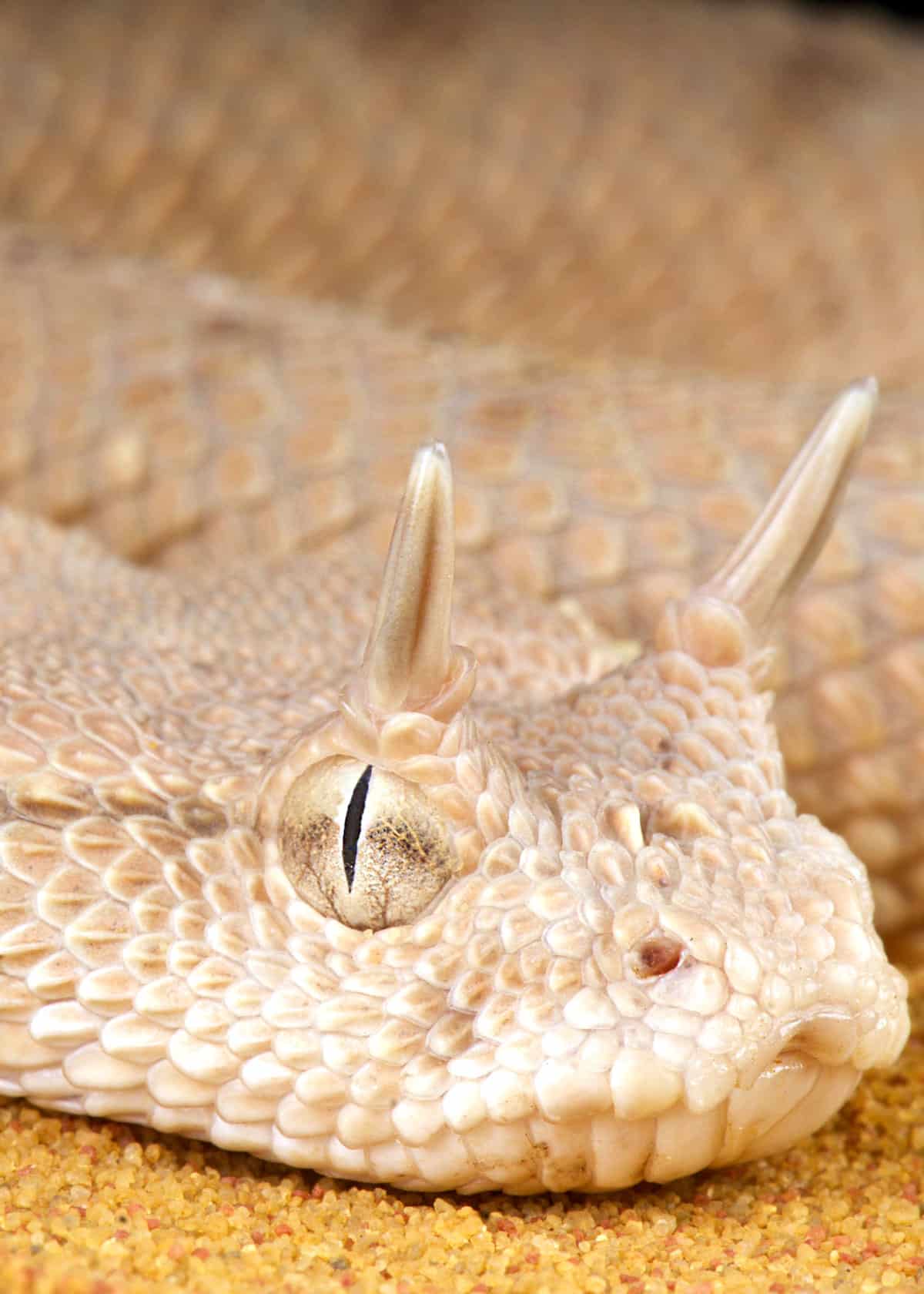
Its scary-looking horns are there to protect the snake’s eyes as it slides sideways in the sand.
Since the horned viper inhabits stony and semi-arid deserts, the snake can be anywhere from brown to gray, yellow or reddish pink.

The horned viper has fangs that produce a venom consisting of 13 different toxins that it uses to kill its prey.
This snake is ecologically important because it controls the rodent population.
40. Matamata Turtle
- Latin name: Chelus fimbriata
- Unique weird feature: Long neck with barbels
- Where they’re found: South America
- Size: Length: 16 to 18 inches; Weight: Up to 33 pounds
- Diet: Fish and aquatic invertebrates
The mata mata (or matamata) turtle is probably one of the weirdest turtles you’ll ever see.
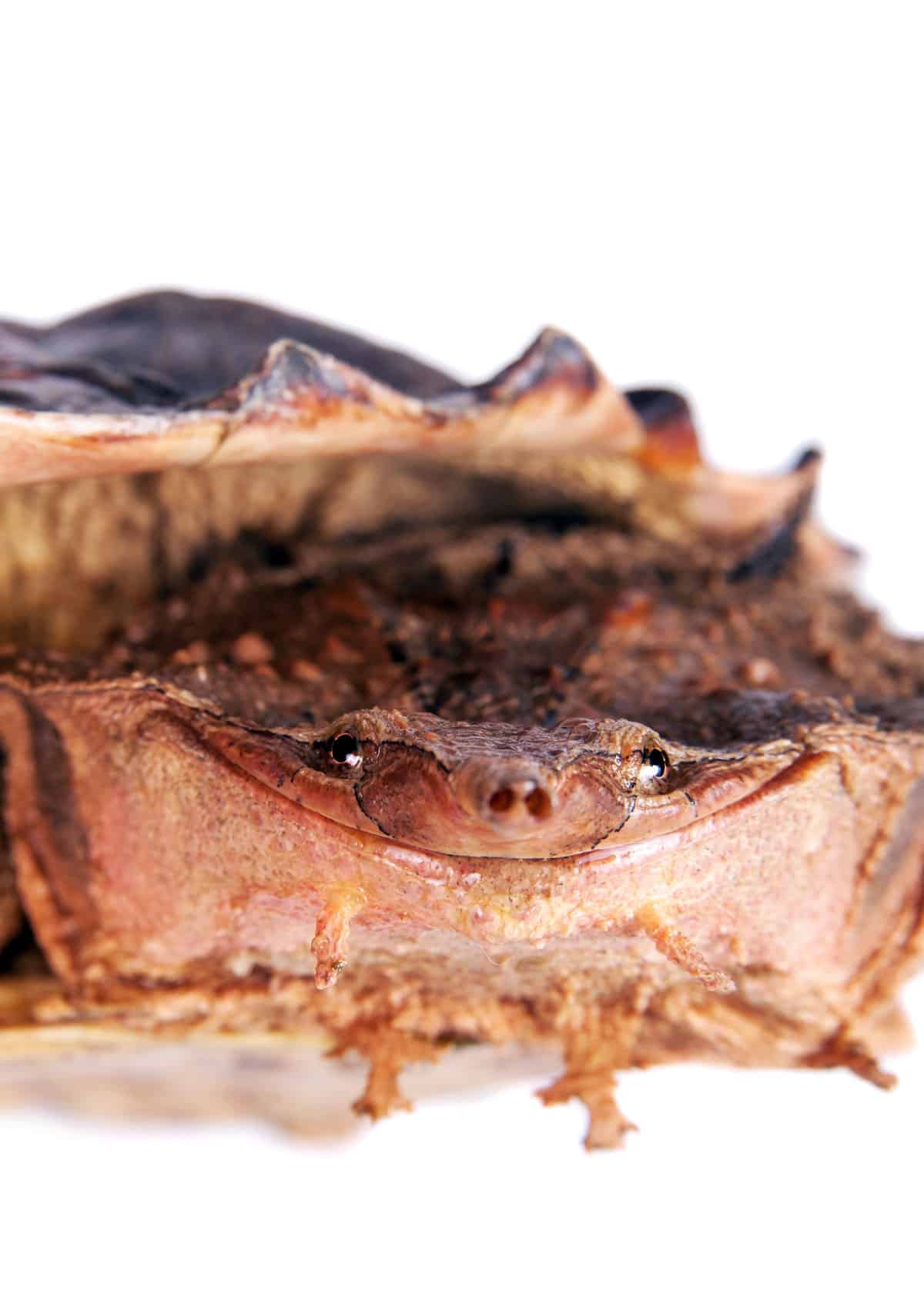
The shell and feet look pretty normal, but the long neck and flattened, triangular head feature ragged skin flaps and barbels.
These help it blend inconspicuously into the leaf litter of shallow, freshwater streams and marshes where it lives among the Amazon and Orinoco basins of South America.
This turtle doesn’t like to move around much. It mostly stays motionless with its snout barely above the water surface as it waits for its dinner to come to it.
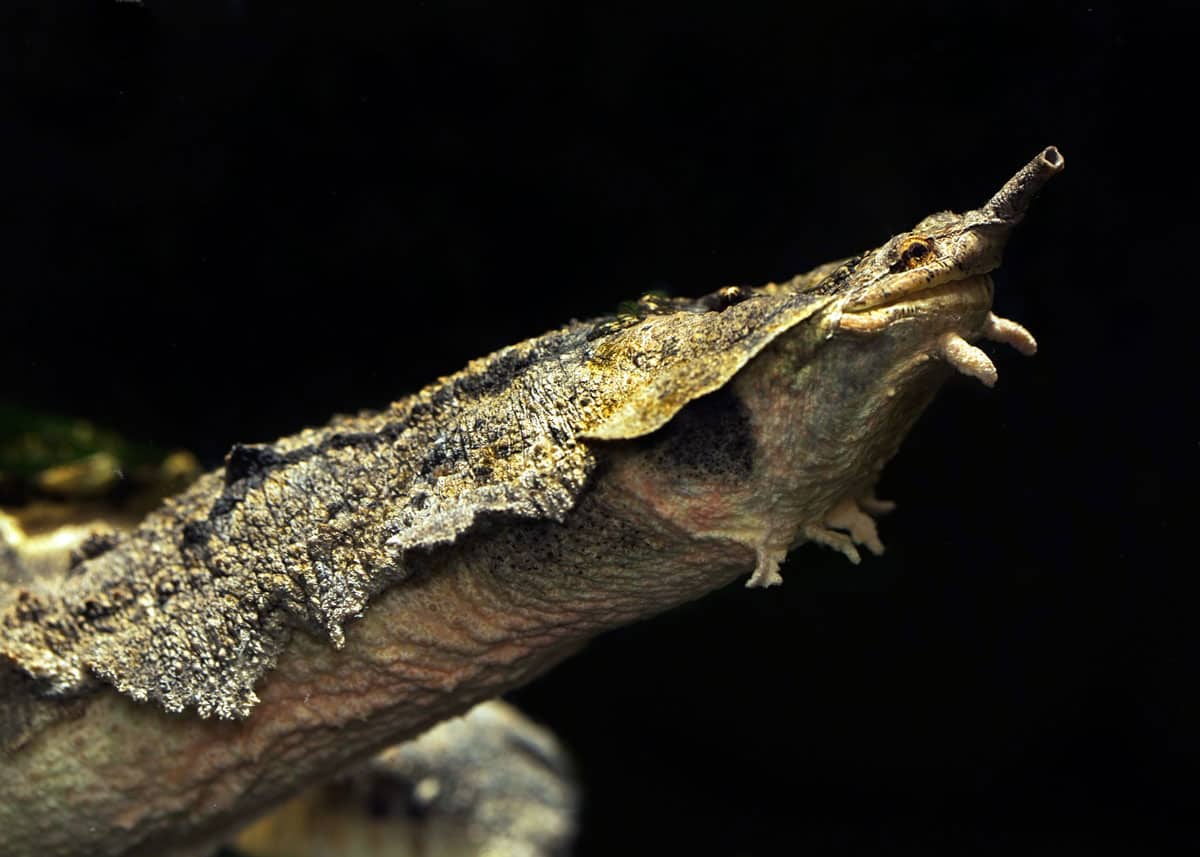
When a fish or aquatic invertebrae comes swimming near it unawares, the turtle simply opens its large mouth and suctions the prey inside like a vacuum.
The matamata cannot chew, so it closes its mouth and swallows the prey whole.
Weird Bugs, Insects, & Arachnids
41. Giant Katydid
- Latin name: Stilpnochlora couloniana
- Unique weird feature: World’s largest katydid
- Where they’re found: Cuba
- Size: Length: Up to 6 inches: Wingspan: 9.8 inches
- Diet: Leaves, flowers, plant stems, fruits, and other insects
Did Katy, or didn’t she? It’s a secret only this family of Tettigoniidae knows.
Like all katydids, the giant katydid gets its name from the “Katy did-Katy didn’t” sound it makes by rubbing its wings together.

The giant katydid is the largest of all the katydids.
This katydid also has antennae that are longer than the length of its body that it uses to locate food and attract a mate.
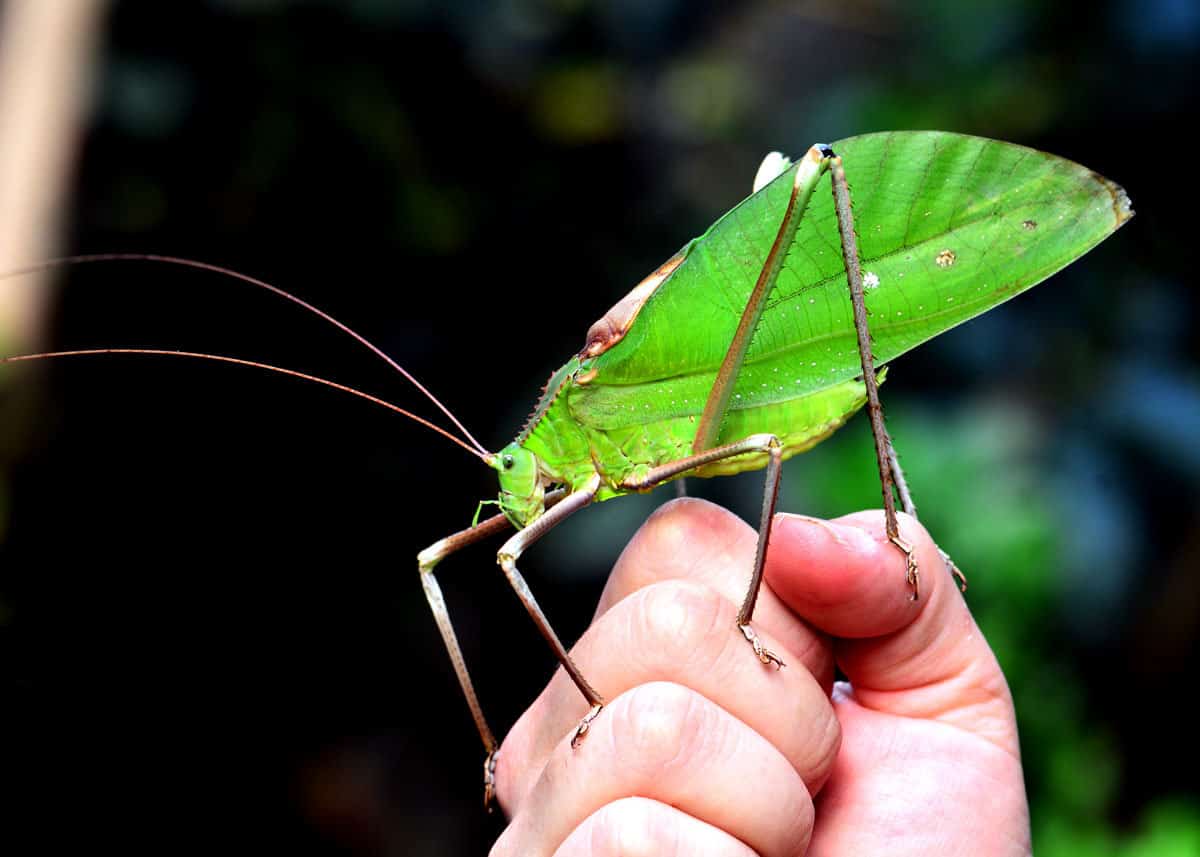
This katydid doesn’t jump or fly very well. Instead, it remains stationary most of the time on plant leaves where its green color provides camouflage.
42. Sparklemuffin
- Latin name: Maratus jactatus
- Unique weird feature: Multicolored and does a fancy dance
- Where they’re found: Eastern Australia
- Size: Length: Less than a quarter of an inch
- Diet: Crickets and other spiders
Have you seen my cute, little sparklemuffin? It’s wearing a tie-dyed cap and hippie shades, and it loves to do the boogie-woogie dance.
Believe it or not, I am talking about a spider.
A member of the peacock spider family, the sparklemuffin is one of the most recently discovered of its kind in eastern Australia.
Like all peacock spiders, the male sparkelmuffins are noted for their vibrant red, blue and purple colors and their unique dance that involves fancy leg work and booty-shaking.
For the male, having all the right moves isn’t enough to just attract a mate. It means survival because if he doesn’t perform well enough to impress a female, she eats him.
43. Devil’s Flower Mantis
- Latin name: Idolomantis diabolica
- Unique weird feature: Changes its appearance into a wildflower
- Where they’re found: Eastern Africa
- Size: Length: 4 to 5 inches
- Diet: Flying insects like flies, beetles, butterflies, and moths
All praying mantises are fascinating creatures, but the devil’s flower mantis is even more so. When it’s content and happily searching for its supper of flies and butterflies, it blends in with the green plants of its habitat.
However, if you scare it, you’ll be amazed when it suddenly changes into a colorful wildflower.
How does it do that? The devil’s flower mantis has multicolored flaps that usually stay hidden when at ease, but when threatened, open up to reveal pretty colors to make a predator think it’s only a flower and not a tasty meal.
By the way, a young, immature devil’s flower mantis is brown and takes on the appearance of a dead leaf.
44. Japanese Giant Hornet
- Latin name: Vespa mandarinia japonica
- Unique weird feature: Huge hornets that kill honeybees by the thousands at one time
- Where they’re found: Native to Japan
- Size: Length: 1.6 to 1.8 inches; Wingspan: 2.4 inches
- Diet: Honey bees, wasps, praying mantises and other insects
A subspecies of the world’s largest hornet species, the Asian giant hornet, the Japanese giant hornet is one bug you really want to avoid because its venomous sting could put you in the hospital.

Fortunately, this hornet is more interested in honeybees than humans. While it preys upon other insects, honeybees are it’s favorite.
Yellowish-orange with black stripes, Japanese giant hornets are aggressive creatures that seek out beehives and massacre the adult bees in order to eat their larvae.
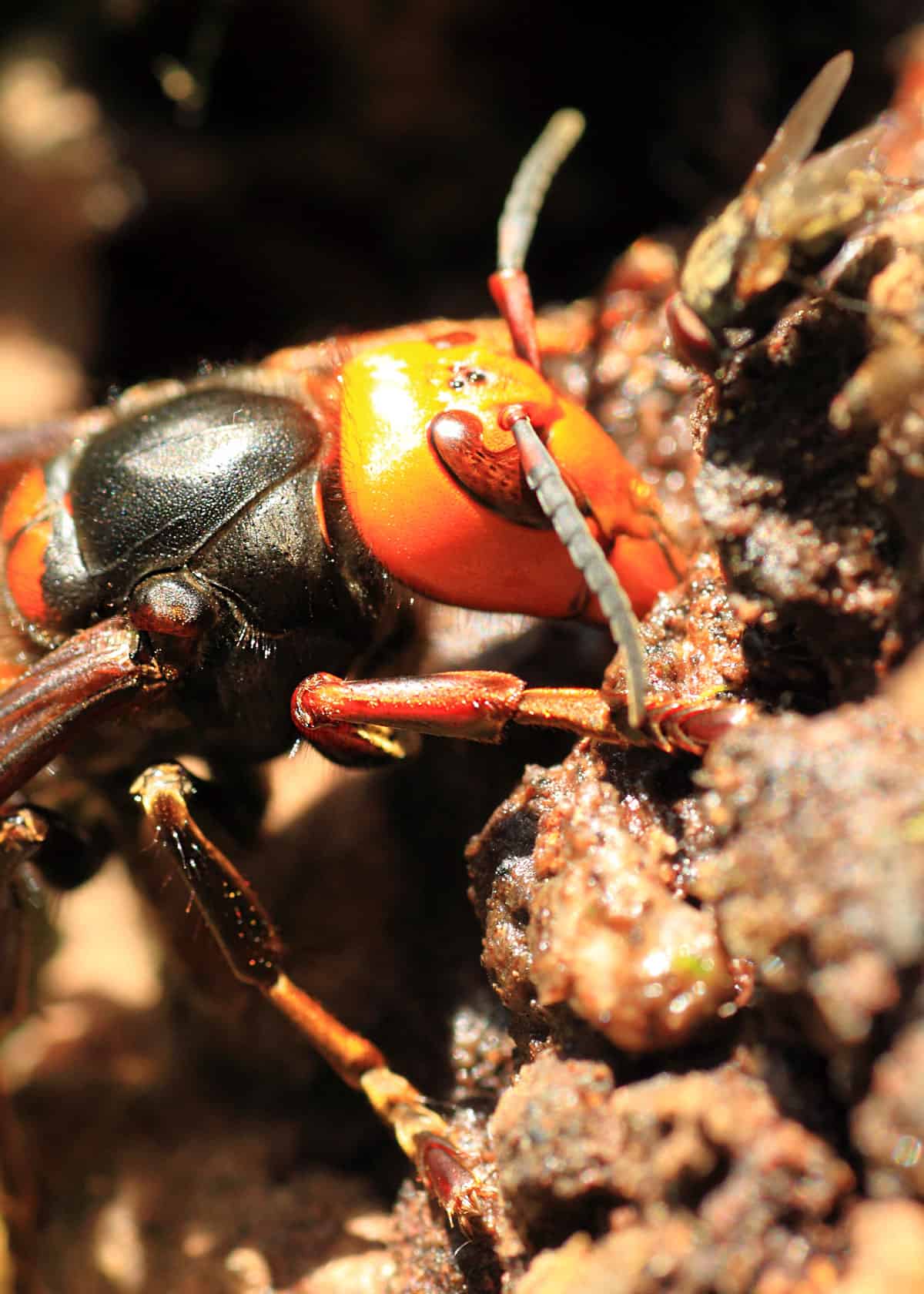
Several hornets can kill thousands of bees in just a couple of hours.
Once they eat the baby bees, they make a paste of them which they then feed to their own baby hornets.
45. Milkweed Assassin Bug
- Latin name: Zelus longipes
- Unique weird feature: Blood-sucking insect with venomous saliva
- Where they’re from/found: Southern North America, Central America, and South America
- Size: Length: 0.5 to 1.5 inches
- Diet: Blood of other insects (and sometimes humans)
A member of the assassin bug family that’s also called “kissing bugs,” these vicious little buggers are the mafia of the insect world.
Milkweed assassin bugs are out for blood whether it be that of other insects or even humans.
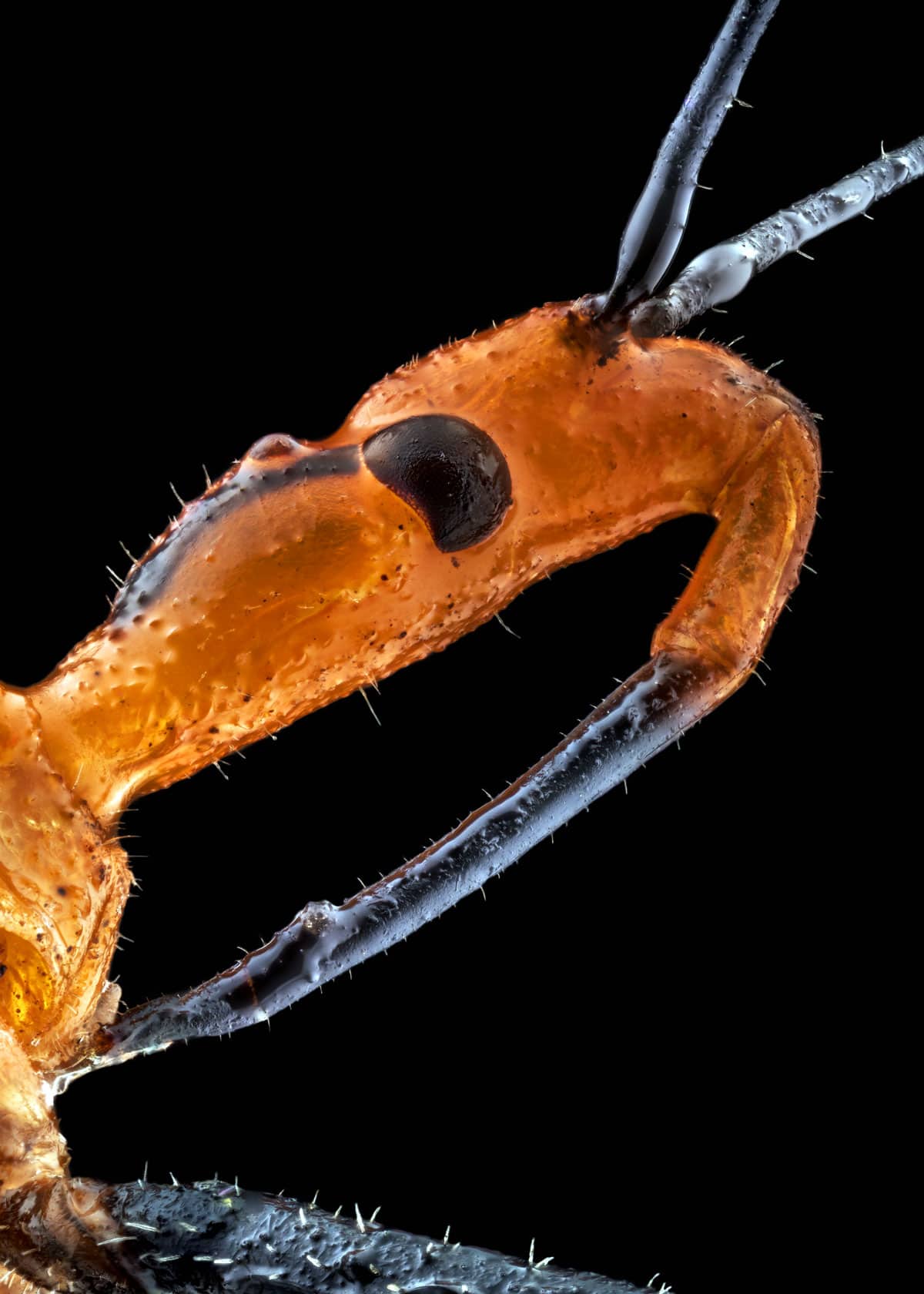
They breed by laying their eggs in their hosts.
Their stinging bite punches venomous saliva that kills its prey within seconds.
The saliva doesn’t kill humans but can spread a serious infectious illness known as Chagas disease.

Identified by their red body and long black legs and antennae, this milkweed species is welcomed by gardeners because it kills plant-eating insects such as aphids, armyworms and stink bugs.
46. Honeypot Ant
- Latin name: Myrmecocystus
- Unique weird feature: Use their bodies as honey storage pots
- Where they’re found: Deserts of Africa, Australia, and North America
- Size: Length: 0.25 to 0.50 inches
- Diet: Flower nectar and sweet plant juices
Honeypot ants use their own bodies as storage units to provide a food source for their families. They even resemble tiny jars of honey.
Each colony has two different types of ants, workers and storage ants, which both go out to feed on flower nectar and sugary plant juices.
The worker ants then return to the nest to feed the other members and larvae by regurgitating the juices.
The storage ants, on the other hand, engorge themselves with food so that their bodies swell up, resembling honey pots.
They then hang onto the ceiling of their nests until times when food is scarce. Hungry members stroke the antennae of the storage ants which then regurgitate the stored food.
47. Strawberry Crab
- Latin name: Neoliomera pubescens
- Unique weird feature: Bright red with white dots (like a strawberry)
- Where they’re found: Indo-Pacific region (Hawaii, French Polynesia, Mauritius)
- Size: Width: 2 inches
- Diet: Algae (but also aquarium food)
The strawberry crab is unique because, well, how often do you see a bright, reddish-pink crab dotted with white spots just like a strawberry? Native to the Pacific waters of Hawaii, this fella is also called the Hawaiian strawberry crab as well as the red boxing crab.
This peace-loving creature gets along well with fish and most other invertebrates which is why it’s a popular aquarium pet. Plus, it helps to keep an aquarium clean because it eats blooming algae.
48. Long-horned Orb Weaver Spider
- Latin name: Macracantha arcuata
- Unique weird feature: Extremely long antennae that resemble horns
- Where they’re found: India, Borneo, and China
- Size: Length: 1 inch
- Diet: Small insects such as flies, moths, mosquitoes, and beetles but also frogs and hummingbirds
The long-horned orb weaver spider looks like something from another planet. It has a yellow back with eight eyes and eight hairy legs.

But what really makes it look otherworldly is its extremely long antennae that stand straight up like the antenna of an old-fashioned television.
Scientists aren’t really sure of the purpose of the “long horns,” but it could be simply to intimidate predators. Or they’re just trying to show off.
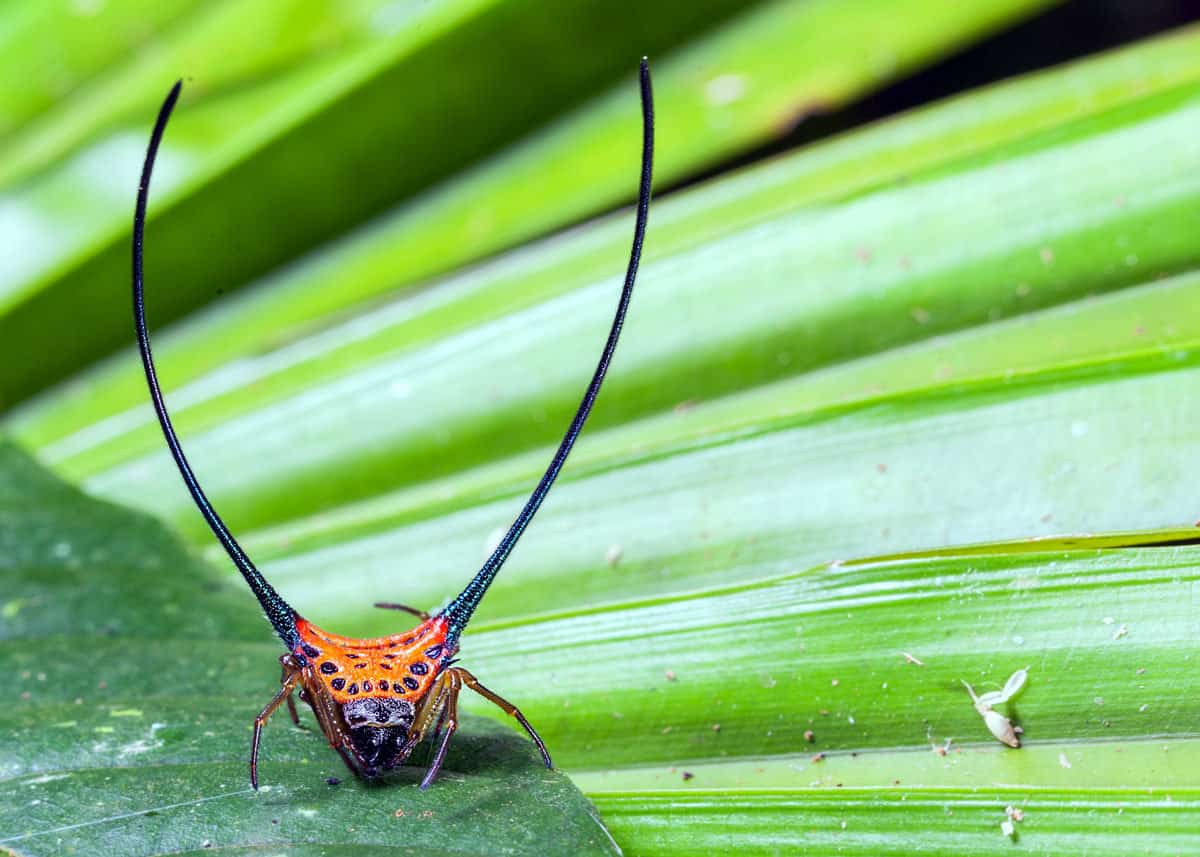
A member of the orb weaver spiders, this spider is an amazing engineer that spins intricate, wheel-shaped webs that are often found in fields, forests, and gardens of China, Borneo and India.
49. Mukade Centipede
- Latin name: Scolopendra subspinipes
- Unique weird feature: Extremely long centipede with a venomous bite
- Where they’re found: Japan
- Size: Length: Up to 8 inches
- Diet: Insects and arachnids (like spiders and scorpions) but also mice and small reptiles
A symbol of evil in Japan and a traditional source of food for indigenous peoples in Australia, the mukade centipede is a really long (up to 8 inches) centipede that can sometimes end up in your house if you live within its range.
You’ll know the mukade by its reddish-brown body that is made of 21 segments that each correspond to a pair of yellow legs.
The mukade is an aggressive predator that normally eats insects and spiders, but it won’t think twice about trying to take on larger prey like mice and small reptiles.
It has a venomous bite that kills its prey and is painful to humans.
50. Scorpionfly
- Latin name: Mecoptera
- Unique weird feature: A tail like a scorpion stinger
- Where they’re from/found: Worldwide
- Size: Length: 0.1 to 1.4 inches
- Diet: Dead insects, rotting fruit, bird droppings
The scorpionfly doesn’t really have a stinger like a scorpion. It just wants predators to think that so they will stay away.
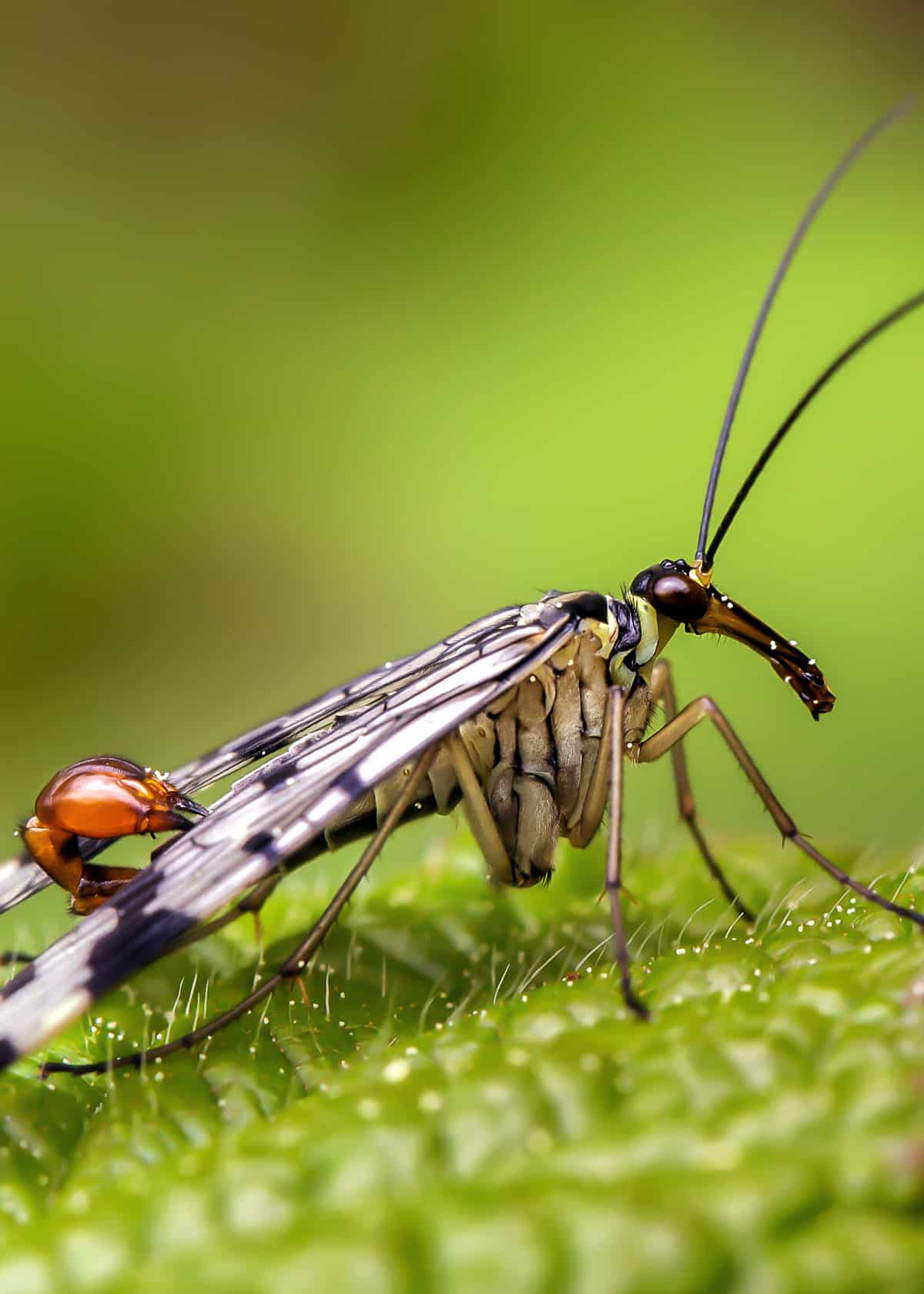
In reality, that sinister, scorpion-like tail is the males… mating apparatus. Otherwise, the scorpionfly looks like a regular fly.
Scorpionflies love eating dead stuff including human corpses.
They even lay their eggs in them! This fact helps forensic scientists to determine how long a person has been dead.

Scorpionflies have a strange mating ritual in which the male offers the female a dead insect as a gift.
If she approves the gift, she will eat it while mating. If she rejects it, she spurns the male.
51. Hummingbird Hawk-moth
- Latin name: Macroglossum stellatarum
- Unique weird feature: Resembles a hummingbird
- Where they’re found: Southern Europe, North Africa, and Asia
- Size: Length: 2 to 2.5 inches; Wingspan: 2 to 6 inches
- Diet: Nectar-rich flowers
Is that a bug or a bird? You might ask that when you see a hummingbird hawk-moth. This bug is a hummingbird copycat.

Except for its six legs and two antennae, it looks just like the tiny bird. Not only does it hover from flower to flower just like a hummingbird, but it even prefers the same flowers as the bird.
Also like a hummingbird, this moth can move sideways and backward and makes the same buzzing sound with its rapid wingbeat.

By the way, it has a wingbeat of about 70 beats per second and can fly up to 12 mph.
52. Japanese Spider Crabs
- Latin name: Macrocheira kaempferi
- Unique weird feature: Super long, spider-like legs
- Where they’re found: Japan (especially Honshu Island) and the coasts of the Pacific Ocean
- Size: Body width: 16 inches; Leg span: 18 inches; Weight: Up to 44 pounds
- Diet: Shellfish, dead fish, kelp, algae
It’s not really a spider at all, but this Japanese spider crab has super long legs that resemble a spider. In fact, it has the largest leg span of all arthropods, reaching up to 18 feet wide from claw to claw. It uses these long legs to scurry across the ocean floor.
Despite its creepy appearance, it’s reported to have a sweetheart personality. But, you don’t want to get on its bad side because its powerful claws are capable of causing serious injury.
You aren’t likely to stumble across one of these crabs because they only live in the Pacific Ocean off Japan at depths between 400 and 900 feet.
53. Orchid Mantis
- Latin name: Hymenopus coronatus
- Unique weird feature: Changes its appearance into an orchid flower
- Where they’re found: South-East Asia (Malaysia, Myanmar, Thailand and Indonesia)
- Size: Length: 2 to 4 inches
- Diet: Small insects, crickets, flies, fruit flies, beetles and stinging bugs like bees as well as other praying mantises
Found in countries of southern and eastern Asia, the orchid mantis is truly a master of disguise.
It’s a praying mantis that looks exactly like the beautiful, pink and white orchid flower.
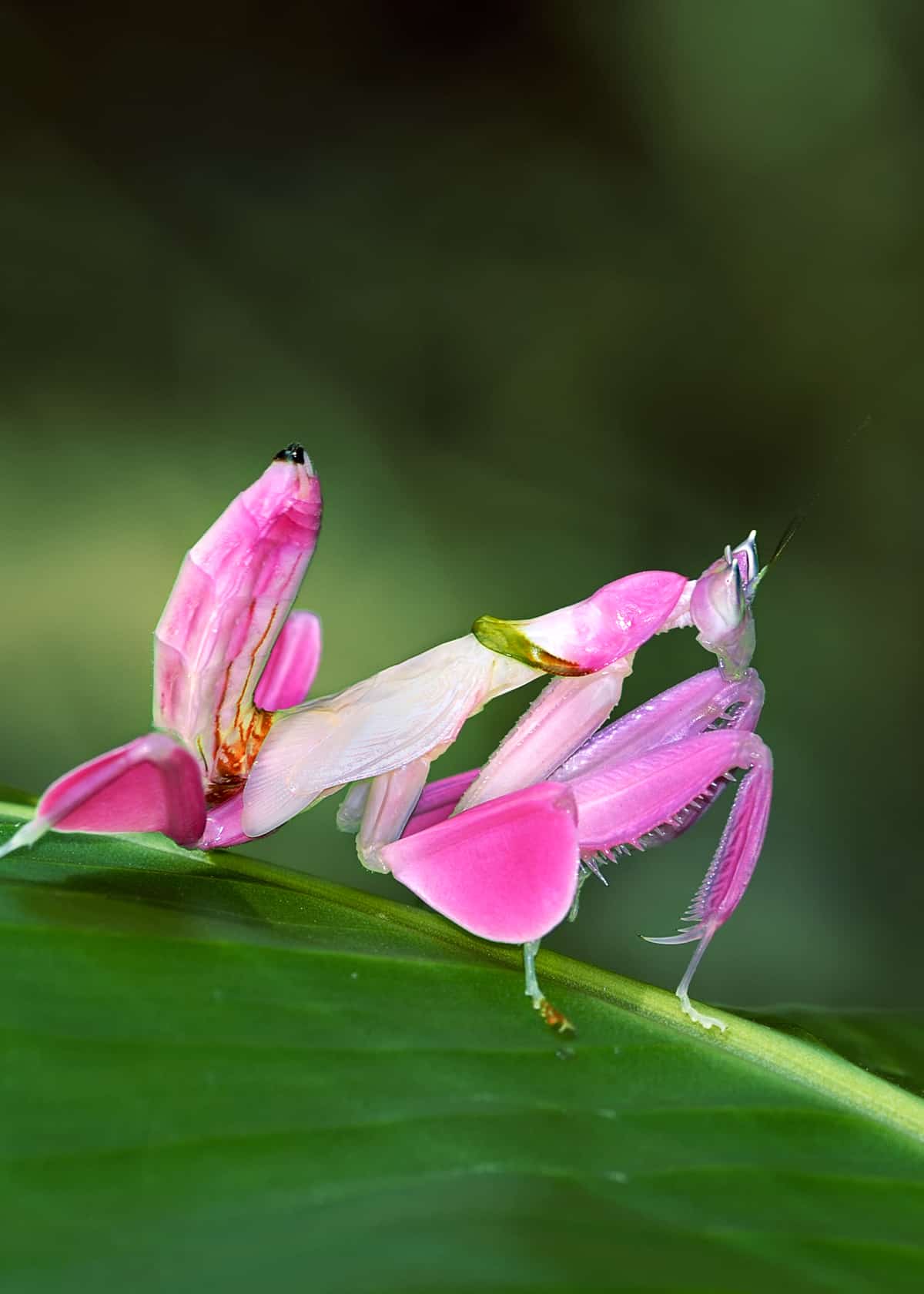
Even its legs resemble flower petals. How cool is that?
There’s an ingenious dual function for this bug’s clever mimicry: It makes predators think it’s a flower, and it attracts prey.

The orchid mantis is so good at its disguise that it attracts more flying insects than the actual flower it imitates does.
54. Hickory Horned Devil
- Latin name: Citheronia regalis
- Unique weird feature: Long, green caterpillar with red horns
- Where they’re found: Eastern and Southern United States
- Size: Length: 5.9 inches
- Diet: Leaves from trees like walnuts, pecans, filbert, ash, and persimmon
Its name sounds scary and it looks pretty menacing, but the hickory horned devil is really just a harmless, half-foot long caterpillar that’s bright green in color and has black prickly spines and red horns that don’t sting at all.
Its frightening appearance is just a ruse to deter predators.
After its metamorphosis phase, this unusual caterpillar changes into the regal moth, the largest moth living north of Mexico.
Just before it’s time to burrow into its dark cocoon, it gorges itself on plant food because as an adult regal moth, it doesn’t have a mouth to eat at all.
55. Mantis Shrimp
- Latin name: Stomatopoda
- Unique weird feature: Multicolored shells with powerful claws
- Where they’re from/found: Indian and Pacific Oceans
- Size: Length: 3.9 to 15 inches
- Diet: Fish, worms, snails, oysters, mollusks, and crustaceans
Mantis shrimps are the jewels of the ocean with brightly colored shells in hues of red, orange, blue and green.
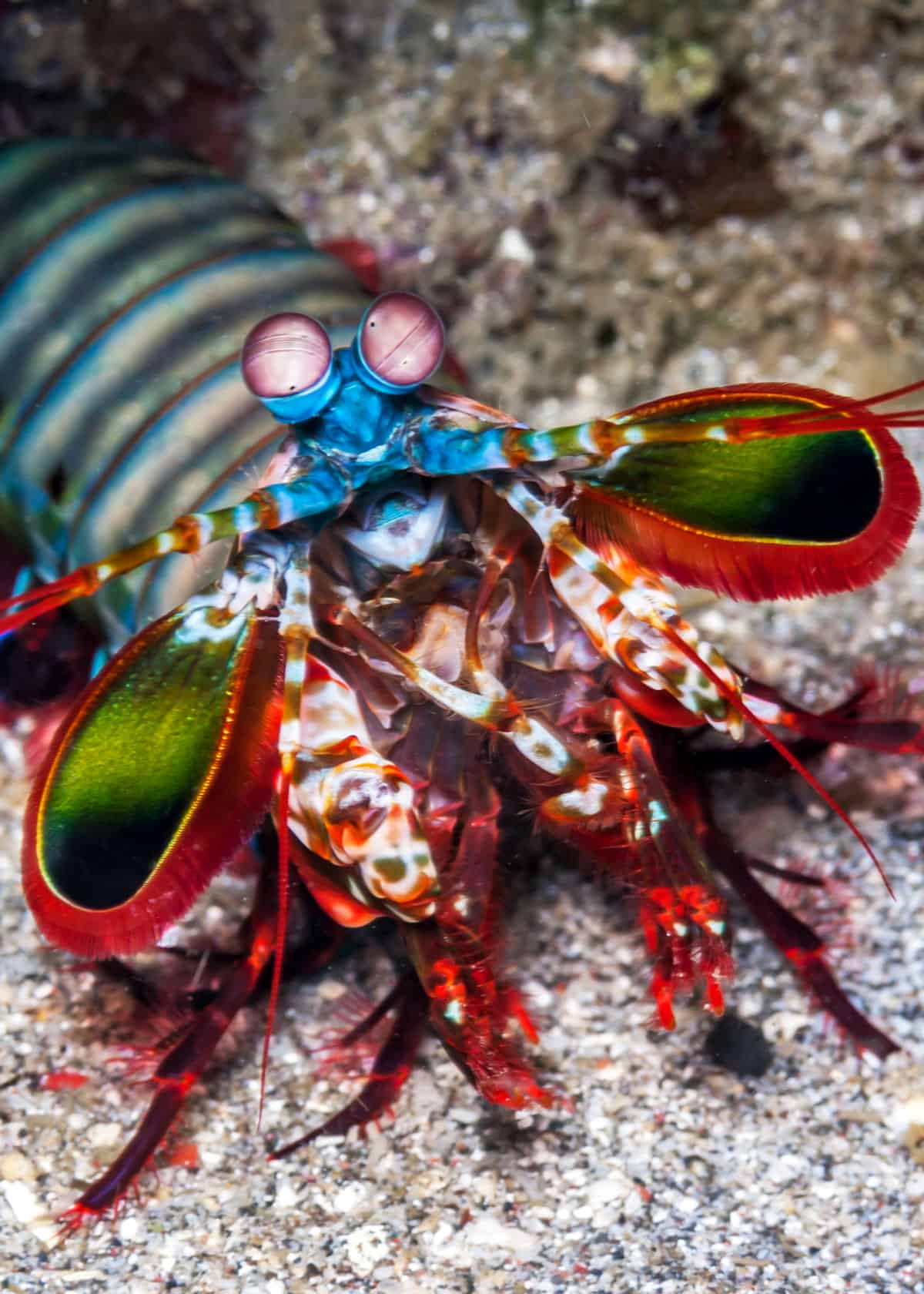
However, looks can be deceiving because these creatures have vicious claws that can spear, smash and dismember fish, worms, mollusks, and crustaceans.
A mantis shrimp attack can occur 50 times quicker than the blink of an eye with the force of a .22 caliber bullet.
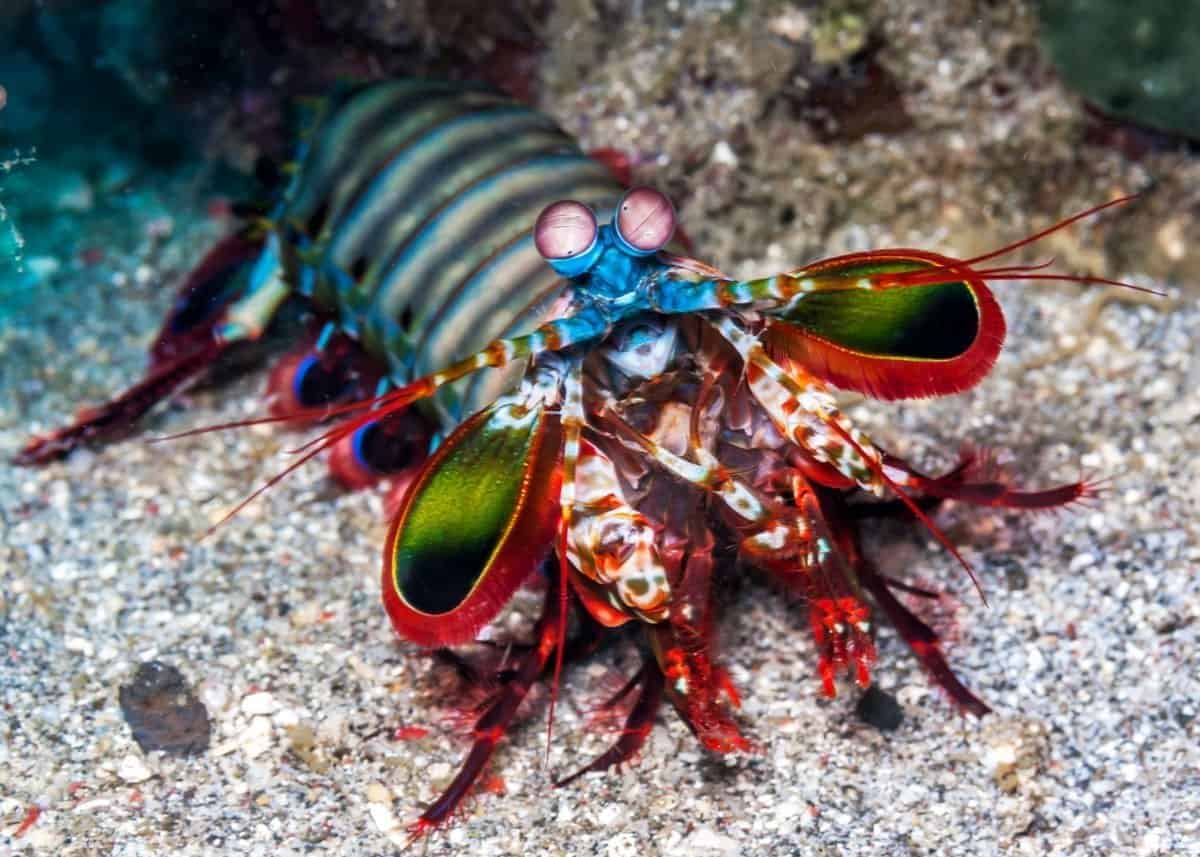
These shrimps have exceptionally complex eyes that give them the ability to see ultraviolet and polarized light. This helps them detect both predators and prey in the ocean.
Some of them mate for life up to 20 years, and they glow during courting rituals.
More Weird Aquatic Critters
56. Red-lipped Batfish
- Latin name: Ogcocephalus darwini
- Unique weird feature: Red lips
- Where they’re found: Pacific Ocean off Peru and around the Galapagos Islands
- Size: Length: Up to 8 inches
- Diet: Small fish, crabs, shrimps, and mollusks
A type of anglerfish, the red-lipped batfish looks like someone who applied makeup without a mirror due to its striking red lips that look as if they’re smeared with lipstick.
That’s not the only unusual thing about this weird fish.
It also has a spiny structure projecting from its head that emits bright light in the deep ocean waters like a beacon to attract a mate and prey.
They’re called batfish because they have fins that resemble bat wings. These fins also enable them to walk across the ocean floor. They actually “walk” more than they swim.
57. Halitrephes Jelly
- Latin name: Halitrephes maasi
- Unique weird feature: Looks like fireworks when illuminated
- Where they’re found: Baja California, Mexico
- Size: Unknown
- Diet: Plankton
Resembling an upturned bowl with spaghetti noodles falling out, the Halitrephes jellyfish floats in the deep ocean rarely unseen by humans.
But, when lights from an ROV (remotely operated underwater vehicle) shone upon the jellyfish in Baja California, Mexico, researchers were amazed at what looked like a burst of underwater fireworks.
Scientists say this jellyfish has spiral canals that move nutrients through its bell-shaped form which were illuminated by the lights of the ROV, making it sparkle and shimmer in a starburst pattern.
58. Sockeye Salmon
- Latin name: Oncorhynchus nerka
- Unique weird feature: Lives in both freshwater and saltwater and changes colors
- Where they’re found: North Pacific Ocean and some landlocked lakes of Canada, USA, and Japan
- Size: Length: Up to 2.9 feet; Weight: 5 to 15 pounds
- Diet: Zooplankton
Sockeye salmon are unique in that they can live in both freshwater and saltwater.
They first hatch from their eggs in freshwater streams and lakes and then migrate to the ocean. At this point, they are bluish in color tinged with silver.
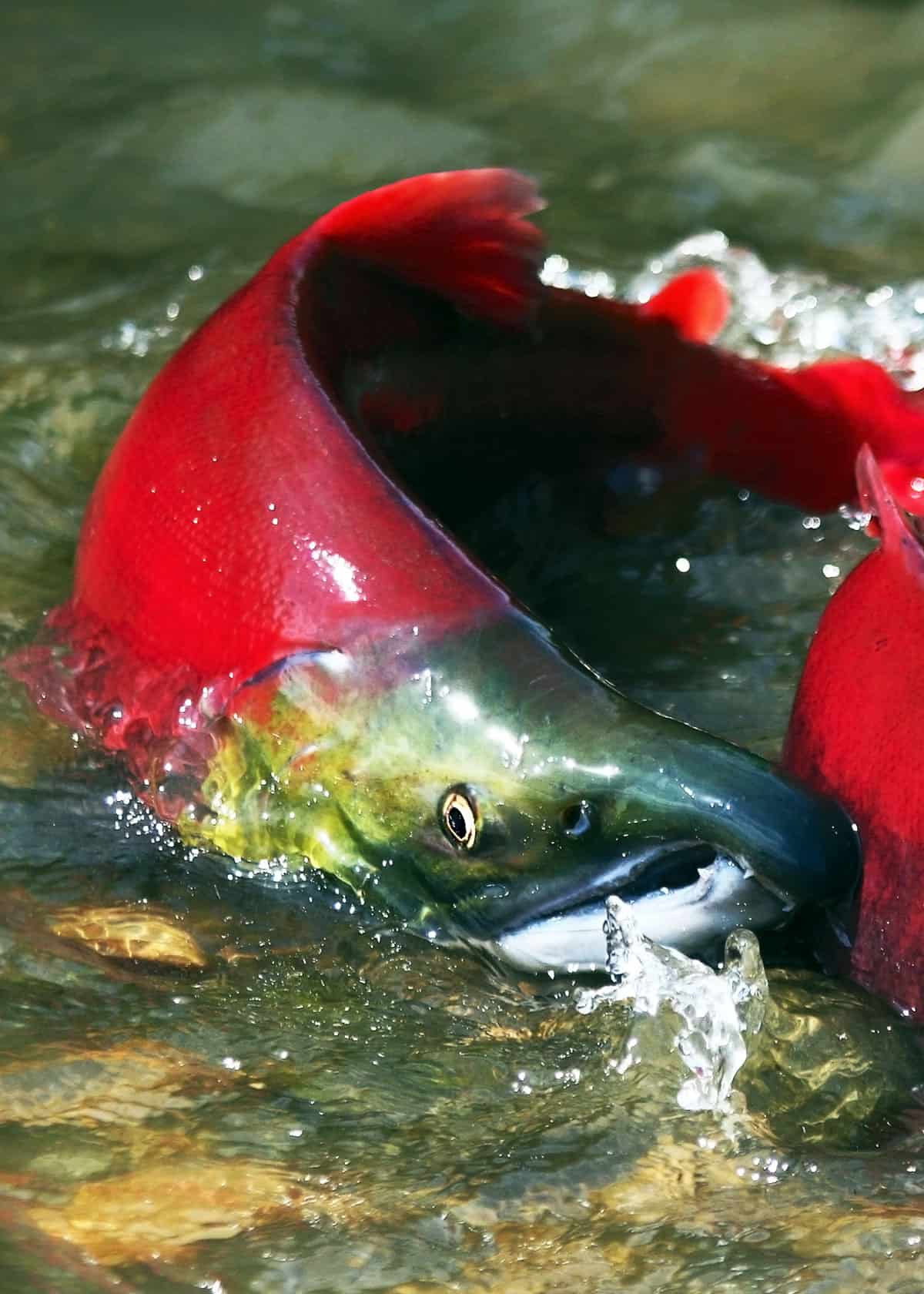
When they’re old enough to reproduce, they swim back to the same freshwater nursery where they themselves were born to spawn their own offspring.

When this occurs, they change in color. Their bodies turn red while their heads change to green. After they spawn, they die, and the new generation repeats the cycle.
59. Vampire Squid
- Latin name: Vampyroteuthis infernalis
- Unique weird feature: Looks like it’s wearing a vampire cape and performs magic tricks
- Where they’re found: Oceans around the world
- Size: Overall length: Up to 1 foot; Body Length: 6 inches
- Diet: Organic debris and dead bodies of animals that fall from the surface
The vampire squid doesn’t drink blood. It feeds on “marine snow, which consists of dead bodies, poop and snot” as Hank Green from SciShow so eloquently puts it.
It gets its name because of its red eyes and eight webbed arms that make it look like it’s wearing a vampire’s cape.
However, this deep-sea squid is really more like a magician. Its gelatinous body is covered in little light-producing organs that are used to attract prey and deter predators.
It’s Latin name, Vampyroteuthis infernalis, literally means “vampire squid from hell.” That’s quite a name…
It has a really neat trick that it performs when it’s threatened. It curls up its arms and wraps them around its body (like a cape) and then turns itself inside out to expose spiny projections.
It can also eject what looks like a puff of blue smoke (bioluminescent mucus) that dazes predators and gives it time to escape.
60. Humpback Anglerfish
- Latin name: Melanocetus johnsonii
- Unique weird feature: Scary teeth and a glowing protrusion on the head
- Where they’re found: Deep parts of Atlantic and Antarctic oceans
- Size: Length: Males (1 inch); Females (7 inches)
- Diet: Small fish, shrimp, small squid and turtle
The humpback anglerfish should not only be on the weird animals list, but also the scary animals list! One look at this brown fish with a large head and enormous jaw, and all you see is a mouth full of long, jagged teeth.
Even scarier is the long, spiny thing protruding from the top of the female’s head. Called an esca, this protrusion has bacteria in it that glows a blue color. Scientists think the female uses this esca as a “fishing lure” to attract prey.
The male is much smaller than the female and depends on her for food by biting her and hanging onto her.
61. Goblin Sharks
- Latin name: Mitsukurina owstoni
- Unique weird feature: Ghostly skin and long, flat nose
- Where they’re from/found: Atlantic, Pacific, and Indian Oceans
- Size: Length: 10 to 13 feet; Weight: Up to 460 pounds
- Diet: Fish, squid, shrimp, crabs
Thank goodness the goblin shark is a rare species that lives only in deep ocean water so that you don’t have to worry about coming face to face with one.
Its translucent skin gives it a ghostly complexion, but it’s the long, flattened snout that really freaks people out.
Much still remains a mystery about this shark, but one known fact is that its massive jaws can protrude at a speed of 10 feet per second at a 111-degree angle and devour prey in the blink of an eye.
62. Blue Glaucus (Glaucus atlanticus)
- Latin name: Glaucus atlanticus
- Unique weird feature: Beautiful two-toned coloration and “feathery” appendages
- Where they’re found: All the world’s oceans
- Size: Length: 1.2 inches
- Diet: Portuguese man o’ war and other jellyfish
Beautiful usually isn’t a word that comes to mind when you think about slugs, but the blue glaucus is a stunning creature.
Also called a blue angel and blue dragon, this sea slug has six appendages that each branch out into feathery-looking fingers, making it look more like an underwater bird-of-paradise.
It has a two-toned coloration that protects them from predators as it floats on the ocean surface. One side of the slug is blue like the sky and the other side is silver to reflect the water surface.
Blue glaucus feed on Portuguese man o’ war, consuming and storing up their stinging cells for its own defense use.
These slugs are hermaphrodites (having both female and male genitalia), and after mating, both individuals produce fertilized eggs.
63. Ocean Sunfish
- Latin name: Mola mola
- Unique weird feature: Large, flat shape
- Where they’re from/found: Every ocean in the world
- Size: Length: 5.9 to 10 feet; Weight: 545 to 5,000 pounds
- Diet: Small fish, fish larvae, squid, crustaceans, jellyfish, and salps
One of the world’s largest bony fishes, the ocean sunfish is larger than an average-sized car.
However, it has a flattened body that’s as tall as it is long, giving it the Latin name, mola, which means “millstone.”
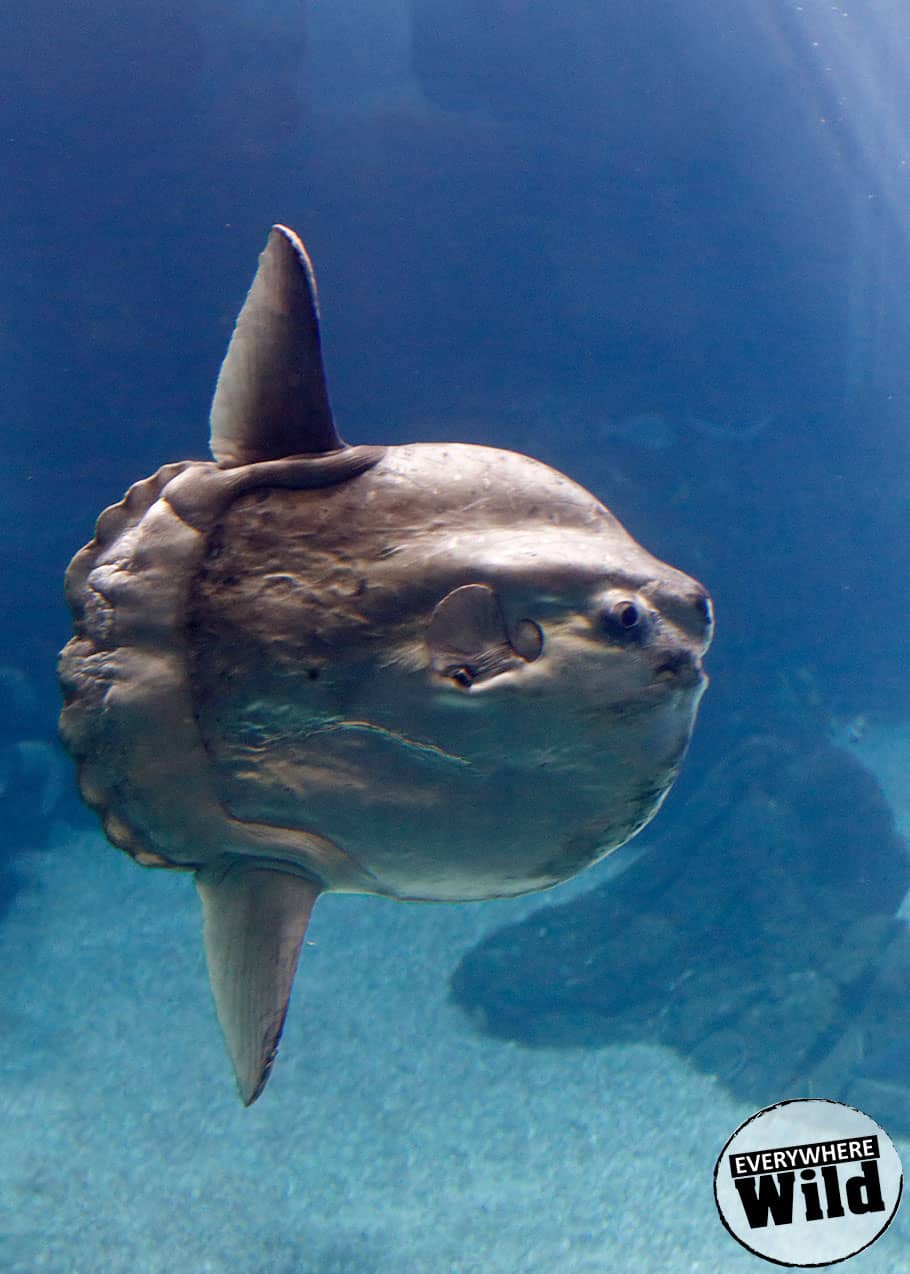
It’s called a sunfish because it prefers to stay near the water surface, sunbathing. Its dorsal fin sometimes alarms people who mistake it for a shark.
Female ocean sunfish lay more eggs at one time than any other vertebrate which can be a whopping 300 million eggs.
64. Dumbo Octopus
- Latin name: Grimpoteuthis
- Unique weird feature: Two large fins that look like “Dumbo” ears
- Where they’re found: Worldwide
- Size: Length: 7.9 inches to 5.9 feet
- Diet: Crustaceans, bivalves, worms, and squid
The Dumbo octopus is one of the cutest creatures in the sea. Unfortunately, you won’t ever see them unless it’s in a giant aquarium because they live deeper in the ocean than most other octopuses.
They’re named after the famous large-eared, Disney elephant because they have two large fins that look like giant ears. These fins help the octopus to propel itself and swim in different directions.
When threatened, the dumbo octopus can change colors to either red, pink, brown, or even invisible.
In reproduction, males have a sperm packet which they offer to the female. She stores the sperm until she feels its the right time to fertilize her eggs.
65. Giant Oarfish
- Latin name: Regalecus glesne
- Unique weird feature: Long, ribbon shape
- Where they’re found: Worldwide
- Size: Length: 9.8 to 56 feet; Weight: Up to 600 pounds
- Diet: Frill, small fish, squid, small crustaceans
The ocean sunfish was mentioned above as being among the world’s largest bony fishes, but the giant oarfish is the king of them all in size.
The average giant oarfish measures about 12 feet in length, but they can grow much longer and weigh up to 600 pounds.
It’s believed that the giant oarfish is the culprit responsible for many historic tales of sea serpents because of its wavy ribbon shape and the way it undulates in the water.
Silver in color with red fins, the giant oarfish is nothing to fear because it doesn’t even have real teeth. It has gill rakers that it uses to eat crustaceans and small fish.
66. Pacu Fish
- Latin name: Serrasalmidae
- Unique weird feature: Human-like teeth
- Where they’re from/found: Amazon Region
- Size: Length: 12 to 30 inches; Weight: Up to 50 pounds
- Diet: Small fish, snails, insects, and decaying vegetation
The pacu fish is often confused for a piranha because of the way it looks, but peek into its mouth and you’ll see a huge difference.
While piranhas have razor-sharp teeth, pacu fish have teeth that look freakishly like human teeth.
There has been a shocking (and mildly amusing) rumor spread around about the pacu fish that is not true. According to a popular myth in Brazil where this fish species lives, pacu fish ate the testicles of two fishermen.
This myth is entirely false and was born from a statement made about pacu eating nuts. However, the only nuts that pacu fish eat are those that fall into the water from trees.
67. Giant Pink Slug
- Latin name: Triboniophorus aff. graeffei
- Unique weird feature: Hot pink in color
- Where they’re found: Mount Kaputar, Australia
- Size: Length: 8 inches
- Diet: Algae, moss
Hot pink in color, the giant pink slug looks like a big glob of wet chewing gum, but you don’t want to eat it because, well, why would you want to eat a slug anyway?!
But if you need another incentive not to eat squishy slimy slugs, there aren’t very many of these. In fact, they only live in one place in the whole world, and that’s at the top of Mount Kaputar in Australia.
These colorful slugs are nocturnal. At night, hundreds of them climb up gum trees to eat moss and algae growing on the tree trunks. During the day, they hide in the pink camouflage of the gum leaves.
Giant pink slugs are important to their ecosystem because they help plants grow by breaking down leaf litter into nutrient-rich soil. They’re also a food source for birds and other animals.
68. Blobfish
- Latin name: Psychrolutes marcidus
- Unique weird feature: Looks like a blob of jelly
- Where they’re from/found: Australia, Tasmania, New Zealand.
- Size: Length: 12 inches
- Diet: Crustaceans like shellfish, crabs, and sea urchins
Pour out a jar of jelly into one huge blob. Put two small eyes, a swollen nose, and a deep frown on it. Now, you have yourself a blobfish.
Seriously, that is what this poor fish looks like when it’s brought to the surface because it has no bones or muscles.
Yet, in its natural habitat at about 3,000 feet deep on the ocean floor, the water pressure enables the blobfish to retain its “fish” shape.
Blobfish don’t have teeth, either, so they just float around on the ocean floor, feeding on whatever food they can suck up into their mouths like crabs and sea urchins.
Mom and Dad blobfish sit on their eggs on the ocean floor to protect them from predators.
69. Giant Isopod
- Latin name: Bathynomus giganteus
- Unique weird feature: Largest isopod
- Where they’re from/found: Atlantic, Pacific, and Indian Oceans
- Size: Length: 7.5 to 14.2 inches
- Diet: Dead animals, sponges, trawl catches
It looks like roly-poly pillbug with a shell, two antennae, and several long, creepy legs.
But the giant isopod is a weird aquatic animal that lives deep in the cold waters of the Pacific, Atlantic and Indian oceans. In fact, it’s the largest of all isopods, growing up to 14 inches in length.
Like a pillbug, they will curl up when threatened. They’re usually seen in either brown or light purple colors. They lay the largest eggs of all marine invertebrates (about 0.50 inch in diameter).
Because giant isopods have a really slow metabolism rate, they often live in semi-hibernation and go for long periods without eating. But, once they do eat, they stuff themselves.
Otherwise, they’re just sitting still and watching the marine world float by.
The Wonderfully Weird!
Woo! Now that’s a lot of weird animals! Which was your favorite? Did I miss one you think I should add to the list? Let me know in the comments, and I’ll see what I can do 😉.
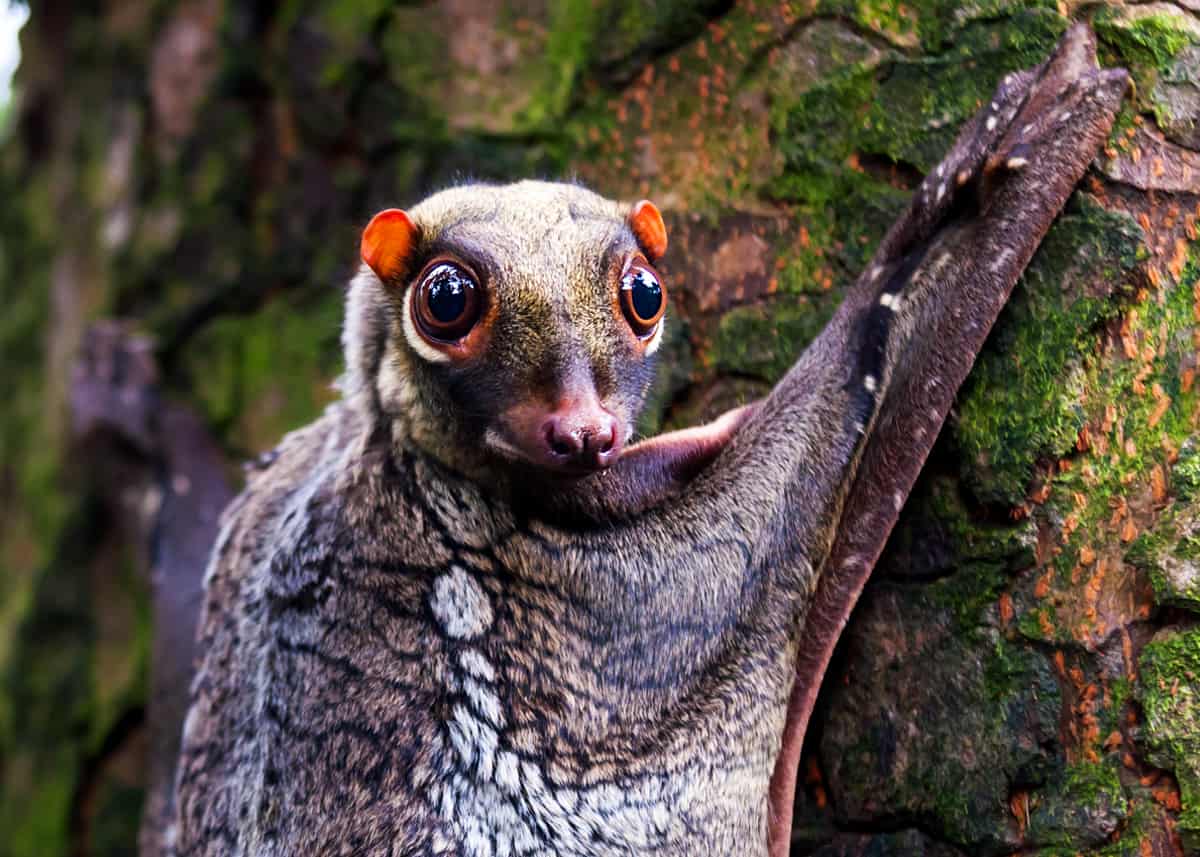
Drew Haines is an animal enthusiast and travel writer. She loves to share her passion through her writing.
She graduated high school at sixteen and started her own business, Everywhere Wild Media. And she runs Everywhere Wild and JustBirding. She also guest blogs on Storyteller.Travel
She lived in Ecuador for 6 years and explored the Galapagos Islands. Currently based in N.S., Canada.

River Otter: Lontra Canadensis – CelestialPets
Thursday 10th of November 2022
[…] swim up to 50 kilometers per day and dive to depths of up to 100 meters. Sea otters are the most fascinating mammal species on the planet, and they can be found in North […]
Sloths In San Francisco: Where To Find Them – MudFooted
Saturday 22nd of October 2022
[…] but they can also move at a very slow pace. South American sloths are the largest and most unique mammals on the planet. Each day, sloths move approximately 40 yards around the tropical rain forests, […]
Henning
Wednesday 28th of July 2021
Hi there, very nice selection that I stumbled across as I was trying to get to the bottom of what I saw today in the Bavarian Forest National Park: tiny, slug-like creatures, each app. 0.5 cm in length, that join together into a formation that from afar looks like a snake or a long worm and that moves with slug-pace and determination - utterly weird and creepy....if you break their formation, they eventually band together again. Never seen this before and can't find any information online. Came across it twice today, once the formation stretched over more than 70cm and was brown in colour, once it was about 20 cm long and black. Happy to post a picture if you let me know where. Also have some (cell phone) videos. Any idea what it could be? Whatever it is, it belongs onto this list :-)
Anonymous
Monday 22nd of February 2021
I loved this! So many weird animals. My favorite was either the Gharial or the mouse deer.
Martin Valkanov
Tuesday 3rd of November 2020
This blog is just SO COOL!! There are som many amazing and strange animals here to learn about!!!